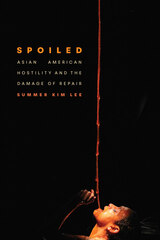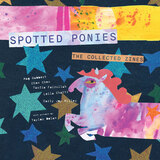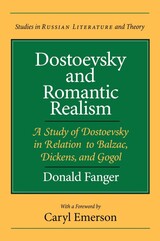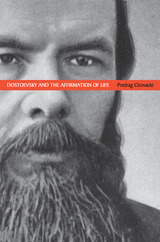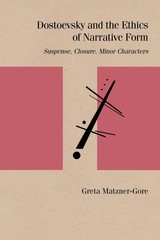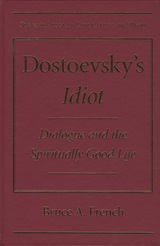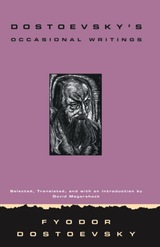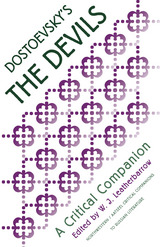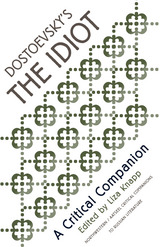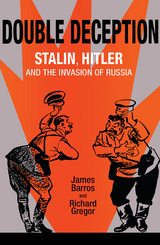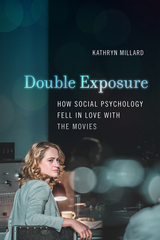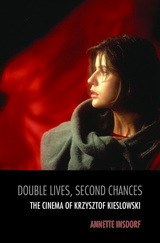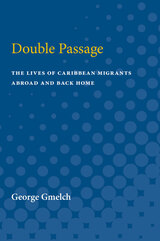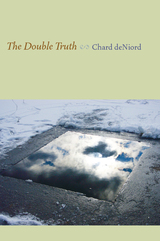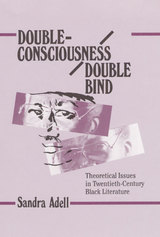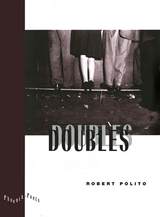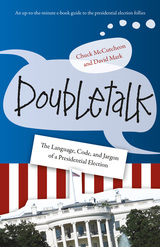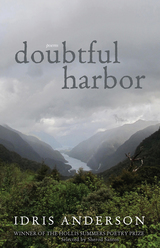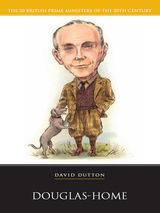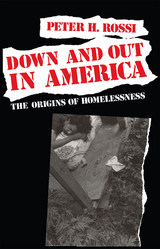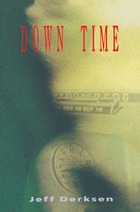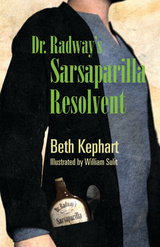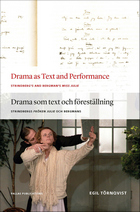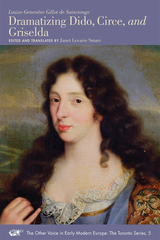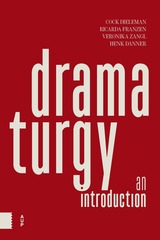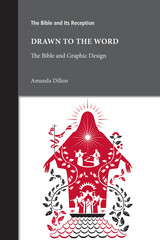 Dostoevsky and The Idiot: Author, Narrator, and Reader
Robin Feuer Miller
Harvard University Press, 1981 The Idiot is perhaps the most difficult and surely most enigmatic of Dostoevsky’s novels. In it the novelist developed a narrator-chronicler who uses an intricate web of alternately truthful and deceptive words to create a narrative of baffling intricacy. The reader is confronted with moral and ethical problems and is forced to make his or her own decisions about the import of what has occurred.
Robin Miller analyzes the varied narrative modes and voices, as well as the inserted narratives, and examines the effects of all these on the reader. She has derived helpful insights from current writing about the phenomenology of reading by such critics as Wayne Booth, Wolfgang Iser, and Stanley Fish. She draws extensively on Dostoevsky’s letters, notebooks, and journalistic writings in describing his ideas about his readers and about the craft of fiction. These writings also provide clues to the importance of Rousseau’s Confessions and the Gothic novels for the development of Dostoevsky’s narrative techniques. The notebooks, moreover, are an indispensable source of information concerning the genesis of The Idiot and the radical changes it underwent in the course of its composition.
Although the book is primarily a close reading of The Idiot, it throws light on the later novels, The Possessed and The Brothers Karamazov, in which Dostoevsky again makes use of a fictional narrator.
Dostoevsky and Romantic Realism: A Study of Dostoevsky in Relation to Balzac, Dickens, and Gogol
Donald Fanger
Northwestern University Press, 1998 Dostoevsky and Romantic Realism is Donald Fanger's groundbreaking study of the art of Dostoevsky and the literary and historical context in which it was created. Through detailed analyses of the work of Balzac, Dickens, and Gogol, Fanger identifies romantic realism, the transformative fusion of two generic categories, as a powerful imaginary response to the great modern city. This fusion reaches its aesthetic and metaphysical climax in Dostoevsky, whose vision culminating in Crime and Punishment is seen by Fanger as the final synthesis of romantic realism.
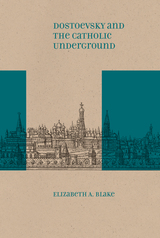 Dostoevsky and the Catholic Underground
Elizabeth A. Blake
Northwestern University Press, 2014 While Dostoevsky’s relation to religion is well-trod ground, there exists no comprehensive study of Dostoevsky and Catholicism. Elizabeth Blake’s ambitious and learned Dostoevsky and the Catholic Underground fills this glaring omission in the scholarship. Previous commentators have traced a wide-ranging hostility in Dostoevsky’s understanding of Catholicism to his Slavophilism. Blake depicts a far more nuanced picture. Her close reading demonstrates that he is repelled and fascinated by Catholicism in all its medieval, Reformation, and modern manifestations. Dostoevsky saw in Catholicism not just an inspirational source for the Grand Inquisitor but a political force, an ideological wellspring, a unique mode of intellectual inquiry, and a source of cultural production. Blake’s insightful textual analysis is accompanied by an equally penetrating analysis of nineteenth-century European revolutionary history, from Paris to Siberia, that undoubtedly influenced the evolution of Dostoevsky’s thought.
Dostoevsky and the Ethics of Narrative Form: Suspense, Closure, Minor Characters
Greta Matzner-Gore
Northwestern University Press, 2020 Three questions of novelistic form preoccupied Fyodor Dostoevsky throughout his career: how to build suspense, how to end a narrative effectively, and how to distribute attention among major and minor characters. For Dostoevsky, these were much more than practical questions about novelistic craft; they were ethical questions as well. Dostoevsky and the Ethics of Narrative Form traces Dostoevsky’s indefatigable investigations into the ethical implications of his own formal choices. Drawing on his drafts, notebooks, and writings on aesthetics, Greta Matzner-Gore argues that Dostoevsky wove the moral and formal questions that obsessed him into the fabric of his last three novels: Demons, The Adolescent, and The Brothers Karamazov. In so doing, he anticipated some of the most pressing debates taking place in the study of narrative ethics today.
 Dostoevsky and the Riddle of the Self
Yuri Corrigan
Northwestern University Press, 2017 Dostoevsky was hostile to the notion of individual autonomy, and yet, throughout his life and work, he vigorously advocated the freedom and inviolability of the self. This ambivalence has animated his diverse and often self-contradictory legacy: as precursor of psychoanalysis, forefather of existentialism, postmodernist avant la lettre, religious traditionalist, and Romantic mystic. Dostoevsky and the Riddle of the Self charts a unifying path through Dostoevsky's artistic journey to solve the “mystery” of the human being. Starting from the unusual forms of intimacy shown by characters seeking to lose themselves within larger collective selves, Yuri Corrigan approaches the fictional works as a continuous experimental canvas on which Dostoevsky explored the problem of selfhood through recurring symbolic and narrative paradigms. Presenting new readings of such works as The Idiot, Demons, and The Brothers Karamazov, Corrigan tells the story of Dostoevsky’s career-long journey to overcome the pathology of collectivism by discovering a passage into the wounded, embattled, forbidding, revelatory landscape of the psyche. Corrigan’s argument offers a fundamental shift in theories about Dostoevsky's work and will be of great interest to scholars of Russian literature, as well as to readers interested in the prehistory of psychoanalysis and trauma studies and in theories of selfhood and their cultural sources.
 Dostoevsky, Tolstoy, and Nietzsche
Lev Shestov
Ohio University Press, 1969
In the essays brought together in this volume Shestov presents a profound and original analysis of the thought of three of the most brilliant literary figures of nineteenth-century Europe—Dostoevsky, Tolstoy, and Nietzsche—all of whom had a decisive influence on the development of his own philosophy.
According to Shestov, the greatness of these writers consists in their deep probing into the question of the meaning of life and the problems of human suffering, evil, and death. That all three of them at times abandoned their probing and lapsed into the banality of preaching does not diminish their stature but shows only that there are limits to man’s capacity for looking unflichingly at reality.
Dostoevsky, Tolstoy, and Nietzsche are united, in Shestov’s view, by their common insight into the essential tragedy of human life—a tragedy which no increase in scientific knowledge and no degree of political and social reform can significantly mitigate but which can ultimately be redeemed only by faith in the omnipotent God proclaimed by the Bible.
In all three of his subjects Shestov sees a rebellion against the tyranny of idealist systems of philosophy, as well as a recognition that the supposedly universal and necessary laws discovered by science and the moral principles for which autonomous ethics claims eternal validity do not liberate man but rather crush and destroy him. This rebellion and this recognition are often suppressed by Dostoevsky, Tolstoy, and Nietzsche, byt they break forth again and again with overwhelming power.
In this provocative discussion of the novels and stories of the two celebrated Russian writers and of the essays and aphorisms of the solitary German philosopher whose genius was finally extinguished by insanity, Shestov finds ideas and insights that other critics have overlooked or the important of which they have not adequately understood. The value of his achievement has been widely recognized. Prince Mirsky, for example, does not hesitate to say in his authorative history of Russian literature that, as far as Dostoevsky is concerned, Shestov is undoubtedly his greatest commentator.
The reader will find in these remarkable studies of the men who exercised the strongest intellectual influence on the young Shestov the beginnings of the Russian philosopher’s own lifelong polemic against idealism, scientism, and conventional morality, as well as the first gropings of the quest for faith in the Biblical God that was to become the leitmotif of all his thinking and writing in the last decades of his life.
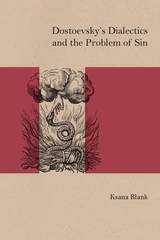 Dostoevsky's Dialectics and the Problem of Sin
Ksana Blank
Northwestern University Press, 2019 In Dostoevsky’s Dialectics and the Problem of Sin, Ksana Blank borrows from ancient Greek, Chinese, and Christian dialectical traditions to formulate a dynamic image of Dostoevsky’s dialectics—distinct from Hegelian dialectics—as a philosophy of “compatible contradictions.” Expanding on the classical triad of Goodness, Beauty, and Truth, Blank guides us through Dostoevsky’s most difficult paradoxes: goodness that begets evil, beautiful personalities that bring about grief, and criminality that brings about salvation. Dostoevsky’s philosophy of contradictions, this book demonstrates, contributes to the development of antinomian thought in the writings of early twentieth-century Russian religious thinkers and to the development of Bakhtin’s dialogism. Dostoevsky’s Dialectics and the Problem of Sin marks an important and original intervention into the enduring debate over Dostoevsky’s spiritual philosophy.
Dostoevsky's Idiot: Dialogue and the Spiritually Good Life
Bruce A. French
Northwestern University Press, 2001 Prince Myshkin is one of Dostoevsky's most perplexing creations. In this study, Bruce A. French presents a provocative interpretation of the religious dimension of Myshkin's goodness from a Bakhtinian perspective.
In three chapters, French takes up in turn the narrator and narrative points of view, the author’s use of inserted narratives, and three modes of interaction French calls Monologue, Dialogue, and Dialogical Living.
Dostoevsky's Occasional Writings
Fyodor Dostoevsky
Northwestern University Press, 1997 This classic collection of articles, sketches, and letters spans thirty-three years in Fyodor Dostoevsky's writing career: from 1847, just after the publication of his first novel, until 1880, a year before his death. The writings show the scope of his artistic development and the changes that occurred as a result of such cataclysmic events as his arrest and trial for treason, and his subsequent imprisonment and exile in Siberia.
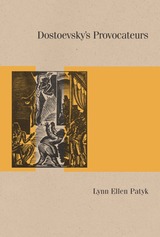 Dostoevsky’s Provocateurs
Lynn Ellen Patyk
Northwestern University Press, 2023 Confronting Bakhtin’s formative reading of Dostoevsky to recover the ways the novelist stokes conflict and engages readers—and to explore the reasons behind his adversarial approach
Like so many other elements of his work, Fyodor Dostoevsky’s deliberate deployment of provocation was both prescient and precocious. In this book, Lynn Ellen Patyk singles out these forms of incitement as a communicative strategy that drives his paradoxical art. Challenging, revising, and expanding on Mikhail Bakhtin’s foundational analysis in Problems of Dostoevsky’s Poetics, Patyk demonstrates that provocation is the moving mover of Dostoevsky’s poetics of conflict, and she identifies the literary devices he uses to propel plot conflict and capture our attention. Yet the full scope of Dostoevsky’s provocative authorial activity can only be grasped alongside an understanding of his key themes, which both probed and exploited the most divisive conflicts of his era. The ultimate stakes of such friction are, for him, nothing less than moral responsibility and the truth of identity.
Sober and strikingly original, compassionate but not uncritical, Dostoevsky’s Provocateurs exposes the charged current in the wiring of our modern selves. In an economy of attention and its spoils, provocation is an inexhaustibly renewable and often toxic resource.
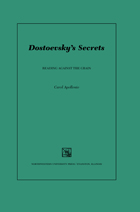 Dostoevsky's Secrets: Reading Against the Grain
Carol Apollonio
Northwestern University Press, 2009 When Fyodor Dostoevsky proclaims that he is a "realist in a higher sense," it is because the facts are irrelevant to his truth. And it is in this spirit that Apollonio approaches Dostoevsky’s work, reading through the facts--the text--of his canonical novels for the deeper truth that they distort, mask, and, ultimately, disclose. This sort of reading against the grain is, Apollonio suggests, precisely what these works, with their emphasis on the hidden and the private and their narrative reliance on secrecy and slander, demand. In each work Apollonio focuses on one character or theme caught in the compromising, self-serving, or distorting narrative lens. Who, she asks, really exploits whom in <i>Poor Folk</i>? Does "White Nights" ever escape the dream state? What is actually lost--and what is won--in <i>The Gambler</i>? Is Svidrigailov, of such ill repute in <i>Crime and Punishment</i>, in fact an exemplar of generosity and truth? Who, in <i>Demons</i>, is truly demonic? Here we see how Dostoevsky has crafted his novels to help us see these distorting filters and develop the critical skills to resist their anaesthetic effect. Apollonio's readings show how Dostoevsky's paradoxes counter and usurp our comfortable assumptions about the way the world is and offer access to a deeper, immanent essence. His works gain power when we read beyond the primitive logic of external appearances and recognize the deeper life of the text.
Dostoevsky's "The Devils": A Critical Companion
William Leatherbarrow
Northwestern University Press, 1999 The Devils is one of Dostoevsky's four major novels--and the most openly political of his works. Known by several names, including The Demons and The Possessed, this novel often anchors courses of Dostoevsky's works. This critical companion contains essays that shed light on both the tricky literary structure of the novel and its social and political components. In addition, editor W.J. Leatherbarrow provides a detailed introduction, extracts from Dostoevsky's correspondence about The Devils, and an annotated bibliography.
Dostoevsky's "The Idiot": A Critical Companion
Liza Knapp
Northwestern University Press, 1998 This book, part of the acclaimed AATSEEL Critical Companions series, is designed to guide readers through Dostoevsky's most mysterious and confusing work. It begins with introductory essays looking at where, when, and how The Idiot was written and at the novel's major characters. Other essays guide the reader through the author's plans and notebooks; use contemporary feminist criticism to shed light on how this novel explores alternatives to traditional roles; examine the ways in which the novel reflects Dostoevsky's concern with apocalypse, modernity, and time; and address the ways the novel's hero, Prince Myshkin, can be compared to Christ. A final section offers a rich collection of primary sources, including Dostoevsky's letters concerning The Idiot, and an annotated bibliography.
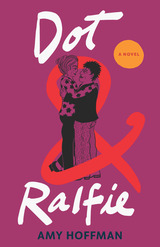 Dot & Ralfie
Amy Hoffman
University of Wisconsin Press, 2022 Dorothy “Dot” Greenbaum and Rafaela “Ralfie” Santopietro have been together for years, but as they age, their stable lives begin to show cracks. Ralfie can’t navigate the stairs in their home after a debilitating knee replacement and Dot’s heart condition throws into question the viability of their careers, their housing, and their relationship. In their late sixties with no kids to lean on, the two women must come to terms with unforeseen questions of identity, love, and family.
Dot is caring but hides hurtful secrets. Ralfie’s gruffness masks the physical and emotional pain she endures. Friends and relatives don’t necessarily offer appealing role models for their third act. Dot’s sister Susan is pushing them toward a stuffy “55 or better” community out in the ’burbs, populated by aging straights who mistake the butch Ralfie for a frumpy old man. Eighty-year-old Viola—Dot’s friend and sometime lover—lives alone and refuses help, even as she experiences a devastating fall. Rife with Hoffman’s characteristic wit, Dot & Ralfie takes a hard, sometimes painful look at elder care in the LGBTQ+ community, and the unique struggles that come with getting older outside of heteronormative structures.
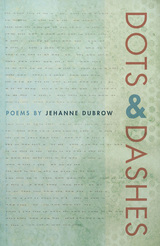 Dots & Dashes
Jehanne Dubrow
Southern Illinois University Press, 2017 Moving between the languages of love and war, Jehanne Dubrow’s latest book offers valuable testimony to the experiences of military wives. Frequently employing rhyme, meter, and traditional forms, these poems examine what it means to be both a military spouse and an academic, straddling two communities that speak in very different and often conflicting terms.
As in the poet’s earlier collection, Stateside, the poems in Dots & Dashes are explicitly feminist, exploring the experiences of women whose husbands are deployed. But, while Stateside looked to masculine stories of war, Dots & Dashes incorporates the views and voices of female poets who have written about combat. Looking to Sappho and Emily Dickinson, the poet considers how the act of writing allows her autonomy and agency rarely granted to military spouses, even in the twenty-first century. Dubrow catalogs the domestic life of a military spouse, illustrating what it is like to live in a tightly constructed world of rules and regulations, ceremony and tradition, where “every sacrifice already / knows its place.”
Navigating the rough seas of marriage alongside questions about how civilians and those in the military can learn to communicate with one another, Dubrow argues for compassion and empathy on both sides. In this timely collection, Dubrow offers the hope that if we can break apart our preconceptions and stereotypes, we can find what connects all of us.
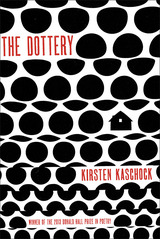 The Dottery
Kirsten Kaschock
University of Pittsburgh Press, 2014 The Dottery is a tale of dotters before they are born. In this series of prose poems you meet their would-be-mutters, the buoys they will know, their inner warden, and the mutterers who cannot have them. The Dottery itself is a sort-of pre-purgatory, a finishing school for the fetal feminine. The five sections correspond to the conceptual set-ups interrogated within. In “wound,” The Dottery is described, as are its inhabitants and their difficulties. In “Dual,” a gender binary is introduced and (hopefully) eviscerated. “Triage” establishes the issues that plague both the dotters and those who would bring them out into the world—specifically into the idea of America (I’m Erica and I can prefer a hummer to the rose parade”). In “Fear,” failed dotters (out in the world) are described in obit fashion. Finally, in “Thief” one mutterer recounts how she stole her dotter (“a snatched piece”) to become a mutter and chronicles both her desires and regrets.
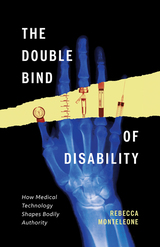 The Double Bind of Disability: How Medical Technology Shapes Bodily Authority
Rebecca Monteleone
University of Minnesota Press, 2025 Exposing the ableism underlying medical innovation
As medical advancements continue to shape the detection, diagnosis, and treatment of disability and illness, technology is often presented as a pathway to autonomy. Challenging this assumption, Rebecca Monteleone shows how medical technologies contribute to a cruel double bind, forcing disabled people to be accountable for adapting to a world built by and for nondisabled people while dismissing their lived experiences in favor of medical expertise. Far more complex than simple progress, these technologies are more oppressive than liberating when they place the burden of care on individuals and perpetuate societal ableism that demands that bodies look, move, and function in certain ways. The Double Bind of Disability examines the complex relationship between medical technologies and their users, highlighting tensions between personal responsibility and medical authority. Sharing the perspectives and experiences of users of three medical technologies (prenatal genetic screening, deep brain stimulation, and do-it-yourself artificial pancreas systems), Monteleone analyzes how users navigate the constraints of these systems and also imagine a new, more liberatory approach to healthcare. Asserting a bold vision, Monteleone describes a future where medical interventions take seriously the lived expertise of disabled people to address ableist infrastructures rather than require the modification of nonnormative bodyminds. She calls for a radical reimagining of medical technology that moves beyond individualistic frameworks to embrace collective experience and embodied knowing. Retail e-book files for this title are screen-reader friendly.
 Double Cross: Japanese Americans In Black And White Chicago
Jacalyn D. Harden
University of Minnesota Press, 2003 Examines relations between peoples of color to offer a compelling new approach to understanding race in America Since the Great Migration of the early twentieth century, Chicago has been a cauldron of race relations, symbolizing the tenacity of discrimination and segregation. But as in other cities with significant populations of Latinos and Asians, Arabs and Jews, this image belies complex racial dynamics. In Double Cross, Jacalyn D. Harden provides an essential rethinking of the ways we understand and talk about race, using an examination of the Japanese American community of Chicago’s Far North Side to form an innovative new framework for looking at race, identity, and political change. The Japanese American community in Chicago rapidly expanded between 1940 and 1950 in the aftermath of wartime internment and government relocation programs. Harden tells their story through archival research and interviews with some of the first Japanese Americans who were relocated to Chicago in the 1940s, incorporating her own experiences as an African American scholar who has lived in Japan. The result is a compelling and surprising account of racial interactions, one that clarifies the complex interweaving between black and Asian lives and reclaims a lost history of solidarity between the two groups.Moving from the Great Migration to the “great relocation” to gentrification, Harden explores the shared history of civil rights struggles that firmly links Japanese and African Americans, most importantly the issue of reparations (for internment during World War II and slavery, respectively). She describes the efforts of Japanese Americans to “double-cross the color line” by building coalitions across race, age, and class boundaries, and their vexed position as sometimes “colored,” sometimes white (for example, the Japanese American soldier who was instructed to use the white washrooms at boot camp in Alabama during World War II, while thousands were being relocated to internment camps). Double Cross is a major contribution to our thought about race relations, challenging orthodoxy and shedding new light on the complex identities, conflicting interests, and external forces that have defined the concept of race in the United States.
 Double Crossover: Gender, Media, and Politics in Global Basketball
Courtney M. Cox
University of Illinois Press, 2025 As they compete in leagues around the world, elite women’s basketball players continually adjust to new cultures, rules, and contracts. Courtney M. Cox follows athletes, coaches, journalists, and advocates of women’s basketball as they pursue careers within the sport. Despite all attempts to contain them or prevent forward momentum, they circumvent expectations and open new possibilities within and outside of the game. Throughout the book, Cox explores the intersection of race and gender against the backdrop of the WNBA, NCAA, and other leagues within the United States and around the world. Blending interviews and participant observation with content analysis, she charts how athletes and advocates of women’s hoops illuminate new forms of navigating the global sports-media complex. Timely and original, Double Crossover takes readers into the lived world of women’s basketball to shed light on the struggles, triumphs, and contributions of today’s players and those around them.
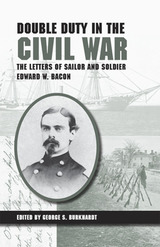 Double Duty in the Civil War: The Letters of Sailor and Soldier Edward W. Bacon
Edited by George S. Burkhardt
Southern Illinois University Press, 2009 In 1861 at the age of eighteen, Edward Woolsey Bacon, a Yale student and son of well-known abolitionist minister Leonard Bacon, left his home in New Haven, Connecticut, to fight for the United States. Over the next four years Bacon served in both the Union navy and army, which gave him a sweeping view of the Civil War. His postings included being a captain’s clerk on the USS Iroquois, a hospital clerk in his hometown, a captain in the 29th Connecticut Infantry (Colored), and a major in the 117th U.S. Colored Infantry, and he described these experiences in vibrant letters to his friends and family. Historian George S. Burkhardt has compiled these letters, as well as Bacon’s diary in the impressive Double Duty in the Civil War: The Letters of Sailor and Soldier Edward W. Bacon. Bacon tells of hunting Confederate commerce raiders on the high seas, enduring the tedium of blockade duty, and taking part in riverine warfare on the Mississippi. He recalls sweating in South Carolina as an infantry officer during drill and picket duty, suffering constant danger in the battlefield trenches of Virginia, marching victoriously on fallen Richmond, and tolerating the boredom of occupation duty in Texas. His highly entertaining letters shed new light on naval affairs and reveal a close-knit family life. The narrative of his duty with black troops is especially valuable, since few first-hand accounts from white officers of the U.S. Colored Troops exist. Furthermore, his beliefs about race, slavery, and the Union cause were unconventional for the time and stand in contrast to those held by many of his contemporaries. Double Duty in the Civil War is filled with lively descriptions of the men Bacon met and the events he experienced. With Burkhardt’s careful editing and useful annotations, Bacon’s letters and diary excerpts give rare insight into areas of the Civil War that have been neglected because of a lack of available sources. Given the scarcity of eyewitness testimonies to navy life and life in African American regiments, this book is a rarity indeed.
 Double Eagle and Rising Sun: The Russians and Japanese at Portsmouth in 1905
Raymond A. Esthus
Duke University Press, 1988 The Russo-Japanese War and the peace conference that followed it at Portsmouth, New Hampshire, marked a turning point affecting not only the history of participants but the future of East Asia and the world.
The 1905 Portsmouth Conference, mediated by President Theodore Roosevelt, for which he received the Nobel Peace Prize, brought to an end a war in which Japan won spectacular victories on land and sea. Although the peace settlement fell far short of public expectations in Japan, she gained supremacy in Korea and a sphere of influence in South Manchuria as a consequence of the treaty. Nevertheless, the treaty reflected the military stalemate in Manchuria. Roosevelt wanted a balance of power to emerge from the war, and his hope was realized in the peace process.
Raymond Esthus, drawing on the records of six nations, provides a detailed and panoramic account of the 1905 conference from the perspectives of both the Russians and the Japanese participants, depicting the powerful personalities of Roosevelt and the Russian Sergei Witte, as well as Tsar Nicholas II and the Foreign Minister Komura Jutaro. It is a story of verbal duels, tests of will, and moments of high personal courage. If there was no clear-cut victor at the conference, Roosevelt emerged as a worldwide hero of the cause of peace.
Double Exposure: How Social Psychology Fell in Love with the Movies
Kathryn Millard
Rutgers University Press, 2022 Double Exposure examines the role of film in shaping social psychology’s landmark postwar experiments. We are told that most of us will inflict electric shocks on a fellow citizen when ordered to do so. Act as a brutal prison guard when we put on a uniform. Walk on by when we see a stranger in need. But there is more to the story. Documentaries that investigators claimed as evidence were central to capturing the public imagination. Did they provide an alibi for twentieth century humanity? Examining the dramaturgy, staging and filming of these experiments, including Milgram's Obedience Experiments, the Stanford Prison Experiment and many more, Double Exposure recovers a new set of narratives.
 The Double Helix and the Law of Evidence
David H. Kaye
Harvard University Press, 2010 Bridging law, genetics, and statistics, this book is an authoritative history of the long and tortuous process by which DNA science has been integrated into the American legal system.In a history both scientifically sophisticated and comprehensible to the nonspecialist, David H. Kaye weaves together molecular biology, population genetics, the legal rules of evidence, and theories of statistical reasoning as he describes the struggles between prosecutors and defense counsel over the admissibility of genetic proof of identity. Combining scientific exposition with stories of criminal investigations, scientific and legal hubris, and distortions on all sides, Kaye shows how the adversary system exacerbated divisions among scientists, how lawyers and experts obfuscated some issues and clarified others, how probability and statistics were manipulated and misunderstood, and how the need to convince lay judges influenced the scientific research. Looking to the future, Kaye uses probability theory to clarify legal concepts of relevance and probative value, and describes alternatives to race-based DNA profile frequencies.Essential reading for lawyers, judges, and expert witnesses in DNA cases, The Double Helix and the Law of Evidence is an informative and provocative contribution to the interdisciplinary study of law and science.
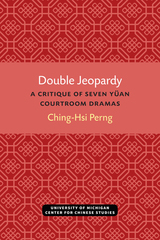 Double Jeopardy: A Critique of Seven Yüan Courtroom Dramas
Ching-Hsi Perng
University of Michigan Press, 1978 Traditionally, criticism of plays from the Yüan Dynasty (1260–1368) has been dominated by the so-called poetic and socialist schools. Double Jeopardy instead rigorously evaluates a group of plays by aesthetic criteria generated from within the works themselves. It examines seven courtroom plays with special attention to language and the manipulation of dramatic characters—undoubtedly the most reliable indicators of the playwright’s strength and craftsmanship in such a stylized art form as Yüan tsa-chü drama. The analytical method adopted in Double Jeopardy is textual explication of the conventions of genre and the individual characteristics of each play. The innovation and creative vitality of each playwright emerges through close scrutiny of selected conventional aspects of courtroom dramas: the functions and placement patterns of lyric, verse, and prose as well as the custom of a single singing role and its implication for the presentation of dramatis personae. Because Yüan drama is driven by conventions, Perng demonstrates a method that can be applied not just to judgment reversal plays but to Yüan dramatic criticism as a whole. In pursuing a method of textual explication, Perng provides a basis on which a larger framework of criticism of Yüan drama may be built.
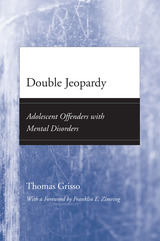 Double Jeopardy: Adolescent Offenders with Mental Disorders
Thomas Grisso
University of Chicago Press, 2004 In the twenty-first-century world of juvenile justice policy and practice, nearly everyone agrees that one of the most pressing issues facing the nation's juvenile courts is their proper response to delinquent youths with mental disorders. Recent research indicates that about two-thirds of adolescent offenders in juvenile justice facilities meet the criteria for one or more mental disorders. What are the obligations of our juvenile justice system, then, as the caretaker for delinquent youth with such disabilities? How do issues of adolescent development create special challenges in determining the court's proper response to delinquents with special mental health needs? Thomas Grisso considers these questions while offering new information to assist the juvenile justice system in its responses to the needs of our children.
Double Jeopardy considers the newest data on the nature of youths' mental disorders—their relationships to delinquency, the values and limits of methods to treat them, and the common patterns of adolescent offending. That information is used to chart a rational course for fulfilling the juvenile justice system's duty—as a custodian of children in need of health care, as a legal system promoting fairness in youth adjudication, and as a protector of public safety—to respond to delinquent youths' mental disorders. Moreover, Double Jeopardy provides a scientific yet practical foundation for lawmakers, judges, attorneys, and mental health care professionals, as well as researchers who must fill the knowledge gaps that limit the juvenile justice system's abilities to meet youths' mental health needs.
Double Lives, Second Chances: The Cinema of Krzysztof Kieslowski
Annette Insdorf
Northwestern University Press, 2013 Krzysztof Kieslowski (1941 – 1996) is widely recognized as one of the greatest filmmakers of the latter half of the twentieth century. Beginning as a documentarian who took on controversial subjects in communist Poland in the 1960’s and 70’s, Kieslowski gained an international reputation with his later narrative films The Double Life of Veronique and the Three Colors trilogy (Blue, White, and Red). He also made the Decalogue, a celebrated series for Polish television. The first comprehensive analysis of Kieslowski’s entire body of work to be published in English, Annette Insdorf’s book still stands as the best introduction to a uniquely gifted artist.
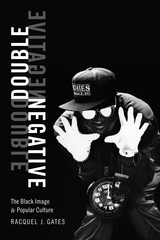 Double Negative: The Black Image and Popular Culture
Racquel J. Gates
Duke University Press, 2018 From the antics of Flavor Flav on Flavor of Love to the brazen behavior of the women on Love & Hip Hop, so-called negative images of African Americans are a recurrent mainstay of contemporary American media representations. In Double Negative Racquel J. Gates examines the generative potential of such images, showing how some of the most disreputable representations of black people in popular media can strategically pose questions about blackness, black culture, and American society in ways that more respectable ones cannot. Rather than falling back on claims that negative portrayals hinder black progress, Gates demonstrates how reality shows such as Basketball Wives, comedians like Katt Williams, and movies like Coming to America play on "negative" images to take up questions of assimilation and upward mobility, provide a respite from the demands of respectability, and explore subversive ideas. By using negativity as a framework to illustrate these texts' social and political work as they reverberate across black culture, Gates opens up new lines of inquiry for black cultural studies.
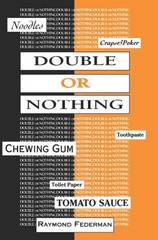 Double or Nothing
Raymond Federman
University of Alabama Press, 1999 Double or Nothing is a concrete novel in which the words become physical materials on the page. Federman gives each of these pages a shape or structure, most often a diagram or picture. The words move, cluster, jostle, and collide in a tour de force full of puns, parodies, and imitations. Within these startling and playful structures Federman develops two characters and two narratives. These stories are simultaneous and not chronological. The first deals with the narrator and his effort to make the book itself; the second, the story the narrator intends to tell, presents a young man's arrival in America. The narrator obsesses over making his narrative to the point of not making it. All of his choices for the story are made and remade. He tallies his accounts and checks his provisions. His questioning and indecision force the reader into another radical sense of the novel. The young man, whose story is to be told, also emerges from his obsessions. Madly transfixing details—noodles, toilet paper, toothpaste, a first subway ride, a sock full of dollars—become milestones in a discovery of America. These details, combined with Federman's feel for the desperation of his characters, create a book that is simultaneously hilarious and frightening. The concrete play of its language, its use of found materials, give the viewer/reader a sense of constant and strange discovery. To turn these pages is to turn the corners of a world of words as full as any novel of literary discourse ever presented. Double or Nothing challenges the way we read fiction and the way we see words, and in the process, gives us back more of our own world and our real dilemmas than we are used to getting. Picked for American Book Review's 100 Best First Lines from Novels
Double Passage: The Lives of Caribbean Migrants Abroad and Back Home
George Gmelch
University of Michigan Press, 1993 Double Passage presents, in their own words, the lives and experiences of thirteen men and women from the island of Barbados who emigrated to North America and Britain and then years later returned home. They tell of their decisions to leave the familiarity and security of home for an uncertain future in cities of the industrial world; they explain what it is like to be black and immigrant in the predominantly white societies they settled in; and they reveal their struggles to find work and decent housing, to develop new relationships, and to save enough money to be able to return home and assume the affluent lifestyle expected of returnees. Double Passage is an extraordinary book that is able both to inform and to entertain.
 The Double Screen: Medium and Representation in Chinese Painting
Wu Hung
University of Chicago Press, 1997 In the first exploration of Chinese paintings as both material products
and pictorial representations, The Double Screen shows how the
collaboration and tension between material form and image gives life to
a painting. A Chinese painting is often reduced to the image it bears;
its material form is dismissed; its intimate connection with social
activities and cultural conventions neglected.
A screen occupies a space and divides it, supplies an ideal surface for
painting, and has been a favorite pictorial image in Chinese art since
antiquity. Wu Hung undertakes a comprehensive analysis of the screen,
which can be an object, an art medium, a pictorial motif, or all three
at once. With its diverse roles, the screen has provided Chinese
painters with endless opportunities to reinvent their art.
The Double Screen provides a powerful non-Western perspective on
issues from portraiture and pictorial narrative to voyeurism,
masquerade, and political rhetoric. It will be invaluable to anyone
interested in the history of art and Asian studies.
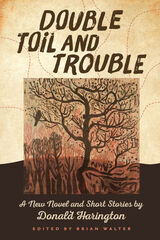 Double Toil and Trouble: A New Novel and Short Stories by Donald Harington
Donald Harington
University of Arkansas Press, 2020 Double Toil and Trouble is the first new volume of fiction in more than a decade by beloved Arkansas writer Donald Harington (1935–2009). Featuring the long-lost suspense novel of the title and four previously unpublished or uncollected stories, this volume adds several new chapters to the saga of Stay More, the fictional Ozarks village that serves as the setting for more than a dozen other Harington novels.
Edited by longtime Harington scholar Brian Walter, Double Toil and Trouble also includes an appendix featuring the author’s spirited correspondence with the editor who originally inspired the title novel, providing an insider’s look at the American literary scene and Harington’s own early assessment of his work. Spanning several decades of the author’s career, this volume gives readers a Harington who is at once familiar and fresh as he experiments with new formal possibilities, only to once again endear the vagaries of love, life, and folk language to us.
The Double Truth
Chard deNiord
University of Pittsburgh Press, 2011 The Double Truth is a collection of poems that arc from myth to history, knowledge to mystery, Eros to natural love, animals to human beings, then back in an alternating poetic current that betrays a speaker who is at once a privileged witness of her time and a diachronic amalgam of voices that are as imagined as they are real in their anonymous legacy.
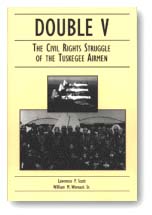 Double V: The Civil Rights Struggle of the Tuskegee Airmen
Lawrence P. Scott
Michigan State University Press, 1994 On April 12, 1945, the United States Army Air Force arrested 101 of its African American officers. They were charged with disobeying a direct order from a superior officer—a charge that could carry the death penalty upon conviction. They were accused of refusing to sign an order that would have placed them in segregated housing and recreational facilities. Their plight was virtually ignored by the press at the time, and books written about the subject did not detail the struggle these aviators underwent to win recognition of their civil rights.
The central theme of Double V is the promise held out to African American military personnel that service in World War II would deliver to them a double victory—a "double V"—over tyranny abroad and racial prejudice at home. The book's authors, Lawrence P. Scott and William M. Womack Sr., chronicle for the first time, in detail, one of America's most dramatic failures to deliver on that promise. In the course of their narrative, the authors demonstrate how the Tuskegee airmen suffered as second-class citizens while risking their lives to serve their country. Among the contributions made by this work is a detailed examination of how 101 Tuskegee airmen, by refusing to live in segregated quarters, triggered one of the most significant judicial proceedings in U.S. military history. Double V uses oral accounts and heretofore unused government documents to portray this little-known struggle by one of America's most celebrated flying units.
In addition to providing background material about African American aviators before World War II. the authors also demonstrate how the Tuskegee airmen's struggle foretold dilemmas faced by the civil rights movement in the second half of the 20th century. Double V is destined to become an important contribution in the rapidly growing body of civil rights literature.
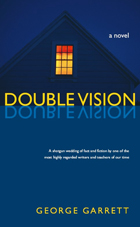 Double Vision: A Novel
George Garrett
University of Alabama Press, 2007 A shotgun marriage of fact and fiction by one of the most highly regarded writers and teachers of our time A writer named George Garrett, suffering from double vision as a result of a neurological disorder, is asked to review a recent, first biography of the late Peter Taylor, a renowned writer who has been his long-time friend and neighbor in Charlottesville. Reflecting on their relationship, Garrett conceives of a character—not unlike himself—a writer in his early 70s, ill and suffering from double vision, named Frank Toomer. He gives Toomer a neighbor, a distinguished short story writer named Aubrey Carver. As the real George Garrett and Peter Taylor are replaced by two very different and imaginary writers, the story becomes a wise and insightful exploration of American literary life, the art of biography, the comical rivalries among writers and academics, notions of success, and the knotty relationship of art to life, fact to fiction, and life to death. Double Vision is a witty tour de force and an elegy for a gifted generation of writers.
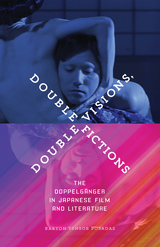 Double Visions, Double Fictions: The Doppelgänger in Japanese Film and Literature
Baryon Tensor Posadas
University of Minnesota Press, 2018 A fresh take on the dopplegänger and its place in Japanese film and literature—past and present
Since its earliest known use in German Romanticism in the late 1700s, the word Doppelgänger (double-walker) can be found throughout a vast array of literature, culture, and media. This motif of doubling can also be seen traversing historical and cultural boundaries. Double Visions, Double Fictions analyzes the myriad manifestations of the doppelgänger in Japanese literary and cinematic texts at two historical junctures: the interwar period of the 1920s and 1930s and the present day.
According to author Baryon Tensor Posadas, the doppelgänger marks the intersection of the historical impact of psychoanalytic theory, the genre of detective fiction in Japan, early Japanese cinema, and the cultural production of Japanese colonialism. He examines the doppelgänger’s appearance in the works of Edogawa Rampo, Tanizaki Jun’ichiro, and Akutagawa Ryunosuke, as well as the films of Tsukamoto Shin’ya and Kurosawa Kiyoshi, not only as a recurrent motif but also as a critical practice of concepts. Following these explorations, Posadas asks: What were the social, political, and material conditions that mobilized the desire for the doppelgänger? And how does the dopplegänger capture social transformations taking place at these historical moments?
Double Visions, Double Fictions ultimately reveals how the doppelgänger motif provides a fascinating new backdrop for understanding the enmeshment of past and present.
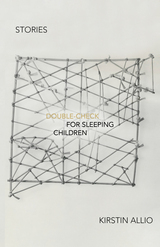 Double-Check for Sleeping Children: Stories
Kirstin Allio
University of Alabama Press, 2024 The winner of the FC2 Catherine Doctorow Innovative Fiction Prize, Double-Check for Sleeping Children is the newest work by award-winning writer Kirstin Allio
At once formal and tidal, damning and dreaming, Kirstin Allio’s Double-Check for Sleeping Children is charged with prayer, curse, redemption and abasement. Does truth come from reason, or beauty, or suffering? It takes the inner lives of outsiders, dark mirrors, and false ceilings to find an answer. Families split by social class, a wealthy young widow, addicts, hunters, poor whites, a green card bride and a nursing mother: in twenty poetically and morally propulsive short stories, Allio disquiets the sublimated and palpates shadows. She leads us through the sometimes flooded, other times flood-lit halls of the human soul. Part menacing, macabre Mary Gaitskill, part Denis Johnson in Jesus’ Son, and with the taut, wry, tell-all detail of Elizabeth Hardwick, Double-Check for Sleeping Children deals in codedness and transgression. The stories explore coming of age in middle age, anxiety about time and technology, inverted revelation. “What was I supposed to do with Basho and Mosie?” Sheila asks herself about her children in “Uncollected Territories.” “Be my real self? Hand myself over, do what you will with me, plant your strange selves in my private soil?”
Double-Consciousness/Double Bind: Theoretical Issues in Twentieth-Century Black Literature
Sandra Adell
University of Illinois Press, 1994 Sandra Adell looks at Black literature and criticism's relationship with the complex ensemble of Western literature, criticism, and philosophy. Adell begins with an analysis of the metaphysical foundations of W. E. B. Du Bois's famous formulation of double-consciousness and how Black writing bears the traces of such European philosophers as Kant, Hegel, and Marx. She then examines, in the double context of black literature and European philosophy, the writings of major authors and essayists like Richard Wright, Leopold Senghor, Maya Angelou, Houston A. Baker, Jr., and Henry Louis Gates Jr. and offers a thoughtful analysis of the "double bind" created by conflicting claims of Euro- and Afrocentrism in Black literature.
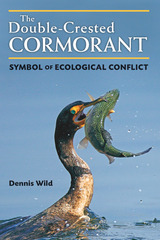 The Double-Crested Cormorant: Symbol of Ecological Conflict
Dennis Wild
University of Michigan Press, 2012 This is the story of the survival, recovery, astonishing success, and controversial status of the double-crested cormorant. After surviving near extinction driven by DDT and other contaminants from the 1940s through the early 1970s, the cormorant has made an unprecedented comeback from mere dozens to a population in the millions, bringing the bird again into direct conflict with humans. Hated for its colonial nesting behavior; the changes it brings to landscapes; and especially its competition with commercial and sports fishers, fisheries, and fish farmers throughout the Great Lakes and Mississippi Delta regions, the cormorant continues to be persecuted by various means, including the shotgun. In The Double-Crested Cormorant, Dennis Wild brings together the biological, social, legal, and international aspects of the cormorant's world to give a complete and balanced view of one of the Great Lakes' and perhaps North America's most misunderstood species. In addition to taking a detailed look at the complex natural history of the cormorant, the book explores the implications of congressional acts and international treaties, the workings and philosophies of state and federal wildlife agencies, the unrelenting efforts of aquaculture and fishing interests to "cull" cormorant numbers to "acceptable" levels, and the reactions and visions of conservation groups. Wild examines both popular preconceptions about cormorants (what kinds of fish they eat and how much) and the effectiveness of ongoing efforts to control the cormorant population. Finally, the book delves into the question of climate and terrain changes, their consequences for cormorants, the new territories to which the birds must adapt, and the conflicts this species is likely to face going forward.
 A Double-Edged Sword: The Biography of Commodore Jesse Duncan Elliott, 1782–1845
David F. Long
University of Alabama Press, 2026 An overdue reassessment of one of the US Navy’s most decorated—and divisive—early commanders, whose legacy remains teetering between heroism and scandalous. A Double-Edged Sword: The Biography of Commodore Jesse Duncan Elliott, 1782–1845 is a comprehensive and long-overdue portrait of one of the most polarizing figures in early US naval history. Written over the course of a decade and completed shortly before the author’s death, this meticulously researched biography revisits the career of a man once hailed for his military exploits—and later condemned for a myriad of personal controversies—including his perceived missteps while in command. David F. Long traces Elliott’s rise from promising young officer to commodore, chronicling his leadership during key moments such as the capture of the brig Caledonia, the defense of Fort Erie, and his central—but contested—role in the Battle of Lake Erie. Despite notable contributions to the Navy’s early successes, including his diplomatic work and restoration of the USS Constitution, Elliott’s legacy was clouded by scandal: accusations of cowardice, a notorious duel, a contentious command style, and a drawn-out court-martial that ended his career in disgrace. Serving as both biography and reflective historical analysis, Long paints a vivid picture of the early US Navy—its rivalries, growing pains, and evolving institutional identity. His balanced account of Elliott’s life, neither excusing his faults nor downplaying his achievements, places the commodore’s story in direct conversation with the challenges and ambitions of a rapidly expanding American maritime power. This is a must read for scholars of naval and military history, early American politics, or anyone interested in the brazen albeit controversial legacy of a forgotten national hero.
Doubles
Robert Polito
University of Chicago Press, 1995 Doubles is at once tough-minded and urbane, veering from lyricism to street slang, oscillating with the beat of the American city. As his title suggests, Polito's world is one of doubling, simulation, impersonation, and mimicry—a shrewd vision of urban life.
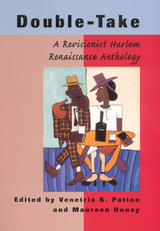 Double-Take: A Revisionist Harlem Renaissance Anthology
Patton, Venetria K
Rutgers University Press, 2001 In this important new anthology, Venetria K. Patton and Maureen Honey bring together a comprehensive selection of texts from the Harlem Renaissance-a key period in the literary and cultural history of the United States. The collection revolutionizes our way of viewing this era, since it redresses the ongoing emphasis on the male writers of this time. Double-Take offers a unique, balanced collection of writers-men and women, gay and straight, familiar and obscure. Arranged by author, rather than by genre, this anthology includes works from major Harlem Renaissance figures as well as often-overlooked essayists, poets, dramatists, and artists.
The editors have included works from a wide variety of genres-poetry, short stories, drama, and essays-allowing readers to understand the true interdisciplinary quality of this cultural movement. Biographical sketches of the authors are provided and most of the pieces are included in their entirety. Double-Take also includes artwork and illustrations, many of which are from original journals and have never before been reprinted. Significantly, Double-Take is the first Harlem Renaissance title to include song lyrics to illustrate the interrelation of various art forms.
Doubletalk: The Language, Code, and Jargon of a Presidential Election
Chuck McCutcheon and David Mark
University Press of New England, 2016 The only time most Americans care anything about politics is during the presidential election cycle. This quadrennial flood of posturing and blame, once confined to the July conventions and the November election, has spread like a greasy lake across the landscape and calendar of our politics. From the first exploratory rumblings of the hopefuls sometime after the midterm elections to the tsunami of Super Tuesday, the political language of the presidential election has become a reflecting pool of our polity. Doubletalk casts a warm ray of sunlight on the campaign trail as an add-on to last year’s Dog Whistles, Walk-backs, and Washington Handshakes, with over 100 new terms, phrases, and epithets combining wit, humor, truth, and dubious taste and propriety.
 Doubling the Point: Essays and Interviews
J. M. Coetzee
Harvard University Press, 1992 Nadine Gordimer has written of J. M. Coetzee that his ‘vision goes to the nerve-centre of being. What he finds there is more than most people will ever know about themselves, and he conveys it with a brilliant writer’s mastery of tension and elegance.’ Doubling the Point takes us to the center of that vision. These essays and interviews, documenting Coetzee’s longtime engagement with his own culture, and with modern culture in general, constitute a literary autobiography of striking intellectual, moral, and political force.
Centrally concerned with the form and content of fiction. Doubling the Point provides rigorous insight into the significance of certain writers (particularly modernists such as Kafka, Musil, and Beckett), the value of intellectual movements (from structuralism and structural linguistics on through deconstruction), and the issues of political involvement and responsibility—not only for Coetzee’s own work, but for fiction writing in general. In interviews prefacing each section of the book, Coetzee reflects on the essays to follow and relates them to his life and work. In these interviews editor David Attwell, remarkably well attuned to his subject, prompts from Coetzee answers of extraordinary depth and interest.
The result is the story of a fiction writer’s intellectual development, and of an intellectual’s literary development. It is the story of how one writer has moved through the scholarly and political trends of the last thirty years, carefully assessing their applications and limitations, and through this experience forged for himself a unique and powerful literary voice informed in equal parts by life and learning.
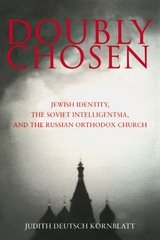 Doubly Chosen: Jewish Identity, the Soviet Intelligentsia, and the Russian Orthodox Church
Judith Deutsch Kornblatt
University of Wisconsin Press, 2004 Doubly Chosen provides the first detailed study of a unique cultural and religious phenomenon in post-Stalinist Russia—the conversion of thousands of Russian Jewish intellectuals to Orthodox Christianity, first in the 1960s and later in the 1980s. These time periods correspond to the decades before and after the great exodus of Jews from the Soviet Union. Judith Deutsch Kornblatt contends that the choice of baptism into the Church was an act of moral courage in the face of Soviet persecution, motivated by solidarity with the values espoused by Russian Christian dissidents and intellectuals. Oddly, as Kornblatt shows, these converts to Russian Orthodoxy began to experience their Jewishness in a new and positive way.
Working primarily from oral interviews conducted in Russia, Israel, and the United States, Kornblatt underscores the conditions of Soviet life that spurred these conversions: the virtual elimination of Judaism as a viable, widely practiced religion; the transformation of Jews from a religious community to an ethnic one; a longing for spiritual values; the role of the Russian Orthodox Church as a symbol of Russian national culture; and the forging of a new Jewish identity within the context of the Soviet dissident movement.
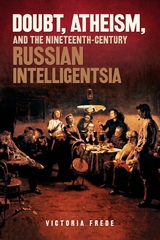 Doubt, Atheism, and the Nineteenth-Century Russian Intelligentsia
Victoria Frede
University of Wisconsin Press, 2011 The autocratic rule of both tsar and church in imperial Russia gave rise not only to a revolutionary movement in the nineteenth century but also to a crisis of meaning among members of the intelligentsia. Personal faith became the subject of intense scrutiny as individuals debated the existence of God and the immortality of the soul, debates reflected in the best-known novels of the day. Friendships were formed and broken in exchanges over the status of the eternal. The salvation of the entire country, not just of each individual, seemed to depend on the answers to questions about belief.
Victoria Frede looks at how and why atheism took on such importance among several generations of Russian intellectuals from the 1820s to the 1860s, drawing on meticulous and extensive research of both published and archival documents, including letters, poetry, philosophical tracts, police files, fiction, and literary criticism. She argues that young Russians were less concerned about theology and the Bible than they were about the moral, political, and social status of the individual person. They sought to maintain their integrity against the pressures exerted by an autocratic state and rigidly hierarchical society. As individuals sought to shape their own destinies and searched for truths that would give meaning to their lives, they came to question the legitimacy both of the tsar and of Russia’s highest authority, God.
 Doubt, Time, Violence
Piotr Hoffman
University of Chicago Press, 1987 In this work of original philosophy, Piotr Hoffman focuses on two of the central concerns of modern philosophy—doubt and time. He argues that both concerns stem from a suppressed but underlying feeling that life is an all-out, unrestrained struggle and that violence is inherent in the human condition.
According to Hoffman, modern philosophy becomes fully intelligible and coherent only when the notion of human violence is given paramount importance. After briefly pointing out some significant parallels between Hobbes and Descartes, Hoffman undertakes a careful examination of ideas about doubt and time in the works of Descartes and Hegel, and, above all, in Heidegger's Being and Time. In a chapter on doubt, Hoffman shows that the skeptical predicament into which man is placed by Descartes's "evil demon" and Heidegger's "death" is grounded in the notion of complete vulnerability to an "other," a vulnerability revealed only in violent confrontation. Hoffman then compares Hegel's and Heidegger's views on time, showing that they presuppose the possibility of viewing the present as a complete break with the past. This possibility is again grounded in the experience of violent struggle with another human being. Hoffman concludes by linking philosophical concepts of doubt and time to ordinary experience.
A lucid, intelligent, and persuasive work, firmly grounded in the texts it considers, Doubt, Time, Violence will challenge philosophers and interest all who ponder the significance of violence.
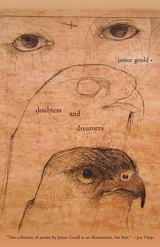 Doubters and Dreamers
Janice Gould
University of Arizona Press, 2011 Doubters and Dreamers opens with a question from a young girl faced with the spectacle of Indian effigies lynched and burned “in jest” before UC Berkeley’s annual Big Game against Stanford: “What’s a debacle, Mom?” This innocent but telling question marks the girl’s entrée into the complicated knowledge of her heritage as a mixed-blood Native American of Koyangk’auwi (Concow) Maidu descent. The girl is a young Janice Gould, and the poems and narrations that follow constitute a remarkable work of sustained and courageous self-revelation, retracing the precarious emotional terrain of an adolescence shaped by a mother’s tough love and a growing consciousness of an ancestral and familial past.
In the first half of the book, “Tribal History,” Gould ingeniously repurposes the sonnet form to preserve the stories of her mother and aunt, who grew up when “muleback was the customary mode / of transport” and the “spirit world was present”—stories of “old ways” and places claimed in memory but lost in time. Elsewhere, she remembers her mother’s “ferocious, upright anger” and her unexpected tenderness (“Like a miracle, I was still her child”), culminating in the profound expression of loss that is the poem “Our Mother’s Death.”
In the second half of the book, “It Was Raining,” Gould tells of the years of lonely self-making and “unfulfilled dreams” as she comes to terms with what she has been told are her “crazy longings” as a lesbian: “It’s been hammered into me / that I’ll be spurned / by a ‘real woman,’ / the only kind I like.” The writing here commemorates old loves and relationships in language that mingles hope and despair, doubt and devotion, veering at times into dreamlike moments of consciousness. One poem and vignette at a time, Doubters and Dreamers explores what it means to be a mixed-blood Native American who grew up urban, lesbian, and middle class in the West.
Doubtful Harbor: Poems
Idris Anderson
Ohio University Press, 2018 In Doubtful Harbor, Idris Anderson turns wandering into art. From large landscapes to the minutest details, she seeks with each poem to convey the world more clearly, acutely, and exquisitely. As she meditates on indelible moments with intimate others, friends, and strangers, she teases from these encounters their elusive connections and disconnections. As Sherod Santos wrote when selecting the book for the Hollis Summers Poetry Prize, “These are not the journeys of a tourist, but of a wandering solitaire whose purpose is not to maintain a travelogue, but to lose herself in the otherness of her surroundings.” Doubt is itself a driving force here, an engine of both questing and questioning. As exact as Anderson’s eye is, her poems draw energy from ambiguity as she renders interior and exterior landscapes—foreign and domestic, lovely and littered, familiar and strange.
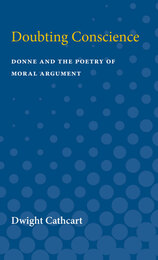 Doubting Conscience: Donne and the Poetry of Moral Argument
Dwight Cathcart
University of Michigan Press, 1975 Solemnly or frivolously, the men and women of Donne's poetry argue the question: What are we to do? Should we weep? Should we make love? They confront a central moral dilemma of the human condition: the contrary demands of the laws of God, nature, or man set against the demands of the unique situation in which the speakers find themselves.Donne's poetry, then, is a poetry of argument—a fact that has been noted by other critics. The brilliance of Cathcart's study lies in its identification and close analysis of the particular kind of argument encountered in the poetry. Donne's speakers, wanting to be in harmony with the general order but stymied because that order is unclear and not reflected in the unique situation, need a particular instrument to reconcile the conflict. That instrument, long familiar to students of moral theology, is casuistry: a method of reasoning and a habit of thought aimed at the resolution of a doubting conscience.By considering Donne's Songs and Sonnets in light of the methods of 16th- and 17th-century casuists, Cathcart demonstrates that, more clearly than any other collection of poems from the Renaissance, these are poems whose motive, subject, structure, setting, tone, and premises are those of moral argument. Not only does this approach relate Donne's thought to the major lines of post-Reformation and post-Tridentine casuistry, it also illuminates the special force of Donne's images and metaphors, the special tone and private ironies embedded in his poetry. Explicating his subject with consistent lucidity and wit, Cathcart has provided an essential work for the study of John Donne and his era.
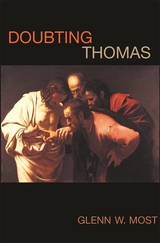 Doubting Thomas
Glenn W. Most
Harvard University Press, 2007 About the disciple known as Doubting Thomas, everyone knows at least this much: he stuck his finger into the risen Jesus’ wounds. Or did he? A fresh look at the Gospel of John reveals how little we may really understand about this most perplexing of biblical figures, and how much we might learn from the strange twists and turns Thomas’s story has taken over time.
From the New Testament, Glenn W. Most traces Thomas’s permutations through the centuries: as Gnostic saint, missionary to India, paragon of Christian orthodoxy, hero of skepticism, and negative example of doubt, blasphemy, stupidity, and violence. Rife with paradoxes and tensions, these creative transformations at the hands of storytellers, theologians, and artists tell us a great deal about the complex relations between texts and their interpretations—and about faith, love, personal identity, the body, and twins, among other matters.
Doubting Thomas begins with a close reading of chapter 20 of the Gospel of John, set against the conclusions of the other Gospels, and ends with a detailed analysis of the painting of this subject by Caravaggio, setting it within the pictorial traditions of late antiquity, the Middle Ages, and the Renaissance. Along the way, Most considers narrative reactions to John’s account by storytellers of various religious persuasions, and Christian theologians’ interpretations of John 20 from the second century ad until the Counter-Reformation. His work shows how Thomas’s story, in its many guises, touches upon central questions of religion, philosophy, hermeneutics, and, not least, life.
 Doubting Women in Early Modern Italy: Gender, Uncertainty, and Agency
Marco Faini
Amsterdam University Press, 2025 This book explores early modern Italian women as agents of doubt. While women were often considered prone to doubt as a result of their natural “weakness,” the essays gathered here reverse this view, demonstrating how women were able to embrace doubt as a means to expand their agency. Using doubt to contest both official narratives as well as religious and civil practices, women were able to carve out a space of their own in contemporary culture and society. The volume covers a period from the late fifteenth to the mid seventeenth centuries, offering critical insight into early modern doubt and investigating how doubt, like other categories of thought, could be gendered.
Contributors address the topics of doubt and the Querelle des Femmes, religion, writing, and social networks. The volume offers a multidisciplinary approach to early modern doubt, combining gender studies with religious history, the history of literature, social history, and the history of science.
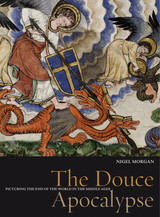 The Douce Apocalypse: Picturing the End of the World in the Middle Ages
Nigel Morgan
Bodleian Library Publishing, 2006 One of the finest of all medieval apocalypse manuscripts, the Douce Apocalypse was part of a series of illuminated texts that brought St. John’s apocalyptic visions to life.
Now the manuscript—created sometime between 1250 and 1275—reaches an entirely new audience at the hands of noted scholar Nigel Morgan. The Douce Apocalypse explores the manuscript’s royal patronage, looks at its fascinating imagery, and examines its significance in light of contemporary prophecy. The commentary is accompanied by lush, full-color illustrations.
As Morgan relates, the Douce Apocalypse is especially enlightening because of its unfinished nature. A few of its images remain incomplete—and such absences give insight into the artist’s painstaking techniques of drawing, gilding, and painting. The second volume in the Treasures from the Bodleian Library series, The Douce Apocalypse will convey both the beauty of the original and the enduring fascination of its contents.
Douglas Home
David Dutton
Haus Publishing, 2006 Alec Douglas-Home was an aristocrat who disclaimed his peerage to become Prime Minister in 1963.
Douglas Horton and the Ecumenical Impulse in American Religion
Theodore Louis Trost
Harvard University Press, 2002 In this first complete biography of Douglas Horton, we are introduced to an extremely important but surprisingly unheralded twentieth-century religious leader. Throughout his life, Horton worked tirelessly for church and world unity under the banner of ecumenism, and his efforts bore fruit in a variety of venues. Horton introduced Americans to the work of Swiss theologian Karl Barth through his translation of The Word of God and the Word of Man (1928). He was the chief architect of the denominational merger that formed the United Church of Christ (1957). He also presided over the transformation of the Harvard Divinity School from a near moribund institution to a distinguished center of religious learning (1955–1959). Toward the end of his life, Horton coordinated the Protestant presence at the Second Vatican Council (1962–1965).
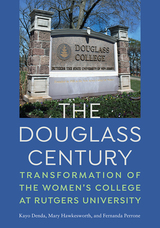 The Douglass Century: Transformation of the Women’s College at Rutgers University
Denda, Kayo
Rutgers University Press, 2018 Rutgers University’s Douglass Residential College is the only college for women that is nested within a major public research university in the United States. Although the number of women’s colleges has plummeted from a high of 268 in 1960 to 38 in 2016, Douglass is flourishing as it approaches its centennial in 2018. To explore its rich history, Kayo Denda, Mary Hawkesworth, Fernanda H. Perrone examine the strategic transformation of Douglass over the past century in relation to continuing debates about women’s higher education.
The Douglass Century celebrates the college’s longevity and diversity as distinctive accomplishments, and analyzes the contributions of Douglass administrators, alumnae, and students to its survival, while also investigating multiple challenges that threatened its existence. This book demonstrates how changing historical circumstances altered the possibilities for women and the content of higher education, comparing the Jazz Age, American the Great Depression, the Second World War, the post-war Civil Rights era, and the resurgence of feminism in the 1970s and 1980s. Concluding in the present day, the authors highlight the college’s ongoing commitment to Mabel Smith Douglass’ founding vision, “to bring about an intellectual quickening, a cultural broadening in connection with specific training so that women may go out into the world fitted…for leadership…in the economic, political, and intellectual life of this nation.” In addition to providing a comprehensive history of the college, the book brings its subjects to life with eighty full-color images from the Special Collections and University Archives, Rutgers University Libraries.
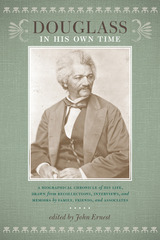 Douglass in His Own Time: A Biographical Chronicle of His Life, Drawn from Recollections, Interviews, and Memoirs by Family, Friends, and Associates
John Ernest
University of Iowa Press, 2014 One of the most incredible stories in American history is that of Frederick Douglass, the man who escaped from slavery and rose to become one of the most celebrated and eloquent orators, writers, and public figures in the world. He first committed his story to writing in his 1845 autobiography Narrative of the Life of Frederick Douglass, an American Slave. Over the course of his life, he would expand on his story considerably, writing two other autobiographies, My Bondage and My Freedom and Life and Times of Frederick Douglass, as well as innumerable newspaper articles and editorials and orations.
As valuable as these writings are in illuminating the man, the story Douglass told in 1845 has become rather too easy to tell, obscuring as much as it reveals. Less a living presence than an inspiring tale, Frederick Douglass remains relatively unknown even to many of those who celebrate his achievements. Douglass in His Own Time offers an introduction to Douglass the man by those who knew him. The book includes a broad range of writings, some intended for public viewing and some private correspondence, all of which contend with the force of Douglass’s tremendous power over the written and spoken word, his amazing presence before crowds, his ability to improvise, to entertain, to instruct, to inspire—indeed, to change lives through his eloquent appeals to righteous self-awareness and social justice. In approaching Douglass through the biographical sketches, memoirs, letters, editorials, and other articles about him, readers will encounter the complexity of a life lived on a very public stage, the story of an extraordinary black man in an insistently white world.
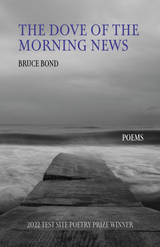 The Dove of the Morning News: Poems
Bruce Bond
University of Nevada Press, 2024 2022 Test Site Poetry Prize winner
In poems both personal and historical, The Dove of the Morning News explores conceptions of collectivity, inflected by each psyche, as a force of both connection and division. In its look at tribalism and systemic cruelty as rooted in shame, dread, and insecurity, the book seeks a better understanding of how power needs, spurred by communities of hatred, weaponize the brain’s tendencies to think in animated figures, caricatures, erasures, or, as in the book’s mediation on vellum, texts written across the bodies of others.
As a lens into contemporary life, the title sequence interrogates the vision of Pierre Teilhard de Chardin, whose sense of our increasingly interwoven cultural conversation figures now as a premonition of the internet. If his hope for the noosphere as a fulfillment of divine promise feels problematic, it nonetheless sees our globe as an organism whose long-term survival depends on the capacity of each to forge friendship across difference, to take the health and integration of the individual as emblematic of the whole.
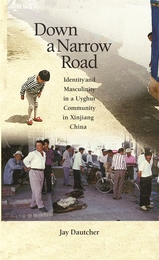 Down a Narrow Road: Identity and Masculinity in a Uyghur Community in Xinjiang China
Jay Dautcher
Harvard University Press, 2009 The Uyghurs, a Turkic group, account for half the population of the Xinjiang region in northwestern China. This ethnography presents a thick description of life in the Uyghur suburbs of Yining, a city near the border with Kazakhstan, and situates that account in a broader examination of Uyghur culture. Its four sections explore topics ranging from family life to market trading, from informal socializing to forms of religious devotion. Uniting these topics are an emphasis on the role folklore and personal narrative play in helping individuals situate themselves in and create communities and social groups, and a focus on how men’s concerns to advance themselves in an agonistic world of status competition shape social life in Uyghur communities.
The narrative is framed around the terms identity, community, and masculinity. As the author shows, Yining’s Uyghurs express a set of individual and collective identities organized around place, gender, family relations, friendships, occupation, and religious practice. In virtually every aspect of their daily lives, individuals and families are drawn into dense and overlapping networks of social relationships, united by a shared engagement with the place of men’s status competition within daily life in the community.
Down and Dirty Down South: Politics and the Art of Revenge
Roger Glasgow
Butler Center for Arkansas Studies, 2016 Returning from a vacation trip to Mexico, Little Rock attorney Roger Glasgow and his wife got the surprise of their lives when they were stopped at the border crossing. Guards ordered them out of their car and began to remove the back seat. What followed was a long nightmare of political intrigue and subterfuge that led all the way back to Arkansas and its capital city.
While pursuing a race for district prosecutor in the 1970s, Glasgow had run afoul of the local political machine. The machine later decided to teach Glasgow a lesson even though he’d lost the race. Down and Dirty Down South is Glasgow’s story of how he attempted to clear his name and also track down the people who had set him up for charges of smuggling illegal drugs into the United States.
Down and Out in America: The Origins of Homelessness
Peter H. Rossi
University of Chicago Press, 1990 The most accurate and comprehensive picture of homelessness to date, this study offers a powerful explanation of its causes, proposes short- and long-term solutions, and documents the striking contrasts between the homeless of the 1950s and 1960s and the contemporary homeless population, which is younger and contains more women, children, and blacks.
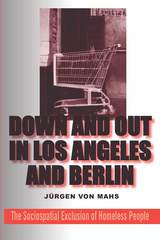 Down and Out in Los Angeles and Berlin: The Sociospatial Exclusion of Homeless People
Jurgen von Mahs
Temple University Press, 2015 Los Angeles, California, and Berlin, Germany, have been dubbed "homeless capitals" for having the largest homeless populations of their respective countries. In Down and Out in Los Angeles and Berlin, Jürgen von Mahs provides an illuminating comparative analysis of the impact of social welfare policy on homelessness in these cities. He addresses the opportunity of people to overcome--or "exit"--homelessness and shows how Berlin, with its considerable social and economic investment for assisting its homeless has been as unsuccessful as Los Angeles.
Drawing on fascinating ethnographic insights, von Mahs shows how homeless people in both cities face sociospatial exclusion-legal displacement for criminal activities, poor shelters in impoverished neighborhoods, as well as market barriers that restrict reintegration. Providing a necessary wake-up call, Down and Out in Los Angeles and Berlin addresses the critical public policy issues that can produce effective services to improve homeless people's chances for a lasting exit.
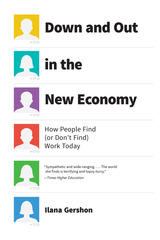 Down and Out in the New Economy: How People Find (or Don’t Find) Work Today
Ilana Gershon
University of Chicago Press, 2017 What does it mean to market yourself as a business in today's job search world?
Finding a job used to be simple. Now . . . well, it’s complicated. In today’s economy, you can’t just be an employee looking to get hired—you have to market yourself as a business, one that can help another business achieve its goals.
That’s a radical transformation in how we think about work and employment, says Ilana Gershon. And with Down and Out in the New Economy, she digs deep into that change and what it means, not just for job seekers, but for businesses and our very culture. In telling this story, Gershon covers all parts of the employment spectrum: she interviews hiring managers about how they assess candidates; attends personal branding seminars; talks with managers at companies around the United States to suss out regional differences—like how Silicon Valley firms look askance at the lengthier employment tenures of applicants from the Midwest. And she finds that not everything has changed: though the technological trappings may be glitzier, in a lot of cases, who you know remains more important than what you know.
Rich in the voices of people deeply involved with all parts of the employment process, Down and Out in the New Economy offers a snapshot of the quest for work today—and a pointed analysis of its larger meaning.
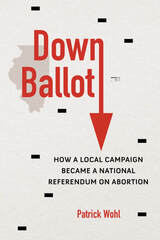 Down Ballot: How a Local Campaign Became a National Referendum on Abortion
Patrick Wohl
University of Illinois Press, 2024 When an obscure primary election met the culture wars In 1990, a suburban Chicago race for the Republican Party nomination for state representative unexpectedly became a national proxy battle over abortion in the United States. But the hard-fought primary also illustrated the overlooked importance of down-ballot contests in America’s culture wars. Patrick Wohl offers the dramatic account of a rollercoaster campaign that, after attracting political celebrities and a media circus, came down to thirty-one votes, a coin toss to determine the winner, and a recount fight that set a precedent for how to count dimpled chads. As the story unfolds, Wohl provides a rare nuts-and-bolts look at an election for state office from its first days through the Illinois Supreme Court decision that decided the winner--and set the stage for a decisive 1992 rematch. A compelling political page-turner, Down Ballot takes readers behind the scenes of a legendary Illinois election.
Down By The Lemonade Springs: Essays On Wallace Stegner
Jackson J. Benson
University of Nevada Press, 2001 Jackson J. Benson, the noted literary biographer and critic, offers a collection of essays on novelist Wallace Stegner. Stegner’s fiction was frequently autobiographical, and Benson’s essays evaluate the man, his work, and the close connections between the two. In mid-career Stegner became a spokesman for the burgeoning environmental movement, and Benson evaluates this aspect of his career, as well his work for racial equality. These collected essays go beyond Benson’s biography of Stegner to explore various aspects of the writer in greater detail.
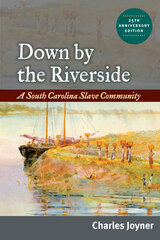 Down by the Riverside: A South Carolina Slave Community
Charles Joyner
University of Illinois Press, 2009 Charles Joyner takes readers on a journey back in time, up the Waccamaw River through the Lowcountry of South Carolina, past abandoned rice fields once made productive by the labor of enslaved Africans, past rice mills and forest clearings into the antebellum world of All Saints Parish. In this community, and many others like it, enslaved people created a new language, a new religion--indeed, a new culture--from African traditions and American circumstances. Joyner recovers an entire lost society and way of life from the letters, diaries, and memoirs of the plantation whites and their guests, from quantitative analysis of census and probate records, and above all from the folklore and oral history of the enslaved Americans. His classic reconstruction of daily life in All Saints Parish is an inspiring testimony to the ingenuity and solidarity of a people. This anniversary edition of Joyner's landmark study includes a new introduction in which the author recounts his process of writing the book, reflects on its critical and popular reception, and surveys the past three decades of scholarship on the history of enslaved people in the United States.
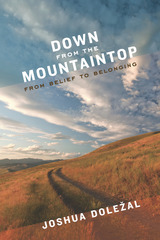 Down from the Mountaintop: From Belief to Belonging
Joshua Dolezal
University of Iowa Press, 2014 A lyrical coming-of-age memoir, Down from the Mountaintop chronicles a quest for belonging. Raised in northwestern Montana by Pentecostal homesteaders whose twenty-year experiment in subsistence living was closely tied to their faith, Joshua Doležal experienced a childhood marked equally by his parents’ quest for spiritual transcendence and the surrounding Rocky Mountain landscape. Unable to fully embrace the fundamentalism of his parents, he began to search for religious experience elsewhere: in baseball, books, and weightlifting, then later in migrations to Tennessee, Nebraska, and Uruguay. Yet even as he sought to understand his place in the world, he continued to yearn for his mountain home.
For more than a decade, Doležal taught in the Midwest throughout the school year but returned to Montana and Idaho in the summers to work as a firefighter and wilderness ranger. He reveled in the life of the body and the purifying effects of isolation and nature, believing he had found transcendence. Yet his summers tied him even more to the mountain landscape, fueling his sense of exile on the plains.
It took falling in love, marrying, and starting a family in Iowa to allow Doležal to fully examine his desire for a spiritual mountaintop from which to view the world. In doing so, he undergoes a fundamental redefinition of the nature of home and belonging. He learns to accept the plains on their own terms, moving from condemnation to acceptance and from isolation to community. Coming down from the mountaintop means opening himself to relationships, grounding himself as a husband, father, and gardener who learns that where things grow, the grower also takes root.
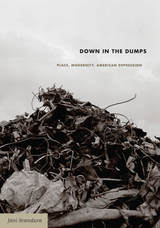 Down in the Dumps: Place, Modernity, American Depression
Jani Scandura
Duke University Press, 2007 Mucking around in the messy terrain of American trash, Jani Scandura tells the story of the United States during the Great Depression through evocative and photo-rich portraits of four locales: Reno, Key West, Harlem, and Hollywood. In investigating these Depression-era “dumps,” places that she claims contained and reclaimed the cultural, ideological, and material refuse of modern America, Scandura introduces the concept of “depressive modernity,” an enduring affective component of American culture that exposes itself at those moments when the foundational myths of America and progressive modernity—capitalism, democracy, individualism, secularism, utopian aspiration—are thrown into question. Depressive modernity is modernity at a standstill. Such a modernity is not stagnant or fixed, nor immobile, but is constituted by an instantaneous unstaging of desire, territory, language, and memory that reveals itself in the shimmering of place. An interpretive bricolage that draws on an unlikely archive of 1930s detritus—office memos, scribbled manuscripts, scrapbooks, ruined photographs, newspaper clippings, glass eyes, incinerated stage sets, pulp novels, and junk washed ashore—Down in the Dumps escorts its readers through Reno’s divorce factory of the 1930s, where couples from across the United States came to quickly dissolve matrimonial bonds; Key West’s multilingual salvage economy and its status as the island that became the center of an ideological tug-of-war between the American New Deal government and a politically fraught Caribbean; post-Renaissance Harlem, in the process of memorializing, remembering, grieving, and rewriting a modernity that had already passed; and Studio-era Hollywood, Nathanael West’s “dump of dreams,” in which the introduction of sound in film and shifts in art direction began to transform how Americans understood place-making and even being itself. A coda on Alcatraz and the Pentagon brings the book into the present, exploring how American Depression comes to bear on post-9/11 America.
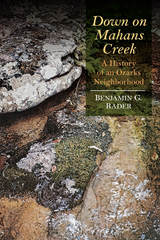 Down on Mahans Creek: A History of an Ozarks Neighborhood
Benjamin G. Rader
University of Arkansas Press, 2017 In Down on Mahans Creek, Benjamin Rader provides a fascinating look at a neighborhood in the Missouri Ozarks from the early nineteenth to the mid-twentieth century. He explores the many ways in which Mahans Creek, though remote, was never completely isolated or self-sufficient. The residents were deeply affected by the Civil War, and the arrival of the railroad and the timber boom in the 1890s propelled the community into modern times, creating a more fast-paced and consumer-oriented way of life and a new moral sensibility. During the Great Depression the creek’s residents returned to some of the older values for survival. After World War II, modern technology changed their lives again, causing a movement away from the countryside and to the nearby small towns. Down on Mahans Creek tells the dynamic story of this distinctive neighborhood navigating the push and pull of the old and new ways of life.
Down on the Killing Floor: Black and White Workers in Chicago's Packinghouses, 1904-54
Rick Halpern
University of Illinois Press, 1997 Rick Halpern examines the links between race relations and unionization in Chicago's meatpacking industry. Drawing on oral histories and archival materials, Halpern explores the experiences of and relationship between black and white workers in a fifty-year period that included labor actions during World War I, Armour's violent reaction to union drives in the late 1930s, and organizations like the Stockyards Labor Council and the United Packinghouse Workers of America.
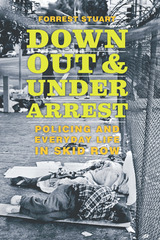 Down, Out, and Under Arrest: Policing and Everyday Life in Skid Row
Forrest Stuart
University of Chicago Press, 2016 In his first year working in Los Angeles’s Skid Row, Forrest Stuart was stopped on the street by police fourteen times. Usually for doing little more than standing there.
Juliette, a woman he met during that time, has been stopped by police well over one hundred times, arrested upward of sixty times, and has given up more than a year of her life serving week-long jail sentences. Her most common crime? Simply sitting on the sidewalk—an arrestable offense in LA.
Why? What purpose did those arrests serve, for society or for Juliette? How did we reach a point where we’ve cut support for our poorest citizens, yet are spending ever more on policing and prisons? That’s the complicated, maddening story that Stuart tells in Down, Out and Under Arrest, a close-up look at the hows and whys of policing poverty in the contemporary United States. What emerges from Stuart’s years of fieldwork—not only with Skid Row residents, but with the police charged with managing them—is a tragedy built on mistakes and misplaced priorities more than on heroes and villains. He reveals a situation where a lot of people on both sides of this issue are genuinely trying to do the right thing, yet often come up short. Sometimes, in ways that do serious harm.
At a time when distrust between police and the residents of disadvantaged neighborhoods has never been higher, Stuart’s book helps us see where we’ve gone wrong, and what steps we could take to begin to change the lives of our poorest citizens—and ultimately our society itself—for the better.
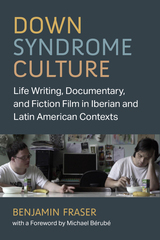 Down Syndrome Culture: Life Writing, Documentary, and Fiction Film in Iberian and Latin American Contexts
Benjamin Fraser
University of Michigan Press, 2024 People with Down syndrome possess a culture. They are producers of culture. And in the 21st century, this culture is increasingly visible as a global phenomenon. Down Syndrome Culture examines Down syndrome alongside its social, cultural, and artistic representation. Author Benjamin Fraser draws upon neomaterialist and posthumanist approaches to disability as well as the work of disability theorists such as David Mitchell, Sharon Snyder, Susan Antebi, Tobin Siebers, and Stuart Murray. By particularly focusing on Down syndrome, he showcases the unique place that it holds as an intellectual and developmental disability—one that fits between the social and medical models of disability—within the disability studies field.
Down Syndrome Culture also pushes the traditionally Anglophone borders of disability studies by examining examples in Spanish, Catalan, and Portuguese-language texts, and incorporating the work of thinkers in Iberian and Latin American studies. Through a close analysis of life writing, documentaries, and fiction films, the book emphasizes the central role of people with Down syndrome in contemporary cultural production. Chapters discuss the autobiography of Andy Trias Trueta, the social actors of the documentary Los niños [The Grown-Ups] (2016), dancers from Danza Mobile, and a variety of fiction films, challenging ableist understandings of disability in nuanced ways. Ultimately, this book reveals the lives, cultural work, and representations of people with trisomy 21 in an international context.
 Down The Jersey Shore
Russell Roberts and Rich Youmans
Rutgers University Press, 1993 Summer visitors and year-round residents alike are sure to discover Jersey Shore lore that captures their fancy in this entertaining account of the people, places, and events that have shaped New Jersey’s famous shoreline. From ghost stories and the comic misadventures of the early Miss America Pageant to the dynamics of the changing coastline and poignant portraits of traditional crafts workers, Russell Roberts and Rich Youmans have chronicled the fascinating history and heritage of the New Jersey Shore. In this book you’ll meet the luminaries who’ve frequented the Shore—from President Ulysses Grant strolling through Long Branch to Grace Kelly learning to surf at Ocean City. You’ll find out why the boardwalk was invented, and also why early ones were removable. Join the authors as they pay tribute to the Shore’s forgotten inventors, including Simon Lake, who some consider the true father of the modern submarine. Relive the Jersey Shore’s role in wartime and learn the story of the mysterious Nazi submarine sunken off of Point Pleasant Beach. Read about Lucy the Margate Elephant, as a well as her two long-gone “cousins.” Discover all this and more as Roberts and Youmans explore the vast uncharted heritage of the New Jersey Shore.
Down the Nights and Down the Days: Eugene O'Neill's Catholic Sensibility
Edward L. Shaughnessy
University of Notre Dame Press, 1996 Edward L. Shaughnessy examines the influence of the Irish playwright’s Catholic heritage on his moral imagination. Critics, due to O'Neill's early renunciation of faith at age fifteen, have mostly overlooked this presence in his work. While Shaughnessy makes no attempt to reclaim him for Catholicism, he uncovers evidence that O'Neill retained the imprint of his Irish Catholic upbringing and acculturation in his work. Shaughnessy discusses several key plays from the O’Neill cannon, such as Long Day’s Journey into Night, The Iceman Cometh, and Mourning Becomes Electra, as well as the lesser-known Ile and Days Without End.
 Down the River: or Practical Lessons Under The Code Duello
George W Hooper
University of Alabama Press, 2007 This delightful divertissement is a lampoon of dueling culture set in southeastern Alabama, penned by a cousin of the better known humorist Johnson Jones Hooper. Interestingly George W. Hooper did not identify himself as the author, perhaps for fear that some enterprising duelist would decide he had been personally lampooned and take umbrage. The main character is a figure familiar in outline to readers of John Gorman Barr, J. J. Hooper, Joseph G. Baldwin, and other practitioners of what is known as the humor of the Old Southwest. This tetchy blowhard is able to find a personal slight in every social circumstance of the most casual nature, to determine the only resolution that could preserve his personal honor is a duel, and then to find elaborate reasons why the affair d’honneur must be postponed indefinitely. The protagonist is accompanied by a Watson-like admirer of comparable wooden-headedness, who admiringly keeps track of all this punctilio—and constantly just barely avoids offending his patron at every turn. The work ends with the provisions of the real “Code Duello,” which cede nothing to the fiction in sheer ridiculousness.
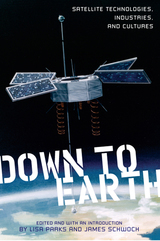 Down to Earth: Satellite Technologies, Industries, and Cultures
Parks, Lisa
Rutgers University Press, 2012 Down to Earth presents the first comprehensive overview of the geopolitical maneuvers, financial investments, technological innovations, and ideological struggles that take place behind the scenes of the satellite industry. Satellite projects that have not received extensive coverage—microsatellites in China, WorldSpace in South Africa, SiriusXM, the failures of USA 193 and Cosmos 954, and Iridium—are explored. This collection takes readers on a voyage through a truly global industry, from the sites where satellites are launched to the corporate clean rooms where they are designed, and along the orbits and paths that satellites traverse. Combining a practical introduction to the mechanics of the satellite industry, a history of how its practices and technologies have evolved, and a sophisticated theoretical analysis of satellite cultures, Down to Earth opens up a new space for global media studies.
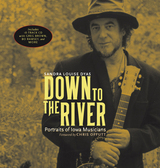 Down to the River: Portraits of Iowa Musicians
Sandra Louise Dyas
University of Iowa Press, 2007 In 1987 photographer Sandra Dyas moved to Iowa City and began documenting the area’s vibrant live music scene, with its distinctive combination of folk, blues, roots/Americana, and rock sounds. The sixty photos in Down to the River capture her twenty years of photographing live music venues and shooting portraits of musicians in and around the city, resulting in a collection of images as compassionate and honest as the music itself.
Dyas’s photographs present both the sweaty intensity of live performances and the more contemplative moments of individual portraits. They are complemented by Chris Offutt’s empathetic essay, which also encapsulates the experience of connecting with a new home through its music. A companion CD with eighteen tracks by Iowa’s finest singer/songwriters, including Dave Moore, Greg Brown, Bo Ramsey, David Zollo, and Pieta Brown, add up to an unmatched perspective on Iowa music and musicians.
CD Tracks
1. Iowa Crawl, Joe Price
2. Poor Back Slider, Greg Brown
3. Parnell, David Zollo
4. #807, Pieta Brown
5. Wheels of Steel, Radoslav Lorkovic
6. Down to the River, Dave Moore
7. Lucy and Andy Drive to Arkansas, Kevin Gordon
8. Chuck Brown, Mike and Amy Finders
9. Nobody But You, Joe Price
10. Earleton, BeJae Fleming
11. Ceremonial Child, High and Lonesome
12. Sidetrack Lounge, Bo Ramsey
13. On the Edge, Pieta Brown
14. One Wrong Turn, Greg Brown
15. Not in Iowa, Kelly Pardekooper
16. Living in a Cornfield, Bo Ramsey
17. ’57 Chevy, Tom Jessen’s Dimestore Outfit
18. Roll on John, the Pines
 Down to the Sunless Sea: A Troubled Samuel Taylor Coleridge in the Mediterranean
Andrew and Suzanne Edwards
Sussex Academic Press, 2023 A literary reflection on Samuel Taylor Coleridge’s hopes for his travels through the Mediterranean and the disastrous trip that resulted.
This book explores Samuel Taylor Coleridge’s Mediterranean sojourn through Gibraltar, Malta, Sicily, and mainland Italy. Coleridge hoped that the trip would allow him to recover his health, escape the clutches of opium, and gain inspiration from the landscape. Instead, he found that little went according to plan in the Mediterranean. Following a brief stint in Gibraltar, Coleridge initially settled into Maltese life, serving as acting Under-Secretary for Alexander Ball, the Civil Commissioner of Malta. He then traveled to Sicily and embraced the island’s landscapes. Soon after arrival, however, he was shaken to discover that the opium poppy was an important local crop. Escaping the drug would not be so easy so long as he stayed on the island. From Sicily, Coleridge continued to travel throughout the Mediterranean, returning to serve as the Public Secretary of Malta before drifting across Italy in a listless attempt at a Grand Tour.
These travels through the Mediterranean significantly affected Coleridge’s life and writing, as well as his health, which saw a marked decline that eventually led to his final years in Highgate under the roof of a friendly doctor. Down to the Sunless Sea offers a poignant literary reflection on the fact that the sun-filled Mediterranean was not the tonic Coleridge first imagined.
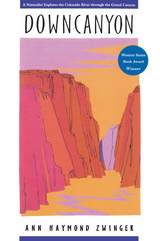 Downcanyon: A Naturalist Explores the Colorado River through the Grand Canyon
Ann Haymond Zwinger
University of Arizona Press, 1995 Every writer comes to the Colorado River in the Grand Canyon with a unique point of view. Ann Zwinger's is that of a naturalist, an "observer at the river's brim."
Teamed with scientists and other volunteer naturalists, Zwinger was part of an ongoing study of change along the Colorado. In all seasons and all weathers, in almost every kind of craft that goes down the waves, she returned to the Grand Canyon again and again to explore, look, and listen. From the thrill of running the rapids to the wonder in a grain of sand, her words take the reader down 280 miles of the "ever-flowing, energetic, whooping and hollering, galloping" river.
Zwinger's book begins with a bald eagle count at Nankoweap Creek in January and ends with a subzero, snowy walk out of the canyon at winter solstice. Between are the delights of spring in side canyons, the benediction of rain on a summer beach, and the chill that comes off limestone walls in November.
Her eye for detail catches the enchantment of small things played against the immensity of the river: the gatling-gun love song of tree frogs; the fragile beauty of an evening primrose; ravens "always in close attendance, like lugubrious, sharp-eyed, nineteenth-century undertakers"; and a golden eagle chasing a trout "with wings akimbo like a cleaning lady after a cockroach."
As she travels downstream, Zwinger follows others in history who have risked—and occasionally lost—their lives on the Colorado. Hiking in narrow canyons, she finds cliff dwellings and broken pottery of prehistoric Indians. Rounding a bend or running a rapid, she remembers the triumphs and tragedies of early explorers and pioneers. She describes the changes that have come with putting a big dam on a big river and how the dam has affected the riverine flora and fauna as well as the rapids and their future.
Science in the hands of a poet, this captivating book is for armchair travelers who may never see the grandiose Colorado and for those who have run it wisely and well. Like the author, readers will find themselves bewitched by the color and flow of the river, and enticed by what's around the next bend. With her, they will find its rhythms still in the mind, long after the splash and spray and pound are gone.
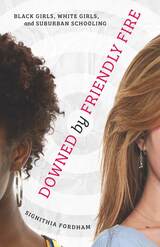 Downed by Friendly Fire: Black Girls, White Girls, and Suburban Schooling
Signithia Fordham
University of Minnesota Press, 2016 Most Americans would never willingly revisit their high school experiences; the nation’s school systems reflect the broader society’s hierarchical emphasis on race, class, and gender. While schools purport to provide equal opportunities for all students, this rarely happens in actuality—particularly for girls. In Downed by Friendly Fire, Signithia Fordham unmasks and examines female-centered bullying in schools, arguing that it is essential to unmask female aggression, bullying, and competition, all of which directly relate to the structural violence embedded in the racialized and gendered social order. For two and a half years, Fordham conducted field research at “Underground Railroad High School,” a suburban high school in upstate New York. Through a series of composite student profiles, she examines the girls’ relationships to academic achievement, social competition, and aggression toward one another. Fordham argues that girls academically “compete to lose,” which only perpetuates their subordination through the misrecognition of their own competitive behaviors. She goes further to expand the meaning of violence to include what is seen as normal, including suffering, humiliation, and social and economic abuse. Using the concept “symbolic violence,” Fordham theorizes the psychological and social damage suffered especially by black girls in schools. The five narratives in Downed by Friendly Fire ultimately highlight the pain and suffering this violence produces as well as the ways in which it promotes inequality, exclusion, and marginalization among girls.
 Downriver Detroit: The Working Class, the Environment, and the Bonds of Place
Lisa M. Fine
University of Illinois Press, 2026 This exploration of an industrial suburb south of Detroit takes seriously the connections to place and the natural world among the working-class people who lived, worked, and played in the region. After a consideration of this type of analysis and demographic and environmental features of this highly industrialized region, each chapter considers a different topic or episode in the on-going efforts of the working-class citizens to create a humane and habitable community. Efforts to combat environmental pollution in this highly industrialized region predate the start of the environmental movement. When working-class people worked to pursue clean water or preserve precious marsh lands along the Detroit River and its tributaries, they worked through sportsmen’s organizations, appealed to state agencies, or engaged in grass roots organizing. Local unions objected to the building of an atomic power plant in the regions in the1950s. And, amidst the challenges of deindustrialization, one group of steel workers attempted to buy their own company to secure their families and communities in the region. When faced with economic and environmental challenges, the working-class of Downriver Detroit expressed an enduring connection to their region, a ‘bond of place.’
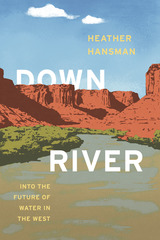 Downriver: Into the Future of Water in the West
Heather Hansman
University of Chicago Press, 2019 Award-winning journalist rafts down the Green River, revealing a multifaceted look at the present and future of water in the American West.
The Green River, the most significant tributary of the Colorado River, runs 730 miles from the glaciers of Wyoming to the desert canyons of Utah. Over its course, it meanders through ranches, cities, national parks, endangered fish habitats, and some of the most significant natural gas fields in the country, as it provides water for 33 million people. Stopped up by dams, slaked off by irrigation, and dried up by cities, the Green is crucial, overused, and at-risk, now more than ever.
Fights over the river’s water, and what’s going to happen to it in the future, are longstanding, intractable, and only getting worse as the West gets hotter and drier and more people depend on the river with each passing year. As a former raft guide and an environmental reporter, Heather Hansman knew these fights were happening, but she felt driven to see them from a different perspective—from the river itself. So she set out on a journey, in a one-person inflatable pack raft, to paddle the river from source to confluence and see what the experience might teach her. Mixing lyrical accounts of quiet paddling through breathtaking beauty with nights spent camping solo and lively discussions with farmers, city officials, and other people met along the way, Downriver is the story of that journey, a foray into the present—and future—of water in the West.
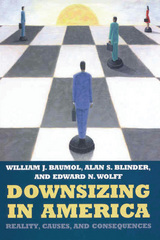 Downsizing in America: Reality, Causes, and Consequences
William J. Baumol
Russell Sage Foundation, 2003 In the 1980s and early 1990s, a substantial number of U.S. companies announced major restructuring and downsizing. But we don't know exactly what changes in the U.S. and global economy triggered this phenomenon. Little research has been done on the underlying causes of downsizing. Did companies actually reduce the size of their workforces, or did they simply change the composition of their workforces by firing some kinds of workers and hiring others? Downsizing in America, one of the most comprehensive analyses of the subject to date, confronts all these questions, exploring three main issues: the extent to which firms actually downsized, the factors that triggered changes in firm size, and the consequences of downsizing. The authors show that much of the conventional wisdom regarding the spate of downsizing in the 1980s and 1990s is inaccurate. Nearly half of the large firms that announced major layoffs subsequently increased their workforce by more than 10 percent within two or three years. The only arena in which downsizing predominated appears to be the manufacturing sector-less than 20 percent of the U.S. workforce. Downsizing in America offers a range of compelling hypotheses to account for adoption of downsizing as an accepted business practice. In the short run, many companies experiencing difficulties due to decreased sales, cash flow problems, or declining securities prices reduced their workforces temporarily, expanding them again when business conditions improved. The most significant trigger leading to long-term downsizing was the rapid change in technology. Companies rid themselves of their least skilled workers and subsequently hired employees who were better prepared to work with new technology, which in some sectors reduced the size of firm at which production is most efficient. Baumol, Blinder, and Wolff also reveal what they call the dirty little secret of downsizing: it is profitable in part because it holds down wages. Downsizing in America shows that reducing employee rolls increased profits, since downsizing firms spent less money on wages relative to output, but it did not increase productivity. Nor did unions impede downsizing. The authors show that unionized industries were actually more likely to downsize in order to eliminate expensive union labor. In sum, downsizing transferred income from labor to capital-from workers to owners
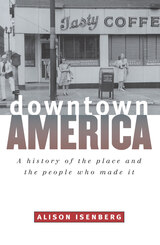 Downtown America: A History of the Place and the People Who Made It
Alison Isenberg
University of Chicago Press, 2005 Downtown America was once the vibrant urban center romanticized in the Petula Clark song—a place where the lights were brighter, where people went to spend their money and forget their worries. But in the second half of the twentieth century, "downtown" became a shadow of its former self, succumbing to economic competition and commercial decline. And the death of Main Streets across the country came to be seen as sadly inexorable, like the passing of an aged loved one.
Downtown America cuts beneath the archetypal story of downtown's rise and fall and offers a dynamic new story of urban development in the United States. Moving beyond conventional narratives, Alison Isenberg shows that downtown's trajectory was not dictated by inevitable free market forces or natural life-and-death cycles. Instead, it was the product of human actors—the contested creation of retailers, developers, government leaders, architects, and planners, as well as political activists, consumers, civic clubs, real estate appraisers, even postcard artists. Throughout the twentieth century, conflicts over downtown's mundane conditions—what it should look like and who should walk its streets—pointed to fundamental disagreements over American values.
Isenberg reveals how the innovative efforts of these participants infused Main Street with its resonant symbolism, while still accounting for pervasive uncertainty and fears of decline. Readers of this work will find anything but a story of inevitability. Even some of the downtown's darkest moments—the Great Depression's collapse in land values, the rioting and looting of the 1960s, or abandonment and vacancy during the 1970s—illuminate how core cultural values have animated and intertwined with economic investment to reinvent the physical form and social experiences of urban commerce. Downtown America—its empty stores, revitalized marketplaces, and romanticized past—will never look quite the same again.
A book that does away with our most clichéd approaches to urban studies, Downtown America will appeal to readers interested in the history of the United States and the mythology surrounding its most cherished institutions.
A Choice Oustanding Academic Title.
Winner of the 2005 Ellis W. Hawley Prize from the Organization of American Historians.
Winner of the 2005 Lewis Mumford Prize for Best Book in American
Planning History.
Winner of the 2005 Historic Preservation Book Price from the University of Mary Washington Center for Historic Preservation.
Named 2005 Honor Book from the New Jersey Council for the Humanities.
Downtown Film and TV Culture 1975-2001
Edited by Joan Hawkins
Intellect Books, 2015 Downtown Film and TV Culture, 1975–2001 brings together essays by filmmakers, exhibitors, cultural critics, and scholars from multiple generations of the New York Downtown scene to illuminate individual films and filmmakers and explore the creation of a Downtown Canon, the impact of AIDS on younger filmmakers, community access cable television broadcasts, and the impact of the historic downtown scene on contemporary experimental culture. The book includes J. Hoberman’s essay “No Wavelength: The Parapunk Underground,” as well as historical essays by Tony Conrad and Lynne Tillman, interviews with filmmakers Bette Gordon and Beth B., and essays by Ivan Kral and Nick Zedd.
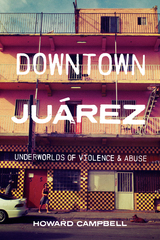 Downtown Juárez: Underworlds of Violence and Abuse
Howard Campbell
University of Texas Press, 2021 At least 200,000 people have died in Mexico’s so-called drug war, and the worst suffering has been in Ciudad Juárez, across the border from El Paso, Texas. How did it get so bad? After three decades studying that question, Howard Campbell doesn’t believe there is any one answer. Misguided policies, corruption, criminality, and the borderland economy are all factors. But none of these reasons explain how violence in downtown Juárez has become heartbreakingly “normal.” A rigorous yet moving account, Downtown Juárez is informed by the sex workers, addicts, hustlers, bar owners, human smugglers, migrants, and down-and-out workers struggling to survive in an underworld where horrifying abuses have come to seem like the natural way of things. Even as Juárez’s elite northeast section thrives on the profits of multinational corporations, and law-abiding citizens across the city mobilize against crime and official malfeasance, downtown’s cantinas, barrios, and brothels are tyrannized by misery. Campbell’s is a chilling perspective, suggesting that, over time, violent acts feed off each other, losing their connection to any specific cause. Downtown Juárez documents this banality of evil—and confronts it—with the stories of those most affected.
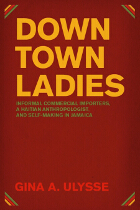 Downtown Ladies: Informal Commercial Importers, a Haitian Anthropologist and Self-Making in Jamaica
Gina A. Ulysse
University of Chicago Press, 2008 The Caribbean “market woman” is ingrained in the popular imagination as the archetype of black womanhood in countries throughout the region. Challenging this stereotype and other outdated images of black women, Downtown Ladies offers a more complex picture by documenting the history of independent international traders—known as informal commercial importers, or ICIs—who travel abroad to import and export a vast array of consumer goods sold in the public markets of Kingston, Jamaica.
Both by-products of and participants in globalization, ICIs operate on multiple levels and, since their emergence in the 1970s, have made significant contributions to the regional, national, and global economies. Gina Ulysse carefully explores how ICIs, determined to be self-employed, struggle with government regulation and other social tensions to negotiate their autonomy. Informing this story of self-fashioning with reflections on her own experience as a young Haitian anthropologist, Ulysse combines the study of political economy with the study of individual and collective identity to reveal the uneven consequences of disrupting traditional class, color, and gender codes in individual societies and around the world.
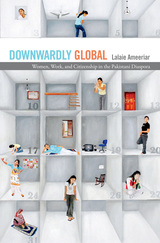 Downwardly Global: Women, Work, and Citizenship in the Pakistani Diaspora
Lalaie Ameeriar
Duke University Press, 2017 In Downwardly Global Lalaie Ameeriar examines the transnational labor migration of Pakistani women to Toronto. Despite being trained professionals in fields including engineering, law, medicine, and education, they experience high levels of unemployment and poverty. Rather than addressing this downward mobility as the result of bureaucratic failures, in practice their unemployment is treated as a problem of culture and racialized bodily difference. In Toronto, a city that prides itself on multicultural inclusion, women are subjected to two distinct cultural contexts revealing that integration in Canada represents not the erasure of all differences, but the celebration of some differences and the eradication of others. Downwardly Global juxtaposes the experiences of these women in state-funded unemployment workshops, where they are instructed not to smell like Indian food or wear ethnic clothing, with their experiences at cultural festivals in which they are encouraged to promote these same differences. This form of multiculturalism, Ameeriar reveals, privileges whiteness while using race, gender, and cultural difference as a scapegoat for the failures of Canadian neoliberal policies.
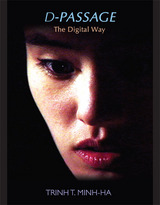 D-Passage: The Digital Way
Trinh T. Minh-ha
Duke University Press, 2013 D-Passage is a unique book by the world-renowned filmmaker, artist, and critical theorist Trinh T. Minh-ha. Taking as grounding forces her feature film Night Passage and installation L'Autre marche (The Other Walk), both co-created with Jean-Paul Bourdier, she discusses the impact of new technology on cinema culture and explores its effects on creative practice. Less a medium than a "way," the digital is here featured in its mobile, transformative passages. Trinh's reflections shed light on several of her major themes: temporality; transitions; transcultural encounters; ways of seeing and knowing; and the implications of the media used, the artistic practices engaged in, and the representations created. In D-Passage, form and structure, rhythm and movement, and language and imagery are inseparable. The book integrates essays, artistic statements, in-depth conversations, the script of Night Passage, movie stills, photos, and sketches.
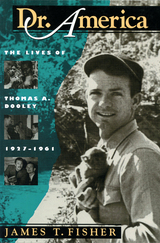 Dr. America: The Lives of Thomas A. Dooley, 1927-1961
James T. Fisher
University of Massachusetts Press, 1997 This book chronicles the life of Tom Dooley, the American doctor whose much-publicized exploits in Vietnam and Laos during the 1950s helped lay the ideological groundwork for the U.S. military intervention a decade later. The scion of an upper-middle-class St. Louis family, Dooley was an enormously complex and fascinating individual. He was a devoutly religious Roman Catholic as well as a self-styled playboy socialite, a devoted physician to the poor and a tireless propagandist for the "Vietnam Lobby," a shameless self-promoter and a closeted homosexual, a victim of Navy persecution and a beneficiary of CIA support. Dooley first gained notoriety as a young Navy doctor charged with overseeing the evacuation of Catholic refugees from North Vietnam in the wake of the 1954 Geneva Accords. His celebrity grew after his book Deliver Us from Evil, a fervently anticommunist account of his experiences, was serialized in Reader's Digest. By the end of the decade, as his name became associated (albeit mistakenly) with a ballad popularized by the Kingston Trio, he had achieved the status of "America's first pop star saint." In addition to exposing the roots of the Vietnam War, Dooley's story illuminates a broad range of developments in post-World War II United States culture—from the "Americanization" of Catholicism to the rise of the mass media.
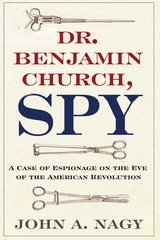 Dr. Benjamin Church, Spy: A Case of Espionage on the Eve of the American Revolution
John A. Nagy
Westholme Publishing, 2013 Newly Discovered Evidence Against a Man Who Has Long Been Suspected as Being a British Agent and America’s First Traitor “John Nagy has devoted his astonishing research skills to unearthing the truth about the least known and most dangerous spy in American history.”—Thomas Fleming, author of Liberty! The American Revolution Dr. Benjamin Church, Jr. (1734–1778) was a respected medical man and civic leader in colonial Boston who was accused of being an agent for the British in the 1770s, providing compromising intelligence about the plans of the provincial leadership in Massachusetts as well as important information from the meetings of the First Continental Congress in Philadelphia. Despite his eminence as a surgeon—he conducted an autopsy on one of the victims of the Boston Massacre—and his own correspondence and the numbers of references to him from contemporaries, no known image of him exists and many aspects of his life remain obscure. What we do know is that George Washington accused him of being a traitor to the colonial cause and had him arrested and tried; after first being jailed in Connecticut and then Massachusetts, during which he continued to profess his innocence, he was allowed to leave America on a British vessel in 1778, but it foundered in the Atlantic with all hands lost. The question of whether Dr. Benjamin Church was working for the British has never been conclusively demonstrated, and remains among the mysteries of the American Revolution. In Dr. Benjamin Church, Spy: A Case of Espionage on the Eve of the American Revolution, noted authority John A. Nagy has scoured original documents to establish the best case against Church, identifying previously unacknowledged correspondence and reports as containing references to the doctor and his activities, and noting an incriminating letter in the possession of the Library of Congress that is a coded communication composed by Church to his British contact. Nagy shows that at the cusp of the revolution, when the possibility—let alone the outcome—of an American colonial rebellion was far from assured, Church sought to align himself with the side he thought would emerge victorious—the British crown—and thus line his pockets with money that he desperately needed. A fascinating investigation into a centuries-old intrigue, this well-researched volume is an important contribution to American Revolution scholarship.
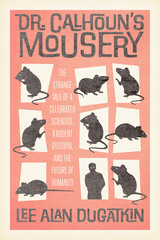 Dr. Calhoun's Mousery: The Strange Tale of a Celebrated Scientist, a Rodent Dystopia, and the Future of Humanity
Lee Alan Dugatkin
University of Chicago Press, 2024 “Brilliant. . . . An absorbing read and a potent lesson in moral behavior—both of rodents and of humans.”—Deborah Blum, Pulitzer Prize–winning author of The Poison Squad • “A fascinating read about an immensely influential scientist.”—Robert M. Sapolsky, author of the New York Times–bestseller Determined • “Stimulating scientific history. . . . Colorful accounts. . . . This fascinates.”—Publishers Weekly
A bizarre and compelling biography of a scientist and his work, using rodent cities to question the potential catastrophes of human overpopulation.
It was the strangest of experiments. What began as a utopian environment, where mice had sumptuous accommodations, had all the food and water they could want, and were free from disease and predators, turned into a mouse hell. Science writer and animal behaviorist Lee Alan Dugatkin introduces readers to the peculiar work of rodent researcher John Bumpass Calhoun. In this enthralling tale, Dugatkin shows how an ecologist-turned-psychologist-turned-futurist became a science rock star embedded in the culture of the 1960s and 1970s. As interest grew in his rodent cities, Calhoun was courted by city planners and his work was reflected in everything from Tom Wolfe’s hard-hitting writing to the children’s book Mrs. Frisby and the Rats of NIMH. He was invited to meetings with the Royal Society and the pope and taken seriously when he proposed a worldwide cybernetic brain—a decade before others made the internet a reality.
Readers see how Calhoun’s experiments—rodent apartment complexes like “Mouse Universe 25”—led to his concept of “behavioral sinks” with real effects on public policy discussions. Overpopulation in Calhoun’s mouse (and rat) complexes led to the loss of sex drive, the absence of maternal care, and a class of automatons that included “the beautiful ones,” who spent their time grooming themselves while shunning socialization. Calhoun—and those who followed his work—saw the collapse of this mouse population as a harbinger of the ill effects of an overpopulated human world.
Drawing on previously unpublished archival research and interviews with Calhoun’s family and former colleagues, Dugatkin offers a riveting account of an intriguing scientific figure. Considering Dr. Calhoun’s experiments, he explores the changing nature of scientific research and delves into what the study of animal behavior can teach us about ourselves.
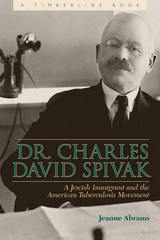 Dr. Charles David Spivak: A Jewish Immigrant and the American Tuberculosis Movement
Jeanne Abrams
University Press of Colorado, 2009 Part biography, part medical history, and part study of Jewish life in turn-of-the-century America, Jeanne Abrams's book tells the story of Dr. Charles David Spivak - a Jewish immigrant from Russia who became one of the leaders of the American Tuberculosis Movement. Born in Russia in 1861, Spivak immigrated to the United States in 1882 and received his medical degree from Philadelphia's Jefferson Medical College by 1890. In 1896, his wife's poor health brought them to Colorado. Determined to find a cure, Spivak became one of the most charismatic and well-known leaders in the American Tuberculosis Movement. His role as director of Denver's Jewish Consumptives' Relief Society sanatorium allowed his personal philosophies to strongly influence policies. His unique blend of Yiddishkeit, socialism, and secularism - along with his belief in treating the "whole" patient - became a model for integrating medical, social, and rehabilitation services that was copied across the country. Not only a national leader in the crusade against tuberculosis but also a luminary in the American Jewish community, Dr. Charles Spivak was a physician, humanitarian, writer, linguist, journalist, administrator, social worker, ethnic broker, and medical, public health, and social crusader. Abrams's biography will be a welcome addition to anyone interested in the history of medicine, Jewish life in America, or Colorado history.
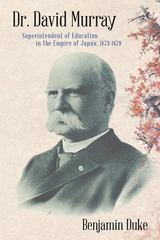 Dr. David Murray: Superintendent of Education in the Empire of Japan, 1873-1879
Duke, Benjamin
Rutgers University Press, 2018 This is the first biography in English of an uncommon American, Dr. David Murray, a professor of mathematics at Rutgers College, who was appointed by the Japanese government as Superintendent of Education in the Empire of Japan in 1873. The founding of the Gakusei—the first public school system launched in Japan—marks the beginning of modern education in Japan, accommodating all children of elementary school age. Murray’s unwavering commitment to its success renders him an educational pioneer in Japan in the modern world.
Benjamin Duke has compiled this comprehensive biography of David Murray to showcase Murray’s work, both in assisting around 100 samurai students in their studies at Rutgers, and in his unprecedented role in early Japanese-American relations. This fascinating story uncovers a little-known link between Rutgers University and Japan, and it is the only book to conclude that Rutgers made a greater contribution to the development of modern education in the early Meiji Era than any other non-Japanese college or university in the world.
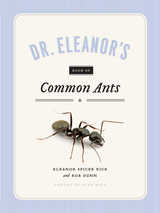 Dr. Eleanor's Book of Common Ants
Eleanor Spicer Rice, Alex Wild, and Rob Dunn
University of Chicago Press, 2017 Did you know that for every human on earth, there are about one million ants? They are among the longest-lived insects—with some ant queens passing the thirty-year mark—as well as some of the strongest. Fans of both the city and countryside alike, ants decompose dead wood, turn over soil (in some places more than earthworms), and even help plant forests by distributing seeds. But while fewer than thirty of the nearly one thousand ant species living in North America are true pests, we cringe when we see them marching across our kitchen floors.
No longer! In this witty, accessible, and beautifully illustrated guide, Eleanor Spicer Rice, Alex Wild, and Rob Dunn metamorphose creepy-crawly revulsion into myrmecological wonder. Emerging from Dunn’s ambitious citizen science project Your Wild Life (an initiative based at North Carolina State University), Dr. Eleanor’s Book of Common Ants provides an eye-opening entomological overview of the natural history of species most noted by project participants—and even offers tips on keeping ant farms in your home. Exploring species from the spreading red imported fire ant to the pavement ant, and featuring Wild’s stunning photography, this guide will be a tremendous resource for teachers, students, and scientists alike. But more than this, it will transform the way we perceive the environment around us by deepening our understanding of its littlest inhabitants, inspiring everyone to find their inner naturalist, get outside, and crawl across the dirt—magnifying glass in hand.
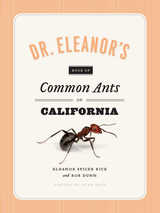 Dr. Eleanor's Book of Common Ants of California
Eleanor Spicer Rice, Alex Wild, and Rob Dunn
University of Chicago Press, 2017 Did you know that for every human on earth, there are about one million ants? They are among the longest-lived insects—with some ant queens passing the thirty-year mark—as well as some of the strongest. Fans of both the city and countryside alike, ants decompose dead wood, turn over soil (in some places more than earthworms), and even help plant forests by distributing seeds. But while fewer than thirty of the nearly one thousand ant species living in North America are true pests, we cringe when we see them marching across our kitchen floors.
No longer! In this witty, accessible, and beautifully illustrated guide, Eleanor Spicer Rice, Alex Wild, and Rob Dunn metamorphose creepy-crawly revulsion into myrmecological wonder. Emerging from Dunn’s ambitious citizen science project Your Wild Life (an initiative based at North Carolina State University) and the work of Brian Fisher with the California Academy of Sciences, Dr. Eleanor’s Book of Common Ants of California provides an eye-opening entomological overview of the natural history of California’s species most noted by project participants—and even offers tips on keeping ant farms in your home. Exploring species from the high noon and harvester ants to the honeypot and acrobat ants, and featuring Wild’s stunning photography, this guide will be a tremendous resource for teachers, students, and scientists alike. But more than this, it will transform the way Californians perceive the environment around them by deepening their understanding of its littlest inhabitants, inspiring everyone to find their inner naturalist, get outside, and crawl across the dirt—magnifying glass in hand.
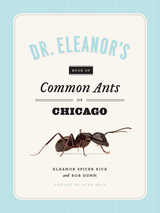 Dr. Eleanor's Book of Common Ants of Chicago
Eleanor Spicer Rice, Alex Wild, and Rob Dunn
University of Chicago Press, 2017 Did you know that for every human on earth, there are about one million ants? They are among the longest-lived insects—with some ant queens passing the thirty-year mark—as well as some of the strongest. Fans of both the city and countryside alike, ants decompose dead wood, turn over soil (in some places more than earthworms), and even help plant forests by distributing seeds. But while fewer than thirty of the nearly one thousand ant species living in North America are true pests, we cringe when we see them marching across our kitchen floors.
No longer! In this witty, accessible, and beautifully illustrated guide, Eleanor Spicer Rice, Alex Wild, and Rob Dunn metamorphose creepy-crawly revulsion into myrmecological wonder. Emerging from Dunn’s ambitious citizen science project Your Wild Life (an initiative based at North Carolina State University), Dr. Eleanor’s Book of Common Ants of Chicago provides an eye-opening entomological overview of the natural history of Chicago’s species most noted by project participants—and even offers tips on keeping ant farms in your home. Exploring species from the hobbit ant to the tiny trapjaw ant, and featuring contributions from E. O. Wilson and Field Museum ant scientist Corrie Moreau as well as Wild’s stunning photography, this guide will be a tremendous resource for teachers, students, and scientists alike. But more than this, it will transform the way Chicagoans perceive the environment around them by deepening their understanding of its littlest inhabitants, inspiring everyone to find their inner naturalist, get outside, and crawl across the dirt—magnifying glass in hand.
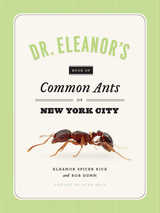 Dr. Eleanor's Book of Common Ants of New York City
Eleanor Spicer Rice, Alex Wild, and Rob Dunn
University of Chicago Press, 2017 Did you know that for every human on earth, there are about one million ants? They are among the longest-lived insects—with some ant queens passing the thirty-year mark—as well as some of the strongest. Fans of both the city and countryside alike, ants decompose dead wood, turn over soil (in some places more than earthworms), and even help plant forests by distributing seeds. But while fewer than thirty of the nearly one thousand ant species living in North America are true pests, we cringe when we see them marching across our kitchen floors.
No longer! In this witty, accessible, and beautifully illustrated guide, Eleanor Spicer Rice, Alex Wild, and Rob Dunn metamorphose creepy-crawly revulsion into myrmecological wonder. Emerging from Dunn’s ambitious citizen science project Your Wild Life (an initiative based at North Carolina State University), Dr. Eleanor’s Book of Common Ants of New York City provides an eye-opening entomological overview of the natural history of New York’s species most noted by project participants—and even offers insight into the ant denizens of the city’s subways and Central Park. Exploring species from the honeyrump ant to the Japanese crazy ant, and featuring Wild’s stunning photography as well as tips on keeping ant farms in your home, this guide will be a tremendous resource for teachers, students, and scientists alike. But more than this, it will transform the way New Yorkers perceive the environment around them by deepening their understanding of its littlest inhabitants, inspiring everyone to find their inner naturalist, get outside, and crawl across the dirt—magnifying glass in hand.
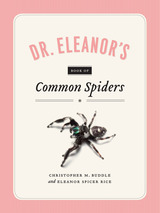 Dr. Eleanor's Book of Common Spiders
Christopher M. Buddle and Eleanor Spicer Rice
University of Chicago Press, 2018 Spiders have a problem, and it’s us. Despite their magnificent talents for crafting webs, capturing mosquitoes, and camouflage, for millennia arachnophobia has hampered our ability to appreciate these eight-legged and -eyed marvels.
No longer! In this witty, accessible, and beautifully illustrated guide, Christopher M. Buddle and Eleanor Spicer Rice metamorphose creepy-crawly revulsion into spider wonder. Emerging from ambitious citizen science project Your Wild Life (an initiative based at North Carolina State University), Dr. Eleanor's Book of Common Spiders provides an eye-opening arachnological overview of the natural history of species most noted by project participants, showcasing some of the fascinating spiders found in our attics and tents, front lawns and forests—and even introducing us to spiders that fish. Exploring species from the tiny (but gymnastic) zebra jumping spider to the naturally shy and woefully misunderstood black widow, this guide will be a tremendous resource for teachers, students, and scientists alike. But more than this, it will transform the way we perceive the environment around us by deepening our understanding of its littlest inhabitants, inspiring all of us to find our inner naturalist, get outside, and crawl across the dirt—magnifying glass in hand.
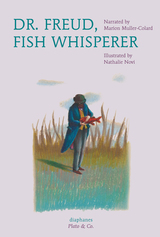 Dr. Freud, Fish Whisperer
Marion Muller-Colard
Diaphanes, 2017 At its most basic, philosophy is about learning how to think about the world around us. It should come as no surprise, then, that children make excellent philosophers! Naturally inquisitive, pint-size scholars need little prompting before being willing to consider life’s big questions, however strange or impractical. Plato & Co. introduces children—and curious grown-ups—to the lives and work of famous philosophers, from Socrates to Descartes, Einstein, Marx, and Wittgenstein. Each book in the series features an engaging—and often funny—story that presents basic tenets of philosophical thought alongside vibrant color illustrations.
Sprawled in his favorite armchair, Dr. Freud notices a peculiar phrase in pages of his notebook: “preaching to the fishes.” What could he have meant by this? If there’s one thing he has learned working as a psychoanalyst, it’s that the best way to make sense of yourself is through your dreams—and so he settles down for a nice long nap. But no sooner does his head hit the pillow than he begins to hear voices! A frightened fish with a childhood memory lodged in its throat coaxes Dr. Freud into the cold water, where his ideas come to life through an unforgettable cast of characters, including a loquacious carp and three frogs—Id, Ego, and Superego—locked in fierce competition for a single waterlily.
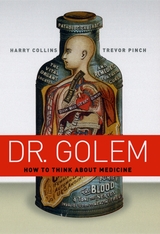 Dr. Golem: How to Think about Medicine
Harry Collins and Trevor Pinch
University of Chicago Press, 2005 A creature of Jewish mythology, a golem is an animated being made by man from clay and water who knows neither his own strength nor the extent of his ignorance. Like science and technology, the subjects of Harry Collins and Trevor Pinch's previous volumes, medicine is also a golem, and this Dr. Golem should not be blamed for its mistakes—they are, after all, our mistakes. The problem lies in its well-meaning clumsiness.
Dr. Golem explores some of the mysteries and complexities of medicine while untangling the inherent conundrums of scientific research and highlighting its vagaries. Driven by the question of what to do in the face of the fallibility of medicine, Dr. Golem encourages a more inquisitive attitude toward the explanations and accounts offered by medical science. In eight chapters devoted to case studies of modern medicine, Collins and Pinch consider the prevalence of tonsillectomies, the placebo effect and randomized control trials, bogus doctors, CPR, the efficacy of Vitamin C in fighting cancer, chronic fatigue syndrome, AIDS cures, and vaccination. They also examine the tension between the conflicting faces of medicine: medicine as science versus medicine as a source of succor; the interests of an individual versus the interests of a group; and the benefits in the short term versus success rates in the long term. Throughout, Collins and Pinch remind readers that medical science is an economic as well as a social consideration, encapsulated for the authors in the timeless struggle to balance the good health of the many—with vaccinations, for instance—with the good health of a few—those who have adverse reactions to the vaccine.
In an age when the deaths of research subjects, the early termination of clinical trials, and the research guidelines for stem cells are front-page news, Dr. Golem is a timely analysis of the limitations of medicine that never loses sight of its strengths.
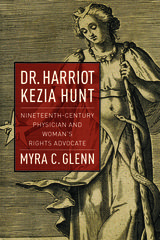 Dr. Harriot Kezia Hunt: Nineteenth-Century Physician and Woman’s Rights Advocate
Myra C. Glenn
University of Massachusetts Press, 2018 Harriot Kezia Hunt was a pioneer in a number of ways. The first woman to establish a successful medical practice in the United States, she began seeing patients in Boston in 1835 and promoted a new method of treatment by listening to women's troubles or their “heart histories.” Her unsuccessful efforts to attend lectures at Harvard's Medical School galvanized her activism in the woman's rights movement. During the 1850s she played a prominent role in the annual woman's rights conventions and was the first woman in Massachusetts to publicly protest the injustice of taxing propertied women while denying them the franchise.
In this first comprehensive, full-length biography of Hunt, Myra C. Glenn shows how this single woman from a working-class Boston home became a successful physician and noted reformer, illuminating the struggle for woman's rights and the fractious and gendered nature of medicine in antebellum America.
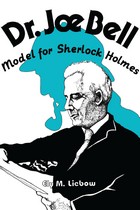 Dr. Joe Bell: Model for Sherlock Holmes
Ely M. Liebow
University of Wisconsin Press, 1982 A distinguished physician and professor of medicine at Edinburgh University, and a forensic expert for the British Crown, Joseph Bell was well known for his remarkable powers of observation and deduction. In what would become true Sherlockian fashion, he had the ability to deduce facts about his patients from otherwise unremarkable details. In one instance recounted by Arthur Conan Doyle himself—and similar to Sherlock Holmes's own observations in "The Greek Interpreter"—Bell took little time to determine that one of his patients had recently served in the army, a non-commissioned officer discharged from his Highland regiment stationed in Barbados: “The man was a respectful man, but did not remove his hat. They do not in the army, but he would have learned civilian ways had he been long discharged. He has an air of authority and he is obviously Scottish. As to Barbados, his complaint is elephantitis, which is West Indian and not British.” Based on extensive research into the life of Bell and including tantalizing accounts of the connections between Bell and Conan Doyle, this biography is required reading for anyone interested in Victorian medicine, in the history of detective fiction, and in Sherlock Holmes and Dr. Watson.
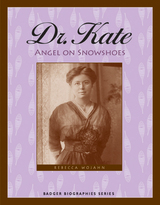 Dr. Kate: Angel on Snowshoes
Rebecca Hogue Wojahn
Wisconsin Historical Society Press, 2009 Pioneering North Woods doctor Kate Pelham Newcomb comes to life in this addition to the Badger Biographies series for young readers. Born in 1885, Kate Pelham was suppose to grow up to be a proper young lady in Boston, but despite her father's wishes she was determined to be a doctor. After medical school, her husband's health brought them to the clean air of northern Wisconsin and before long Kate knew every back road and cabin in the North Woods. She visited patients by snowmobile, by canoe, and by snowshoe and never sent a bill. Instead she was paid in firewood and vegtables. But what Kate dreamed of more than anything for her patients was a hospital. And that's when the kids of the community got involved. They set out to collect a million pennies - $10,000 - to help Dr. Kate build a hospital. As the news spread, coins poured in from countries across the globe. Students carted bushels of pennies, and Dr. Kate read thousands of letters cheering on her effort. Her dream came true in 1954 when the Lakeland Memorial Hospital opened its doors. Young readers will warm to Kate's spirit of compassion and never-say-never attitude.
 Dr. Koop: The Many Lives of the Surgeon General
Nigel M. de S. Cameron
University of Massachusetts Press, 2025 The first full biography of Reagan's famous Surgeon General, who put science before politics—cutting smoking by 25%, leading the fight against AIDS, and shocking both liberals and conservatives on abortion.
When Ronald Reagan chose C. Everett Koop to be Surgeon General of the United States in 1981, liberal politicians, women's groups, and even the public health community opposed the nomination because of his conservative social views and strong anti-abortion beliefs. By the time he left office in 1989, the same people who had vilified him as “Dr. Kook” were singing his praises, and many conservative politicians and activists who had championed his nomination were criticizing him as a traitor. He had also become “the only surgeon general [who was] a household name,” according to the Associated Press, because of his ubiquitous media exposure around the HIV/AIDS crisis, his unique look, and his savvy with the press. How had Koop remade himself and this once major government office, which sounded grand but in the 1960s had been stripped to a minor advisory role?
As Nigel M. de S. Cameron shows, Koop was, above all, guided in his decisions by his unwavering physician’s commitment to saving lives. Even in the face of political pressures and what many expected to be his personal beliefs, he focused on science and public health. On smoking, abortion, and AIDS he openly defied Republican politicians and alienated New Right conservatives because his reading of the science did not support their ideologies. It was this adherence to science, health, and office that led him to refuse to campaign on abortion, seek compromise on the disabled “Baby Doe” case, relentlessly go after Big Tobacco, and finally reach out to the gay community as AIDS and fear of AIDS exploded. Both supporters and detractors consistently misjudged him.
This first full biography of Koop draws on thousands of documents and hundreds of interviews with family, friends, and colleagues to tell the story of the precocious boy from Brooklyn who was already the world’s most celebrated pediatric surgeon when he became Surgeon General and one of the most recognizable public figures in late-20th century America. Koop remains a sterling example—to both left and right—of how public officials should conduct themselves.
 Dr. Leonardo’s Journey to Sloboda Switzerland with His Future Lover, the Beautiful Alcesta
Maik Yohansen
Harvard University Press Italian doctor Leonardo Pazzi and Alcesta, his “future lover,” travel through the picturesque, hilly region of Sloboda, near Kharkiv in northeast Ukraine. They experience a series of encounters with local Ukrainians and nature, disappearances, and transformations filled with paradoxes. The characters are bright, marionette-like caricatures whom the author constructs and moves ostentatiously in full view of the reader, revealing his artistic devices with a sense of absurd, mischievous humor.
A novel of exuberance and whim that deconstructs the very principles of writing and estranges everyday phenomena, Dr. Leonardo’s Journey marks the highpoint of Ukrainian modernism right before it was violently cut down by Stalin’s repressions. The novel shifts away from character or plot as such and instead celebrates the places and spaces in which these things come into being, and the sheer joy of movement and experience. In this sense, Maik Yohansen’s heroes echo Mykola Hohol, whose tour through Russia’s vast spaces in Nikolai Gogol’s Dead Souls is an obvious reference point, and Laurence Sterne, whose irreverent narrative style and textual games Yohansen emulates. Presented here in a contemporary, deft English translation, the novel is a must read for everyone interested in discovering the rich heritage of Ukrainian modernism.
 Dr. Livingstone, I Presume?: Missionaries, Journalists, Explorers, and Empire
Clare Pettitt
Harvard University Press, 2007 When the American reporter Henry Morton Stanley stepped out of the jungle in 1871 and doffed his pith helmet to the Scottish missionary-explorer Dr. David Livingstone, his greeting was to take on mythological proportions. But do any of us really know what his words meant at the time--and what they have come to mean since?
Far from meeting in a remote thicket in "Darkest Africa," Stanley met Livingstone in the middle of a thriving Muslim community. The news of their encounter was transmitted around the globe, and Livingstone instantly became one of the world's first international celebrities.
This book shows how urgently a handshake between a Briton and an American was needed to heal the rift between the two countries after the American Civil War. It uncovers for the first time the journeys that Livingstone's African servants made around Britain after his death, and it makes a case for Stanley's immense influence on the idea of the modern at the dawn of the twentieth century. Drawing on films, children's books, games, songs, cartoons, and TV shows, this book reveals the many ways our culture has remembered Stanley's phrase, while tracking the birth of an Anglo-American Christian imperialism that still sets the world agenda today.
Dr. Livingstone, I Presume? is a story of conflict and paradox that also takes us into the extraordinary history of British engagement with Africa. Clare Pettitt shows both the bleakest side of imperialism and the strange afterlife of a historical event in popular mythmaking and music hall jokes.
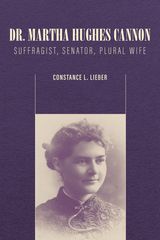 Dr. Martha Hughes Cannon: Suffragist, Senator, Plural Wife
Constance L. Lieber
Signature Books, 2022 Martha Hughes Cannon (1857–1932) may best be known as the first female state senator in the United States, elected in Utah in 1896, nearly a quarter century before most women in the country could vote. She was also a suffragist, physician, gifted speaker, plural wife, faithful member of the Church of Jesus Christ of Latter-day Saints, and mother of three. This short biography examines what drove Cannon to accomplish so much. Following two periods of self-imposed exile to avoid prosecution for polygamy, and a subsequent career in partisan politics, she died in California, surrounded by her children and grandchildren but virtually forgotten by the larger world. She had much to say during her lifetime and has much to say to us today about persevering in spite of adversity. Constance Lieber chronicles the important story of one of the American West’s and Mormonism’s most intriguing characters.
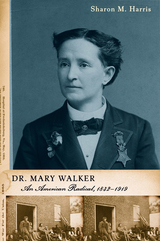 Dr. Mary Walker: An American Radical, 1832-1919
Harris, Sharon M
Rutgers University Press, 2009 A suffragist who wore pants. This is just the simplest of ways Dr. Mary Walker is recognized in the fields of literature, feminist and gender studies, history, psychology, and sociology. Perhaps more telling about her life are the words of an 1866 London Anglo-American Times reporter, "Her strange adventures, thrilling experiences, important services and marvelous achievements exceed anything that modern romance or fiction has produced. . . . She has been one of the greatest benefactors of her sex and of the human race." In this biography Sharon M. Harris steers away from a simplistic view and showcases Walker as a Medal of Honor recipient, examining her work as an activist, author, and Civil War surgeon, along with the many nineteenth-century issues she championed:political, social, medical, and legal reforms, abolition, temperance, gender equality, U.S. imperialism, and the New Woman. Rich in research and keyed to a new generation, Dr. Mary Walker captures its subject's articulate political voice, public self, and the realities of an individual whose ardent beliefs in justice helped shape the radical politics of her time.
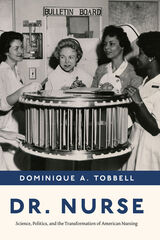 Dr. Nurse: Science, Politics, and the Transformation of American Nursing
Dominique A. Tobbell
University of Chicago Press, 2022 An analysis of the efforts of American nurses to establish nursing as an academic discipline and nurses as valued researchers in the decades after World War II.
Nurses represent the largest segment of the U.S. health care workforce and spend significantly more time with patients than any other member of the health care team. Dr. Nurse probes their history to examine major changes that have taken place in American health care in the second half of the twentieth century. The book reveals how federal and state health and higher education policies shaped education within health professions after World War II.
Starting in the 1950s, academic nurses sought to construct a science of nursing—distinct from that of the related biomedical or behavioral sciences—that would provide the basis for nursing practice. Their efforts transformed nursing’s labor into a valuable site of knowledge production and proved how the application of their knowledge was integral to improving patient outcomes. Exploring the knowledge claims, strategies, and politics involved as academic nurses negotiated their roles and nursing’s future, Dr. Nurse highlights how state-supported health centers have profoundly shaped nursing education and health care delivery.
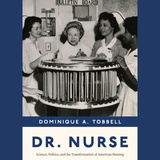 Dr. Nurse: Science, Politics, and the Transformation of American Nursing
Dominique A. Tobbell
University of Chicago Press, 2022 This is an auto-narrated audiobook edition of this book.
An analysis of the efforts of American nurses to establish nursing as an academic discipline and nurses as valued researchers in the decades after World War II.
Nurses represent the largest segment of the U.S. health care workforce and spend significantly more time with patients than any other member of the health care team. Dr. Nurse probes their history to examine major changes that have taken place in American health care in the second half of the twentieth century. The book reveals how federal and state health and higher education policies shaped education within health professions after World War II.
Starting in the 1950s, academic nurses sought to construct a science of nursing—distinct from that of the related biomedical or behavioral sciences—that would provide the basis for nursing practice. Their efforts transformed nursing’s labor into a valuable site of knowledge production and proved how the application of their knowledge was integral to improving patient outcomes. Exploring the knowledge claims, strategies, and politics involved as academic nurses negotiated their roles and nursing’s future, Dr. Nurse highlights how state-supported health centers have profoundly shaped nursing education and health care delivery.
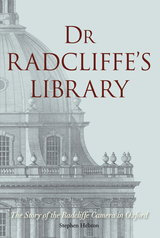 Dr Radcliffe's Library: The Story of the Radcliffe Camera in Oxford
Stephen Hebron
Bodleian Library Publishing, 2014 The Radcliffe Camera is one of the most celebrated buildings in Britain. Named for the physician John Radcliffe—who directed a large part of his fortune to its realization at the heart of the University of Oxford in the early eighteenth century—the circular library is instantly recognizable, its great dome rising amidst the gothic spires of the university.
Drawing on maps, plans, photographs, and drawings, Dr Radcliffe’s Library tells the fascinating story of the building’s creation over more than thirty years. Early designs for the Radcliffe Camera were drawn by the brilliant architect Nicholas Hawksmoor, who conceived the shape so recognizable today: a great rotunda topped by the University of Oxford’s only dome. From there, it would take decades to acquire and clear the site between the University Church of St Mary’s and the Bodleian. After Hawksmoor’s death, the project was taken on by the Scottish architect James Gibbs who refined the design and supervised the library’s construction.
Published to accompany an exhibition opening in November at the Bodleian Library, Dr Radcliffe’s Library tells the fascinating story of the making of this architectural masterpiece.
Dr. Radway's Sarsaparilla Resolvent
Beth Kephart
Temple University Press, 2013 Flavored by the oddities of historic personalities and facts, Dr. Radway’s Sarsaparilla Resolvent is set in Bush Hill, Philadelphia, 1871—home to the Baldwin Locomotive Works and a massive, gothic prison. Acclaimed writer Beth Kephart captures the rhythms and smells of an extraordinary era as William Quinn and his Ma, Essie, grapple with life among terrible accidents, miraculous escapes, and shams masquerading as truth.
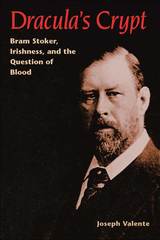 Dracula's Crypt: Bram Stoker, Irishness, and the Question of Blood
Joseph Valente
University of Illinois Press, 2001 Dracula's Crypt unearths the Irish roots of Bram Stoker's gothic masterpiece, offering a fresh interpretation of the author's relationship to his novel and to the politics of blood that consumes its characters.
An ingenious reappraisal of a classic text, Dracula's Crypt presents Stoker's novel as a subtly ironic commentary on England's preoccupation with racial purity. Probing psychobiographical, political, and cultural elements of Stoker's background and milieu, Joseph Valente distinguishes Stoker's viewpoint from that of his virulently racist, hypermasculine vampire hunters, showing how the author's dual Anglo-Celtic heritage and uncertain status as an Irish parvenu among London's theatrical elite led him to espouse a progressive racial ideology at odds with the dominant Anglo-Saxon supremacism. In the light of Stoker's experience, the shabby-genteel Count Dracula can be seen as a doppelgänger, an ambiguous figure who is at once the blood-conscious landed aristocrat and the bloodthirsty foreign invader.
Stoker also confronts gender ideals and their implications, exposing the "inner vampire" in men like Jonathan Harker who dominate and absorb the women who become their wives. Ultimately, Valente argues, the novel celebrates a feminine heroism, personified by Mina Harker, that upholds an ethos of social connectivity against the prevailing obsession with blood as a vehicle of identity.
Revealing a profound and heretofore unrecognized ethical and political message, Dracula's Crypt maintains that the real threat delineated in Dracula is not racial degeneration but the destructive force of racialized anxiety itself. Stoker's novel emerges as a powerful critique of the very anxieties it has previously been taken to express: anxieties concerning the decline of the British empire, the deterioration of Anglo-Saxon culture, and the contamination of the Anglo-Saxon race.
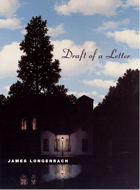 Draft of a Letter
James Longenbach
University of Chicago Press, 2007 From Second Draft: What other people learn From birth, Betrayal, I learned late. My soul perched On an olive branch Combing itself, Waving its plumes. I said Being mortal, I aspire to Mortal things. I need you, Said my soul, If you’re telling the truth. Draft of a Letter is a book about belief—not belief in the unknowable but belief in what seems bewilderingly plain. Pondering the bodies we inhabit, the words we speak, these poems discover infinitude in the most familiar places. The revelation is disorienting and, as a result, these poems talk to themselves, revise themselves, fashioning a dialogue between self and soul that opens outward to include other voices, lovers, children, angels, and ghosts. For James Longenbach, great distance makes the messages we send sweeter. To be divided from ourselves is never to be alone. “If the kingdom is in the sky,” says the body to the soul, “Birds will get there before you.” “In time,” says the awakening soul, “I liked my second / Body better / Than the first.” To live, these poems insist, is to arise every day to the strange magnificence of the people and places we thought we knew best. Draft of a Letter is an unsettled and radiant paradiso, imagined in the death-shadowed, birth-haunted middle of a long life. Praise for Fleet River “A sensibility this cogent, this subtle and austere is rare; even rarer is its proof that poetry still flows through all things and transforms all things in the process.”—Carol Muske-Dukes, Los Angeles Times Book Review
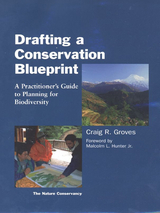 Drafting a Conservation Blueprint: A Practitioner's Guide To Planning For Biodiversity
Craig R. Groves; Foreword by Malcolm L. Hunter Jr.; The Nature Conservancy
Island Press, 2003 Drafting a Conservation Blueprint lays out for the first time in book form a step-by-step planning process for conserving the biological diversity of entire regions. In an engaging and accessible style, the author explains how to develop a regional conservation plan and offers experience-based guidance that brings together relevant information from the fields of ecology, conservation biology, planning, and policy. Individual chapters outline and discuss the main steps of the planning process, including: • an overview of the planning framework
• selecting conservation targets and setting goals
• assessing existing conservation areas and filling information gaps
• assessing population viability and ecological integrity
• selecting and designing a portfolio of conservation areas
• assessing threats and setting priorities A concluding section offers advice on turning conservation plans into action, along with specific examples from around the world. The book brings together a wide range of information about conservation planning that is grounded in both a strong scientific foundation and in the realities of implementation.
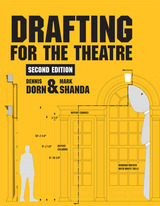 Drafting for the Theatre
Dennis Dorn and Mark Shanda
Southern Illinois University Press, 2012 In this newly revised second edition, veteran stage designers and technical directors Dennis Dorn and Mark Shanda introduce industry-standard drafting and designing practices with step-by-step discussions, illustrations, worksheets, and problems to help students develop and refine drafting and other related skills needed for entertainment set production work. By incorporating the foundational principles of both hand- and computer-drafting approaches throughout the entire book, the authors illustrate how to create clear and detailed drawings that advance the production process.
Early chapters focus on the basics of geometric constructions, orthographic techniques, soft-line sketching applications, lettering, and dimensioning. Later chapters discuss real-life applications of production drawing and ancillary skills such as time and material estimation and shop-drawing nomenclature. Two chapters detail a series of design and shop drawings required to mount a specific design project, providing a guided path through both phases of the design/construction process. Most chapters conclude with one or more worksheets or problems that provide readers with an opportunity to test their understanding of the material presented.
The authors' discussion of universal CAD principles throughout the manuscript provides a valuable foundation that can be used in any computer-based design, regardless of the software. Dorn and Shanda treat the computer as another drawing tool, like the pencil or T-square, but one that can help a knowledgeable drafter potentially increase personal productivity and accuracy when compared to traditional hand-drafting techniques.
Drafting for the Theatre, second edition assembles in one book all the principal types of drawings, techniques, and conventional wisdom necessary for the production of scenic drafting, design, and shop drawings. It is richly illustrated with numerous production examples and is fully indexed to assist students and technicians in finding important information. It is structured to support a college-level course in drafting, but will also serve as a handy reference for the working theatre professional.
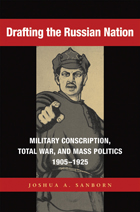 Drafting the Russian Nation: Military Conscription, Total War, and Mass Politics, 1905-1925
Joshua A. Sanborn
Northern Illinois University Press, 2011
How did Russia develop a modern national identity, and what role did the military play? Sanborn examines tsarist and Soviet armies of the early twentieth century to show how military conscription helped to bind citizens and soldiers into a modern political community. The experience of total war, he shows, provided the means by which this multiethnic and multiclass community was constructed and tested.
Drafting the Russian Nation is the first archivally based study of the relationship between military conscription and nation-building in a European country. Stressing the importance of violence to national political consciousness, Sanborn shows how national identity was formed and maintained through the organized practice of violence. The cultural dimensions of the "military body" are explored as well, especially in relation to the nationalization of masculinity.
The process of nation-building set in motion by military reformers culminated in World War I, when ethnically diverse conscripts fought together in total war to preserve their national territory. In the ensuing Civil War, the army's effort was directed mainly toward killing the political opposition within the "nation." While these complex conflicts enabled the Bolsheviks to rise to power, the massive violence of war even more fundamentally constituted national political life.
Not all minorities were easily assimilated. The attempt to conscript natives of Central Asia for military service in 1916 proved disastrous, for example. Jews, also identified as non-nationals, were conscripted but suffered intense discrimination within the armed forces because they were deemed to be inherently unreliable and potentially disloyal.
Drafting the Russian Nation is rich with insights into the relation of war to national life. Students of war and society in the twentieth century will find much of interest in this provocative study.
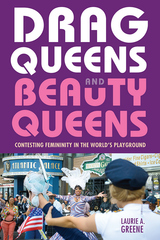 Drag Queens and Beauty Queens: Contesting Femininity in the World's Playground
Laurie Greene
Rutgers University Press, 2021 The Miss America pageant has been held in Atlantic City for the past hundred years, helping to promote the city as a tourist destination. But just a few streets away, the city hosts a smaller event that, in its own way, is equally vital to the local community: the Miss’d America drag pageant.
Drag Queens and Beauty Queens presents a vivid ethnography of the Miss’d America pageant and the gay neighborhood from which it emerged in the early 1990s as a moment of campy celebration in the midst of the AIDS crisis. It examines how the pageant strengthened community bonds and activism, as well as how it has changed now that Rupaul’s Drag Race has brought many of its practices into the cultural mainstream. Comparing the Miss’d America pageant with its glitzy cisgender big sister, anthropologist Laurie Greene discovers how the two pageants have influenced each other in unexpected ways.
Drag Queens and Beauty Queens deepens our understanding of how femininity is performed at pageants, exploring the various ways that both the Miss’d America and Miss America pageants have negotiated between embracing and critiquing traditional gender roles. Ultimately, it celebrates the rich tradition of drag performance and the community it engenders.
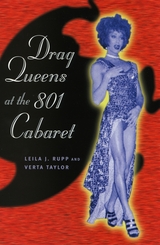 Drag Queens at the 801 Cabaret
Leila J. Rupp and Verta Taylor
University of Chicago Press, 2003 It's Saturday night in Key West and the Girlie Show is about to begin at the 801 Cabaret. The girls have been outside on the sidewalk all evening, seducing passersby into coming in for the show. The club itself is packed tonight and smoke has filled the room. When the lights finally go down, statuesque blonds and stunning brunettes sporting black leather miniskirts, stiletto heels, and see-through lingerie take the stage. En Vogue's "Free Your Mind" blares on the house stereo. The crowd roars in approval.
In this lively book, Leila J. Rupp and Verta Taylor take us on an entertaining tour through one of America's most overlooked subcultures: the world of the drag queen. They offer a penetrating glimpse into the lives of the 801 Girls, the troupe of queens who perform nightly at the 801 Cabaret for tourists and locals. Weaving together their fascinating life stories, their lavish costumes and eclectic music, their flamboyance and bitchiness, and their bawdy exchanges with one another and their audiences, the authors explore how drag queens smash the boundaries between gay and straight, man and woman, to make people think more deeply and realistically about sex and gender in America today. They also consider how the queens create a space that encourages camaraderie and acceptance among everyday people, no matter what their sexual preferences might be.
Based on countless interviews with more than a dozen drag queens, more than three years of attendance at their outrageous performances, and even the authors' participation in the shows themselves, Drag Queens at the 801 Cabaret is a witty and poignant portrait of gay life and culture. When they said life is a cabaret, they clearly meant the 801.
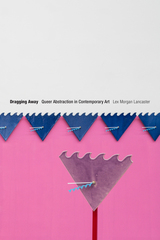 Dragging Away: Queer Abstraction in Contemporary Art
Lex Morgan Lancaster
Duke University Press, 2022 In Dragging Away Lex Morgan Lancaster traces the formal and material innovations of contemporary queer and feminist artists, showing how they use abstraction as a queering tactic for social and political ends. Through a process Lancaster theorizes as a drag—dragging past aesthetics into the present and reworking them while pulling their work away from direct representation—these artists reimagine midcentury forms of abstraction and expose the violence of the tendency to reduce abstract form to a bodily sign or biographical symbolism. Lancaster outlines how the geometric enamel objects, grid paintings, vibrant color, and expansive installations of artists ranging from Ulrike Müller, Nancy Brooks Brody, and Lorna Simpson to Linda Besemer, Sheila Pepe, and Shinique Smith offer direct challenges to representational and categorical legibility. In so doing, Lancaster demonstrates that abstraction is not apolitical, neutral, or universal; it is a form of social praxis that actively contributes to queer, feminist, critical race, trans, and crip politics.
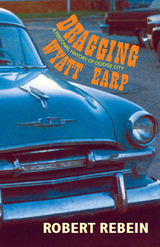 Dragging Wyatt Earp: A Personal History of Dodge City
Robert Rebein
Ohio University Press, 2013 In Dragging Wyatt Earp essayist Robert Rebein explores what it means to grow up in, leave, and ultimately return to the iconic Western town of Dodge City, Kansas. In chapters ranging from memoir to reportage to revisionist history, Rebein contrasts his hometown’s Old West heritage with a New West reality that includes salvage yards, beefpacking plants, and bored teenagers cruising up and down Wyatt Earp Boulevard. Along the way, Rebein covers a vast expanse of place and time and revisits a number of Western myths, including those surrounding Francisco Vasquez de Coronado, the Cheyenne chief Black Kettle, George Armstrong Custer, and of course Wyatt Earp himself. Rebein rides a bronc in a rodeo, spends a day as a pen rider at a local feedlot, and attempts to “buck the tiger” at Dodge City’s new Boot Hill Casino and Resort. Funny and incisive, Dragging Wyatt Earp is an exciting new entry in what is sometimes called the nonfiction of place. It is a must- read for anyone interested in Western history, contemporary memoir, or the collision of Old and New West on the High Plains of Kansas.
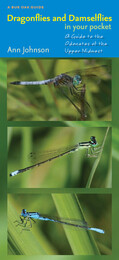 Dragonflies and Damselflies in Your Pocket: A Guide to the Odonates of the Upper Midwest
Ann Johnson
University of Iowa Press, 2009 Just as more and more people enjoy watching birds and butterflies, watching the many shimmering dragonflies and damselflies—collectively called odonates, from Odonata, the name of this order of aquatic insects—has become a popular pastime. Now Dragonflies and Damselflies in Your Pocket introduces us to 50 of the showiest odonates of the Upper Midwest. Ann Johnson’s text is clear and informative and her photographs are stunning; it is impossible to look at them without wanting to head out for the nearest stream and search for the living insects. In addition to providing useful general information about broad-winged damsels, spreadwings, pond damsels, darners, clubtails, cruisers, emeralds, and skimmers, she includes common and scientific names, sizes, general flight seasons, and the best habitats in which to find each species: rocky rivers, wetlands, ponds, still waters, and so on. With their extremely large eyes, elongated transparent wings, long and slender abdomens, and prehensile extendible jaws, dragonflies and damselflies are efficient hunters and quick, darting fliers. Their beauty and their behavior make them delightful subjects for birdwatchers and other nature lovers. Dragonflies and Damselflies in Your Pocket will greatly enhance your appreciation of these winged marvels.
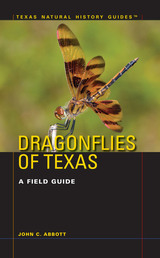 Dragonflies of Texas: A Field Guide
By John C. Abbott
University of Texas Press, 2015 Dragonflies and damselflies (together known as Odonata) are among the most remarkably distinctive insects in their appearance and biology, and they have become some of the most popular creatures sought by avocational naturalists. Texas hosts 160 species of dragonflies, nearly half of the 327 species known in North America, making the state a particularly good place to observe dragonflies in their natural habitats. Dragonflies of Texas is the definitive field guide to these insects. It covers all 160 species with in situ photographs and detailed anatomical images as needed. Each species is given a two-page spread that includes photographs of both sexes and known variations when possible, key features, a distribution map, identification, discussion of similar species, status in Texas, habitat, seasonality, and general comments. Many of the groups also have comparative plates that show anatomically distinctive characteristics. In addition to the species accounts, John Abbott discusses dragonfly anatomy, life history, conservation, names, and photography. He also provides information on species that may eventually be discovered in Texas, state and global conservation rankings, seasonality of all species in chronological order, and additional resources and publications on the identification of dragonflies.
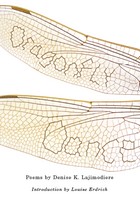 Dragonfly Dance
Denise K. Lajimodiere
Michigan State University Press, 2010 Dragonfly Dance is a collection of poems remarkable for their candor and sense of catharsis. Writing from the vantage point of an American Indian women, Denise Lajimodiere opens a door into the lives of Native girls and women. Her poems often reflect the deep tensions between Native culture and white culture.
Reflected in Lajimodiere's poems, life is sometimes beautiful but rarely easy. "The Necklace," the narrator details how her mother repaired a favorite beaded necklace, "her arthritic fingers patiently / threading beads / on the long thin needle, weaving / night after night." When the necklace is finally repaired, she wears it to school where At recess a White boy
ran by, yanked
it off my neck and threw it.
I watched as it ascended
high above the blacktop,
the beads glittered, scattering their light,
a rainbow against gray skies. Unadorned, direct, and often raw, these riveting poems sear their way into our imaginations, inviting us into a world we might never have known. We are richer for the knowledge.
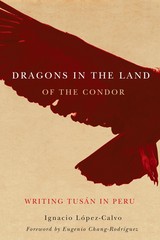 Dragons in the Land of the Condor: Writing Tusán in Peru
Ignacio López-Calvo, Foreword by Eugenio Chang-Rodríguez
University of Arizona Press, 2014 Building on his 2013 study on Nikkei cultural production in Peru, in Dragons in the Land of the Condor Ignacio López-Calvo studies the influence of a Chinese ethnic background in the writing of several twentieth- and twenty-first-century Sino-Peruvian authors.
While authors like Siu Kam Wen and Julia Wong often rely on their Chinese cultural heritage for inspiration, many others, like Pedro Zulen, Mario Wong, and Julio Villanueva Chang, choose other sources of inspiration and identification. López-Calvo studies the different strategies used by these writers to claim either their belonging in the Peruvian national project or their difference as a minority ethnic group within Peru. Whether defending the rights of indigenous Peruvians, revealing the intricacies of a life of self-exploitation among Chinese shopkeepers, exploring their identitarian dilemmas, or re-creating—beyond racial memory—life under the political violence in Lima of the 1980s, these authors provide their community with a voice and a collective agency, while concomitantly repositioning contemporary Peruvian culture as transnational.
López-Calvo bridges from his earlier study of Peruvian Nikkei’s testimonials and literature and raises this question: why are Chinese Peruvian authors seemingly more disconnected from their Asian heritage than Japanese Peruvian authors from theirs? The author argues that the Chinese arrival in Peru half a century earlier influenced a stronger identification with the criollo world. Yet he argues that this situation may soon be changing as the new geopolitical and economic influence of the People’s Republic of China in the world, particularly in Latin America and the Caribbean, affects the way Chinese and Sino–Latin American communities and their cultures are produced and perceived.
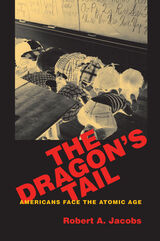 The Dragon's Tail: Americans Face the Atomic Age
Robert A. Jacobs
University of Massachusetts Press, 2010 When President Harry Truman introduced the atomic bomb to the world in 1945, he described it as a God-given harnessing of "the basic power of the universe." Six days later a New York Times editorial framed the dilemma of the new Atomic Age for its readers: "Here the long pilgrimage of man on Earth turns towards darkness or towards light." American nuclear scientists, aware of the dangers their work involved, referred to one of their most critical experiments as "tickling the dragon's tail."
Even after Hiroshima and Nagasaki, most Americans may not have been sure what an atomic bomb was or how it worked. But they did sense that it had fundamentally changed the future of the human race. In this book, Robert Jacobs analyzes the early impact of nuclear weapons on American culture and society. He does so by examining a broad range of stories, or "nuclear narratives," that sought to come to grips with the implications of the bomb's unprecedented and almost unimaginable power.
Beginning with what he calls the "primary nuclear narrative," which depicted atomic power as a critical agent of social change that would either destroy the world or transform it for the better, Jacobs explores a variety of common themes and images related to the destructive power of the bomb, the effects of radiation, and ways of surviving nuclear war. He looks at civil defense pamphlets, magazines, novels, and films to recover the stories the U.S. government told its citizens and soldiers as well as those presented in popular culture.
According to Jacobs, this early period of Cold War nuclear culture—from 1945 to the banning of above-ground testing in 1963—was distinctive for two reasons: not only did atmospheric testing make Americans keenly aware of the presence of nuclear weapons in their lives, but radioactive fallout from the tests also made these weapons a serious threat to public health, separate from yet directly linked to the danger of nuclear war.
Dragstripping: Poems
Jan Beatty
University of Pittsburgh Press, 2024 Dragstripping, Jan Beatty’s seventh collection of poems, takes readers to the literal dragstrip, the metaphorical dragstrip of the body, and the strip club, where the ecstatic is rescripted and where women disappear and reappear in the crosscut of gender. Transgressing into and out of poetic form, Beatty writes the fractured landscape of the unknown woman, breaking rules of grammar and subverting expected speech, mixing the real and unreal, and finding elation in a strange and shifting land.
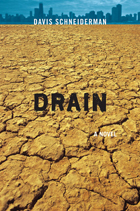 Drain: A Novel
Davis Schneiderman
Northwestern University Press, 2010 It’s the year 2039, and Lake Michigan is mysteriously emptied of water. The planet’s atmosphere and magnetic field are failing, and fires burn ominously throughout the empty lake bed. In this seemingly endless desert east of Chicago, three factions are locked in conflict: the original end-of-times cultist settlers who follow religious visionary Fulcrum Maneuvers and worship a giant World Worm they deem responsible for the drained lake; the megacorporation Quadrilateral, a mega-consumerist, planned-community combine of bourgeois city planners developing what is now called the Wildland-Urban Interface; and the Blackout Angels, landlocked punk pirates raised in Quadrilateral cities, who oppose everything and everyone. In Davis Schneiderman’s shocking novel, Drain, freedom, creativity, and transgression wage war with forces of control, censorship, and conformity. The wordscapes of William S. Burroughs and Thomas Pynchon, the dystopic nightmares of Philip K. Dick, and the transgressive punch of Chuck Palahniuk and Georges Bataille together convene in this stunning and thrilling work.
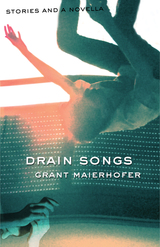 Drain Songs: Stories and a Novella
Grant Maierhofer
University of Alabama Press, 2019 A collection of related stories that deal with the anxiety, pain, and ennui of addiction and withdrawal
Drain Songs gathers five stories and a novella focused on the many trials of modern life—addiction and depression, mania and disorder, attempts and failure at keeping the worst at bay. Grant Maierhofer’s stories focus on characters in varying states of disarray and stuckness, continuing his literary project of analyzing lives on the fringes of sanity and society. The novella “Drain Songs” is a harrowing narrative focused squarely on addiction and recovery, twelve-step programs, and codependency.
In all of these tales, Maierhofer takes a bee’s-eye view of protagonists from all walks of life, from the working class to the academy, from janitors to professors, embodying the commonalities of men and women struggling with very fundamental elements of survival, perspective, and identity—attempts formal and informal to contend with the trials that forever engage and perplex humanity.
His evocative prose conveys both despair and resignation as well as stultifying, brain-deadening routine and repetition. Still, these stories transcend angst and tilt toward agony and ecstasy and the hope of redemption.
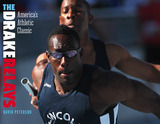 The Drake Relays: America's Athletic Classic
David Peterson
University of Iowa Press, 2014 The Drake Relays are one of the iconic events of track and field in the United States. World and Olympic champions test their speed and stamina on the famed Blue Oval in Des Moines, Iowa, every April, and by spring 2013 they had set fourteen world records and fifty-one American records. But unlike most other top meets, this one also features college athletes from all over the country and high school athletes from across Iowa, giving them the experience of a lifetime—competing on the same track with the elite in their sport. This mix brings many enthusiastic spectators to the stadium and makes for an unusually close bond between fans and athletes—it’s as if everyone’s family is there cheering.
Pulitzer Prize–winning photographer David Peterson has been covering the Drake Relays for nearly forty years, but his love affair with the meet started earlier, when he ran on three winning relay teams there for Kansas State University. Now, drawing upon an unmatched personal archive, he offers the pictures of a lifetime spent on the Blue Oval. He captures on camera athletes of all levels in triumph and defeat, in mid-stride or leap, embracing their fans, their moms and dads, and their kids. In addition to the stars of the past, such as Carl Lewis, Suzy Favor Hamilton, and Herschel Walker, and those of the ’00s, like Lolo Jones and Jeremy Wariner, we see teenagers who may be the stars of the future, as well as the many athletes who will never be famous but nonetheless show themselves—and their sport—at their best.
A beautiful celebration of the Drake Relays and the diverse sports that make up “track and field,” this book will evoke memories and inspire runners, throwers, and jumpers everywhere.
Drama as Text and Performance: Strindberg's and Bergman's Miss Julie
Egil Törnqvist
Amsterdam University Press, 2012 This book is a study of August Strindberg’s famous drama Miss Julie, presented in both Swedish and English. Since it was first performed in 1888, Miss Julie has became one of the most successful plays written by Strindberg, widely considered one of the pioneers of modern drama. The book provides a penetrating analysis of the author’s text, followed by a close investigation of Ingmar Bergman’s much lauded 1985 production at the Royal Dramatic Theatre in Stockholm. Drama as Text and Performance is intended as a paradigmatic illustration of similarities and differences between the two media—textand performance and their recipients, readers and spectators.
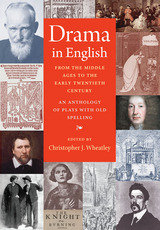 Drama in English From the Middle Ages to the Early Twentieth Century
Christopher J. Wheatley
Catholic University of America Press, 2016 At a time when good editions of drama in English are prohibitively expensive and online texts are unedited and lack the apparatus necessary for students to understand and contextualize the plays, this anthology affordably illustrates every significant genre of drama in the English language from the late fourteenth century to the early twentieth century, with plays from England, Ireland, and the United States of America. The mystery and morality plays of the Middle Ages, Renaissance comedy, tragedy and meta-theater, Restoration and eighteenth-century comedy, tragedy, and ballad opera, nineteenth-century melodrama, and early twentieth century realism and naturalism are all presented with the introductions glossaries and notes suitable for a college level reader by an editor with a quarter of a century of experience teaching courses on the history of drama in English. The plays both reflect their times and critique them, while remaining stageable today. The Wakefield Master, The York Realist, Marlowe, Jonson, Dryden, Wycherley, Gay, Boucicault, Synge, and Shaw are some of the playwrights in this representative collection of plays that reveal both the popular appeal of the English-language theater and the dazzling dramatic artistry it embodied over a period of six centuries. Further the collection is in "old spelling" and is thus a useful sourcebook for those interested in the history of the English language.
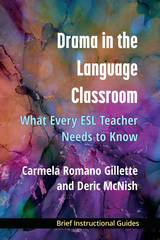 Drama in the Language Classroom: What Every ESL Teacher Needs to Know
Carmela Romano Gillette and Deric McNish
University of Michigan Press, 2019 Drama in the Language Classroom weaves together cutting-edge research and practices from the fields of theater and TESOL. After providing an overview of how drama can be used in the language classroom, Carmela Romano Gillette (a TESOL expert) and Deric McNish (an expert in actor training) present a collection of resources teachers need to begin using drama, including practical classroom-tested and evidence-based techniques. They show how theater, performance, and improvisation can help students build confidence, develop a deeper context for speaking, and create authentic opportunities for language use. In addition, they outline the para- and extra-linguistic techniques that can improve expression and meaningful communication. Each section includes sample activities, such as script analysis for improving fluency, and assessment suggestions. Readers do not need to have experience with performance or drama to learn how to incorporate these practices into the ESL classroom.
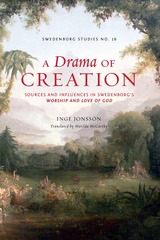 A DRAMA OF CREATION: SOURCES & INFLUENCES IN SWEDENBORG'S WORSHIP & LOVE OF GOD
INGE JONSSON
Swedenborg Foundation Publishers, 2004
The Worship and Love of God is one of the most unusual writings of Swedish scientist and theologian Emanuel Swedenborg (1688-1772). A "poetical novel," it dramatizes the Creation and examines the life of Adam and Eve as the first truly united couple. Considered Swedenborg's last work before he embarked on his visionary period, the manuscript was left unfinished by its author and published only after his death.
Inge Jonsson, one of the world's leading scholars on Swedenborg's works, offers a scholarly look into a neglected literary achievement. He examines this unique work from the perspective of sources and influences. The literary genre f hexaemeron, ancient and modern philosophy, and scientific discoveries in the seventeenth and eighteenth centuries come into play in Swedenborg's richly imagined and beautifully articulated world. Yet The Worship and Love of God also offers an intriguing glimpse into Swedenborg's future as a biblical exegete and revelator.
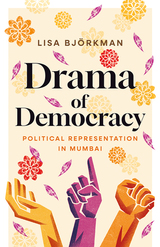 Drama of Democracy: Political Representation in Mumbai
Lisa Björkman
University of Minnesota Press, 2025 The performative arts of political communication and representation in Mumbai
In an era of global political passions, many have wondered whether some sort of natural affinity exists between political style and substance. Does liberal democracy speak the language of rationality and sincerity while political emotion, imagery, and embodiment properly belong to authoritarianism? Taking an ethnographic approach to the relationship between political form and political content, Drama of Democracy explores the material substance of representations (things like heady crowds and rousing images) together with language-based forms of political communication, such as public oration and community meetings.
Drawing on a decade of research in the city of Mumbai, Lisa Björkman shows that embodied performance is the very site and substance of representation and demonstrates how Mumbaikars evaluate performative bids to represent. The ethnographic accounts demonstrate the extraordinary fluency in this evaluative work in Mumbai, where people from all walks of life are remarkably astute at navigating and assessing political signs and representations, endlessly discussing and debating possible meanings of the city’s dense material-semiotic ecologies—whether words or images, cash or crowds, flyers or flowers. In Mumbai, Björkman argues, the evaluative criterion of representation is not whether something is sign or substance, or even whether people are deemed to utter truths or falsehoods. Rather, what matters is whether and how a performance activates and actuates the social relations and political subjectivities that it professes to display. Drama of Democracy highlights Mumbaikars’ communicative fluency and theatrical acumen to offer a conceptual toolbox through which contemporary political churnings around the globe might be understood.
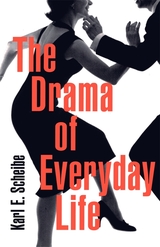 The Drama of Everyday Life
Karl Scheibe
Harvard University Press, 2000 Psychologists, says the old joke, know everything there is to know about the college sophomore and the white rat. But what about the rest of us, older than the former, bigger than the latter, with lives more labyrinthine than either? In this ambitious book, Karl E. Scheibe aims to take psychology out of its rut and bring it into contact with the complex lives that most people quietly live.
Drama, Scheibe reminds us, is no more confined to the theater than religion is to the church or education to the schoolroom. Accordingly, he brings to his reflection on psychology the drama of literature, poetry, philosophy, history, music, and theater. The essence of drama is transformation: the transformation of the quotidian world into something that commands interest and stimulates conversation. It is this dramatic transformation that Scheibe seeks in psychology as he pursues a series of suggestive questions, such as: Why is boredom the central motivational issue of our time? Why are eating and sex the biological foundations of all human dramas? Why is indifference a natural condition, caring a dramatic achievement? Why is schizophrenia disappearing? Why does gambling have cosmic significance?
Writing with elegance and passion, Scheibe asks us to take note of the self-representation, performance, and scripts of the drama that is our everyday life. In doing so, he challenges our dispirited senses and awakens psychology to a new realm of dramatic possibility.
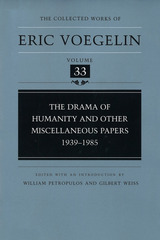 The Drama of Humanity and Other Miscellaneous Papers, 1939-1985 (CW33)
Eric Voegelin, Edited & Intro by William Petropulos & Gilbert Weiss
University of Missouri Press, 2004 This second volume of Eric Voegelin’s miscellaneous papers contains unpublished writings from the time of his forced emigration from Austria in 1938 until his death in 1985. The volume’s focus is on dialogue and discussion, presenting Voegelin in the role of lecturer, discussant, and respondent. “The Drama of Humanity” presents the Walter Turner Candler Lectures delivered in four parts at Emory University in 1967. This text, a small book in itself, addresses the themes of “The Contemporary Situation,” “Man in the Cosmos,” “The Epiphany of Man,” and “Man in Revolt,” providing the reader with a good introduction to Voegelin’s later work. Another extensive text included in this volume is “Conversations with Eric Voegelin at the Thomas More Institute” in Montreal. These exchanges include lectures and discussions given by Voegelin between 1967 and 1976. A number of other sections offer insight into Voegelin’s intellectual development over a period of forty years. These include the complete “Foreword” to the second edition of The Political Religions, which is published here for the first time; “Notes on T. S. Eliot’s Four Quartets;” the “Cycle Theory and Disintegrations;” “What Is Political Theory?;” “The Spiritual and Political Future of the Western World;” “Notes on ‘Civilization and Foreign Affairs;’” “Structures of Consciousness;” “The Beyond and Its Parousia;” and the 1983 “Responses at the Panel Discussion of ‘The Beginning of the Beginning.’” Several lengthy excerpts from conference dialogues with other scholars are also included: “The West and the Meaning of Industrial Society,” “Natural Law in Political Theory,” and “Man in Political Institutions.” Volume 33 concludes with Voegelin’s “Autobiographical Statement at the Age of Eighty-Two,” his last public utterance on the course of his life and his life’s work. By choosing dialogue as the focus of this volume, Petropulos and Weiss are able to show not only the extent to which Voegelin engaged in an exchange of ideas but also his abiding concern for the practical and theoretical conditions necessary in order for this exchange to take place.
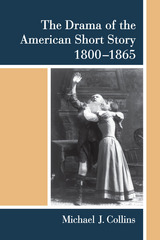 The Drama of the American Short Story, 1800-1865
Michael J. Collins
University of Michigan Press, 2016 The Drama of the American Short Story, 1800–1865 argues that to truly understand the short story form, one must look at how it was shaped by the lively, chaotic, and deeply politicized world of 19th-century transatlantic theater and performance culture. By resurrecting long-neglected theatrical influences on representative works of short fiction, Michael J. Collins demonstrates that it was the unruly culture of the stage that first energized this most significant of American art forms. Whether it was Washington Irving’s first job as theater critic, Melville’s politically controversial love of British drama, Alcott’s thwarted dreams of stage stardom, Poe and Lippard’s dramatizations of peculiarly bloodthirsty fraternity hazings, or Hawthorne’s fascination with automata, theater was a key imaginative site for the major pioneers of the American short story.
The book shows how perspectives from theater studies, anthropology, and performance studies can enrich readings of the short-story form. Moving beyond arbitrary distinctions between performance and text, it suggests that this literature had a social life and was engaged with questions of circumatlantic and transnational culture. It suggests that the short story itself was never conceived as a nationalist literary form, but worked by mobilizing cosmopolitan connections and meanings. In so doing, the book resurrects a neglected history of American Federalism and its connections to British literary forms.
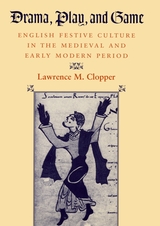 Drama, Play, and Game: English Festive Culture in the Medieval and Early Modern Period
Lawrence M. Clopper
University of Chicago Press, 2001 How was it possible for drama, especially biblical representations, to appear in the Christian West given the church's condemnation of the theatrum of the ancient world?In a book with radical implications for the study of medieval literature, Lawrence Clopper resolves this perplexing question.
Drama, Play, and Game demonstrates that the theatrum repudiated by medieval clerics was not "theater" as we understand the term today. Clopper contends that critics have misrepresented Western stage history because they have assumed that theatrum designates a place where drama is performed. While theatrum was thought of as a site of spectacle during the Middle Ages, the term was more closely connected with immodest behavior and lurid forms of festive culture. Clerics were not opposed to liturgical representations in churches, but they strove ardently to suppress May games, ludi, festivals, and liturgical parodies. Medieval drama, then, stemmed from a more vernacular tradition than previously acknowledged-one developed by England's laity outside the boundaries of clerical rule.
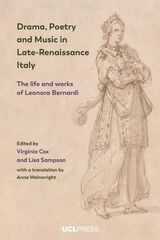 Drama, Poetry and Music in Late-Renaissance Italy: The Life and Works of Leonora Bernardi
Virginia Cox and Lisa Sampson
University College London, 2023 The first-ever study of Leonora Bernardi’s life along with a modern edition of her recently discovered literary corpus.
Leonora Bernardi (1559–1616), a gentlewoman of Lucca, was a highly regarded poet, dramatist, and singer. She was active in the brilliant courts of Ferrara and Florence at a time when creative women enjoyed exceptional visibility in Italy. Like many such figures, she has since suffered historical neglect. Drama, Poetry and Music in Late-Renaissance Italy presents the first-ever study of Bernardi’s life along with a modern edition of her recently discovered literary corpus, which mostly exists in manuscripts. Her writings are presented in the original Italian with new English translations, scholarly notes, and critical essays. Based on new archival research, the substantial opening section reconstructs Bernardi’s unusually colorful life. The second major section presents her pastoral tragicomedy Clorilli, one of the earliest secular dramatic works by a woman. The third section presents Bernardi’s secular and religious verse, which engaged with new trends in lyric and poetry for music, and was set by various key composers across Italy. The volume thus firmly positions Leonora Bernardi as a distinctive voice and dynamic player in the extraordinarily rich social, cultural, and geo-political networks of late-Renaissance Italy.
 The Drama Therapy Decision Tree, 2nd Edition: Connecting Drama Therapy Interventions to Treatment
Edited by Paige Dickinson and Sally Bailey
Intellect Books, 2024 A second edition of a practical guide for therapeutic decision-making.
The Drama Therapy Decision Tree unites therapy interventions with diagnostic information, individual and group processes, psychological distance, the drama therapy pie, and global outcomes. Rather than using a standardized protocol that makes the decisions for the therapist, drama therapy is based on dynamic, embodied, creative action with participants in the here and now. Conscious planning on the part of the drama therapist before the session supports spontaneity and creativity, preparing them to make good therapeutic decisions in the moment during the session.
The authors strive to provide a common language for communicating what drama therapists do and how they do it in order to demystify drama therapy for other mental health and medical professionals. Using the decision tree as a guide, early career drama therapists can move forward confidently and ground their work with participants in an integrated system.
 The Drama Therapy Decision Tree: Connecting Drama Therapy Interventions to Treatment
Edited by Paige Dickinson and Sally Bailey
Intellect Books, 2020
The Drama Therapy Decision Tree provides an integrated model for therapeutic decision-making by deconstructing the processes of choosing drama therapy interventions. The authors strive to provide a common language for communicating what drama therapists do in terms of diagnoses and interventions, especially for students and early career professionals in the field.
The book provides a systematic method for drama therapists and drama therapy students to use to determine the most appropriate therapy technique for clients. Paige Dickinson and Sally Bailey have identified and analyzed their own experiences with the task, and here they explain how to put learned theory into practice. In doing so, they provide early career drama therapy professionals a reliable and effective tool for making clinical decisions and offer practitioners a point of reference in addressing the socio-emotional needs of their clients.
The authors explain the basic tools drama therapists use in therapy situations, identify the core healing concepts of the practice, discuss the basic treatment planning process, and explain how these components are used together to identify an appropriate type of intervention for the client. They also offer examples of how this system can be applied to a variety of common diagnoses, and the appendices provide resources to connect drama therapy interventions to global treatment outcomes.
Drama-based Pedagogy: Activating Learning Across the Curriculum
Kathryn Dawson and Bridget Kiger Lee
Intellect Books, 1995 Drama-based Pedagogy examines the mutually beneficial relationship between drama and education, championing the versatility of drama-based teaching and learning designed in conjunction with classroom curricula. Written by seasoned educators and based upon their own extensive experience in diverse learning contexts, this book bridges the gap between theories of drama in education and classroom practice.
Kathryn Dawson and Bridget Kiger Lee provide an extensive range of tried and tested strategies, planning processes, and learning experiences, in order to create a uniquely accessible manual for those who work, think, train, and learn in educational and/or artistic settings. It is the perfect companion for professional development and university courses, as well as for already established educators who wish to increase student engagement and ownership of learning.
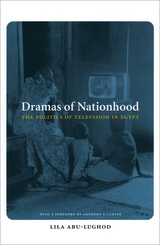 Dramas of Nationhood: The Politics of Television in Egypt
Lila Abu-Lughod
University of Chicago Press, 2004 How do people come to think of themselves as part of a nation? Dramas of Nationhood identifies a fantastic cultural form that binds together the Egyptian nation—television serials. These melodramatic programs—like soap operas but more closely tied to political and social issues than their Western counterparts—have been shown on television in Egypt for more than thirty years. In this book, Lila Abu-Lughod examines the shifting politics of these serials and the way their contents both reflect and seek to direct the changing course of Islam, gender relations, and everyday life in this Middle Eastern nation.
Representing a decade's worth of research, Dramas of Nationhood makes a case for the importance of studying television to answer larger questions about culture, power, and modern self-fashionings. Abu-Lughod explores the elements of developmentalist ideology and the visions of national progress that once dominated Egyptian television—now experiencing a crisis. She discusses the broadcasts in rich detail, from the generic emotional qualities of TV serials and the depictions of authentic national culture, to the debates inflamed by their deliberate strategies for combating religious extremism.
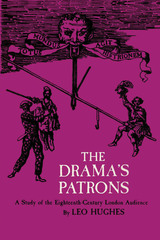 The Drama's Patrons: A Study of the Eighteenth-Century London Audience
By Leo Hughes
University of Texas Press, 1971 The drama's laws,
the drama's patrons give,
For we that live to please,
must please to live.
—Samuel Johnson, 1747 Democratic ferment, responsible for political explosions in the seventeenth century and expanded power in the eighteenth, affected all phases of English life. The theatre reflected these forces in the content of the plays of the period and in an increased awareness among playgoers that the theatre "must please to live." Drawing from a wealth of amusing and informative contemporary accounts, Leo Hughes presents abundant evidence that the theatre-going public proved zealous, and sometimes even unruly, in asserting its role and rights. He describes numerous species of individual pest—the box-lobby saunterers, the vizard masks (ladies of uncertain virtue), the catcallers, and the weeping sentimentalists. Protest demonstrations of various interest groups, such as footmen asserting their rights to sit in the upper gallery, reflect the behavior of the audience as a whole—an audience that Alexander Pope described as "the manyheaded monster of the pit." Hughes analyzes the changes in the audience's taste through the long span from Dryden's day to Sheridan's. He illustrates the decline in taste from the sophisticated, if bawdy, comedy of the Restoration Period to the sentimentalism and empty show of later decades. He attributes the increased emphasis on sentiment and spectacle to audience influence and describes the effects of audience demands on managers, playwrights, and players. He describes in detail the mixed assembly that frequented the theatre during this period and the greatly enlarged theatres that were built to accommodate it. Hughes concludes that it was the English people's basic love of liberty that allowed them to accept audience disruptions considered intolerable by foreign visitors and that the drama's patrons greatly influenced the quality of theatrical production during this long period.
 The Dramatic Craftsmanship of Moreto
Frank P. Casa
Harvard University Press The theater of Agustín Moreto y Cavana (1618–1669) badly needs reevaluation. Present estimation of the work of this Spanish playwright has frozen into a sterile pattern of praise for his technical skill and disapproval of his borrowings. There has been uncritical acceptance of the contention that Moreto's plays are simple reworkings, and no real effort has been made to assess the relevance of this generally accepted belief.
The road to a fair estimation and appreciation of Moreto, Frank Casa believes, is through a rigorous investigation of his plays and their sources. To achieve this purpose he has carefully selected five different comedias, of varying degrees of indebtedness to earlier works: a hagiographic play, San Franco de Sena; El licenciado Vidriera, based on Cervantes' short story; a reinterpretation of a classical theme, Antíoco y Seleuco; a reworked drama, El valiente justiciero; and the comedy El lindo don Diego. In each case he analyzes the original, then the Moreto version, pointing out differences in characterization, attitudes, dramatic elaboration, and themes. Casa proves that, in spite of their similarity to works of predecessors, Moreto's plays should be considered independent literary creations and their author a dramatist with a high degree of artistic integrity.
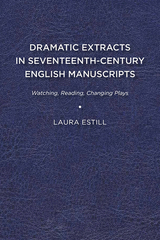 Dramatic Extracts in Seventeenth-Century English Manuscripts: Watching, Reading, Changing Plays
Laura Estill
University of Delaware Press, 2015 Throughout the seventeenth century, early modern play readers and playgoers copied dramatic extracts (selections from plays and masques) into their commonplace books, verse miscellanies, diaries, and songbooks. Dramatic Extracts in Seventeenth-Century English Manuscripts: Watching, Reading, Changing Plays is the first to examine these often overlooked texts, which reveal what early modern audiences and readers took, literally and figuratively, from plays. As this under-examined archival evidence shows, play readers and playgoers viewed plays as malleable and modular texts to be altered, appropriated, and, most importantly, used. These records provide information that is not available in other forms about the popularity and importance of early modern plays, the reasons plays appealed to their audiences, and the ideas in plays that most interested audiences. Tracing the course of dramatic extracting from the earliest stages in the 1590s, through the prolific manuscript circulation at the universities, to the closure and reopening of the theatres, Estill gathers these microhistories to create a comprehensive overview of seventeenth-century dramatic extracts and the culture of extracting from plays. Dramatic Extracts in Seventeenth-Century English Manuscripts: Watching, Reading, Changing Plays explores new archival evidence (from John Milton’s signature to unpublished university plays) while also analyzing the popularity of perennial favorites such as Shakespeare’s The Tempest. The study of dramatic extracts is the study of particulars: particular readers, particular manuscripts, particular plays or masques, particular historic moments. As D. F. McKenzie puts it, “different readers [bring] the text to life in different ways.” By providing careful analyses of these rich source texts, this book shows how active play-viewing and play-reading (that is, extracting) ultimately led to changing the plays themselves, both through selecting and manipulating the extracts and positioning the plays in new contexts. Published by University of Delaware Press. Distributed worldwide by Rutgers University Press.
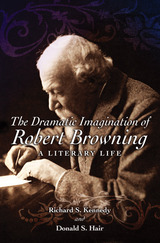 The Dramatic Imagination of Robert Browning: A Literary Life
Richard S. Kennedy & Donald S. Hair
University of Missouri Press, 2007
The Dramatic Imagination of Robert Browning offers an accessible and authoritative guide to the essentials of Robert Browning’s life and poetry. Drawing from his personal letters and from the diaries and memoirs of his contemporaries, this literary biography provides a wealth of information about the main events of his life, including the social, political, religious, and aesthetic issues that concerned him; it offers critical commentary defining the central characteristics of his poetry; and it tracks the changes in his reputation through contemporary reviews and the growth of the Browning societies.
An English poet who was deeply responsive to European culture and affairs, Robert Browning has sometimes been dismissed by modern readers for his obscurity or roughness of language. Now two distinguished scholars of Browning’s work trace the arc of his development as an artist and thinker from his earliest poems to the last in his long and remarkably productive career.
The authors illustrate how Browning moved from describing “incidents in the development of a soul,” to developing his reader’s soul as collaborator in the artistic process, to the development of his own soul in the making of poetry. Through a fresh reading of not only his poetry but also the letters of both Robert and Elizabeth Barrett Browning, they have garnered details that situate the two in historical context, provide a vivid sense of Robert’s personality, and also correct biases against Elizabeth’s influence. Their critical commentary focuses on the poet’s dramatic imagination and argues that his extensive body of work after The Ring and the Book—often dismissed as evidencing a decline in his poetic powers—represented new directions in his poetry marked by inventive dialogue, verbal puzzles, and virtuoso rhyming.
Written to appeal to both general readers and scholars, the book will enable anyone to read Browning’s poems with a firm sense of the subjects and practices that are central to his texts, along with a knowledge of their context in the poet’s life and thought. The Dramatic Imagination of Robert Browning invites readers of a singular body of poetry to achieve a new understanding of Browning’s work and a greater appreciation of his life.
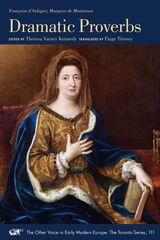 Dramatic Proverbs
Françoise d’Aubigné, Marquise de Maintenon
Iter Press, 2025 This translated edition of Madame de Maintenon’s school plays showcases their emphasis on the importance of girls’ self-reliance and resilience in an accessible and engaging format for modern students.
Madame de Maintenon’s Dramatic Proverbs provides unprecedented access to an important transitional marker between the society games of the salon and the education theater of the eighteenth century. Composed for the impoverished female pupils at the boarding school she and King Louis XIV founded at Saint-Cyr, Maintenon’s dramatic proverbs crucially reveal the values emphasized in female education at the end of the seventeenth century—a period plagued by economic crisis and growing aristocratic poverty. Some of the first to exclusively express a woman’s point of view, Maintenon’s dramatic proverbs challenged traditional female education and promoted improved conditions for women. The proverbs contributed uniquely to improvisational educational theater, inaugurating a tradition that continued well into the eighteenth century.
This edition of the plays aims to privilege accessibility and accuracy so that twenty-first-century students can act out, interpret, and discuss these historical texts.
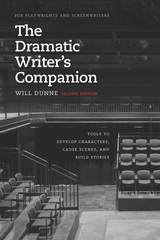 The Dramatic Writer's Companion, Second Edition: Tools to Develop Characters, Cause Scenes, and Build Stories
Will Dunne
University of Chicago Press, 2017 In just eight years, The Dramatic Writer’s Companion has become a classic among playwrights and screenwriters. Thousands have used its self-contained character, scene, and story exercises to spark creativity, hone their writing, and improve their scripts.
Having spent decades working with dramatists to refine and expand their existing plays and screenplays, Dunne effortlessly blends condensed dramatic theory with specific action steps—over sixty workshop-tested exercises that can be adapted to virtually any individual writing process and dramatic script. Dunne’s in-depth method is both instinctual and intellectual, allowing writers to discover new actions for their characters and new directions for their stories. The exercises can be used by those just starting the writing process and by those who have scripts already in development. With each exercise rooted in real-life issues from Dunne’s workshops, readers of this companion will find the combined experiences of more than fifteen hundred workshops in a single guide.
This second edition is fully aligned with a brand-new companion book, Character, Scene, and Story, which offers forty-two additional activities to help writers more fully develop their scripts. The two books include cross-references between related exercises, though each volume can also stand alone.
No ordinary guide to plotting, this handbook centers on the principle that character is key. “The character is not something added to the scene or to the story,” writes Dunne. “Rather, the character is the scene. The character is the story.” With this new edition, Dunne’s remarkable creative method will continue to be the go-to source for anyone hoping to take their story to the stage.
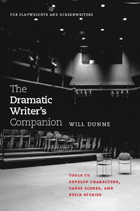 The Dramatic Writer's Companion: Tools to Develop Characters, Cause Scenes, and Build Stories
Will Dunne
University of Chicago Press, 2009
Moss Hart once said that you never really learn how to write a play; you only learn how to write this play. Crafted with that adage in mind, The Dramatic Writer’s Companion is designed to help writers explore their own ideas in order to develop the script in front of them. No ordinary guide to plotting, this handbook starts with the principle that character is key. “The character is not something added to the scene or to the story,” writes author Will Dunne. “Rather, the character is the scene. The character is the story.”
Having spent decades working with dramatists to refine and expand their existing plays and screenplays, Dunne effortlessly blends condensed dramatic theory with specific action steps—over sixty workshop-tested exercises that can be adapted to virtually any individual writing process and dramatic script. Dunne’s in-depth method is both instinctual and intellectual, allowing writers to discover new actions for their characters and new directions for their stories.
Dunne’s own experience is a crucial element of this guide. His plays have been selected by the Eugene O’Neill Theatre Center for three U.S. National Playwrights Conferences and have earned numerous honors, including a Charles MacArthur Fellowship, four Bay Area Theatre Critics Circle Awards, and two Drama-Logue Playwriting Awards. Thousands of individuals have already benefited from his workshops, and The Dramatic Writer’s Companion promises to bring his remarkable creative method to an even wider audience.
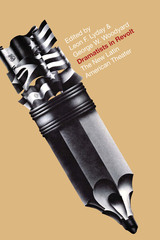 Dramatists in Revolt: The New Latin American Theater
Edited by Leon F. Lyday and George W. Woodyard
University of Texas Press, 1976 Dramatists in Revolt, through studies of the major playwrights, explores significant movements in Latin American theater. Playwrights discussed are those who have made outstanding contributions to Latin American theater during the post–World War II period and who have been particularly sensitive to world currents in literature and drama, while being acutely responsive to the problems of their own areas. They express concern about communication, isolation, and solitude. On a more basic level, they concern themselves with the political and socioeconomic problems that figure importantly in the Third World. The fifteen essays deal with the playwrights Antón Arrufat and José Triana (Cuba); Emilio Carballido and Luisa Josefina Hernández (Mexico); Agustín Cuzzani, Osvaldo Dragún, Griselda Gambaro, and Carlos Gorostiza (Argentina); Jorge Díaz, Egon Wolff, and Luis Alberto Heiremans (Chile); René Marqués (Puerto Rico); and Jorge Andrade, Alfredo Dias Gomes, and Plínio Marcos (Brazil). These are dramatists in revolt, sometimes in a thematic sense, not only in protesting the indignities that various systems impose on modern man, but also in a dramatic configuration. They dare to experiment with techniques in the constant search for viable theatrical forms. Each essay is written by a specialist familiar with the works of the playwright under consideration. In addition to the essays, the book includes a listing of source materials on Latin American theater.
Dramatizing Dementia: Madness In The Plays Of Tennessee Williams
Jacqueline O'Connor
University of Wisconsin Press, 1997 Jacqueline O’Connor examines how Tennessee Williams portrayed society’s treatment of the mentally ill. The critical approach is eclectic and the author draws on a variety of psychological, literary, and biographical sources.
Dramatizing Dido, Circe, and Griselda
Louise-Geneviève Gillot de Sainctonge
Iter Press, 2010 One of the most acclaimed French poets from the turn of the eighteenth century and one of the rare women of the time to achieve recognition at court, Louise-Geneviève Gillot de Sainctonge was France’s first female librettist. The current volume provides not only the most in-depth biography of her ever published, but also the first appearance of any of her work in English. It features her two tragic opera libretti, both of which were set to music and staged at the Opéra, a spoken play that constitutes an important precursor of tearful comedy, and a small sampling of her poetry. The three dramatic works give thoughtful portrayals of women of high rank who exemplify traits such as fidelity, integrity and forthrightness, only to find themselves powerless in a misogynist society, where the male heroes turn out to be inglorious.
—Perry Gethner
Norris Professor of French, Oklahoma State University
Dramaturging Personal Narratives: Who Am I and Where Is Here?
Judith Rudakoff
Intellect Books, 2015 How do people identify, locate, or express home? Displaced, exiled, colonized, and disenfranchised people the world over grapple with this question. Dramaturging Personal Narratives explores the relationship between personal and cultural identity by investigating how people perceive and creatively express self, home, and homeland through showcasing a variety of innovative artistic processes and resulting projects. Written in clear and accessible language, this book will appeal to professional and community-based artists who work in a wide variety of genres, scholars from creative fields, and both students and teachers at all levels of education who are interested in learning more about generating, developing, and disseminating artistic work inspired by personal narratives.
Dramaturgy: An Introduction
Cock Dieleman
Amsterdam University Press, 2021 The image of the dramaturg resembling a stuffy librarian, as opposed to the largely intuitive process of theatre making, belongs to the past. Contemporary theatre performances not only tell a story, but constantly reflect on the world in which that story takes place and is shown. As a result, dramaturgy has become part of the artistic process. Thus everybody involved in a theatre production is concerned with dramaturgical thinking, i.e. how to relate to material, process, audience and society. The dramaturg crosses borders between theory and practice, between theatre makers, performance and audience.
'Dramaturgy. An Introduction' provides a broad overview of the concept of dramaturgy and the profession of the dramaturg. It is intended for students and teachers of theatre and performance studies, but also for directors, scenographers, actors and for all lovers of theatre.
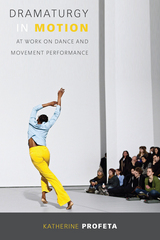 Dramaturgy in Motion: At Work on Dance and Movement Performance
Katherine Profeta
University of Wisconsin Press, 2015 Dramaturgy in Motion innovatively examines the work of the dramaturg in contemporary dance and movement performance. Katherine Profeta, a working dramaturg for more than fifteen years, shifts the focus from asking “Who is the dramaturg?” to “What does the dramaturg think about?”
Profeta explores five arenas for the dramaturg’s attention—text and language, research, audience, movement, and interculturalism. Drawing on her extended collaboration with choreographer and visual artist Ralph Lemon, she grounds her thinking in actual rehearsal-room examples and situates practice within theoretical discourse about contemporary dramaturgy. Moving between theory and practice, word and movement, question and answer until these distinctions blur, she develops the foundational concept of dramaturgical labor as a quality of motion.
Dramaturgy in Motion will be invaluable to practitioners and scholars interested in the processes of creating contemporary dance and movement performance—particularly artists wondering what it might be like to collaborate with a dramaturg and dramaturgs wondering what it might be like to collaborate on movement performance. The book will also appeal to those intrigued by the work of Lemon and his collaborators, to which Profeta turns repeatedly to unfold the thorny questions and rich benefits of dramaturgical labor.
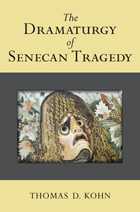 The Dramaturgy of Senecan Tragedy
Thomas D. Kohn
University of Michigan Press, 2013 The first-century Roman tragedies of Seneca, like all ancient drama, do not contain the sort of external stage directions that we are accustomed to today; nevertheless, a careful reading of the plays reveals such stage business as entrances, exits, setting, sound effects, emotions of the characters, etc. The Dramaturgy of Senecan Tragedy teases out these dramaturgical elements in Seneca's work and uses them both to aid in the interpretation of the plays and to show the playwright's artistry. Thomas D. Kohn provides a detailed overview of the corpus, laying the groundwork for appreciating Seneca's techniques in the individual dramas. Each of the chapters explores an individual tragedy in detail, discussing the dramatis personae and examining how the roles would be distributed among a limited number of actors, as well as the identity of the Chorus. The Dramaturgy of Senecan Tragedymakes a compelling argument for Seneca as an artist and a dramaturg in the true sense of the word: "a maker of drama." Regardless of whether Seneca composed his plays for full-blown theatrical staging, a fictive theater of the mind, or something in between, Kohn demonstrates that he displays a consistency and a careful attentiveness to details of performance. While other scholars have applied this type of performance criticism to individual tragedies or scenes, this is the first comprehensive study of all the plays in twenty-five years, and the first ever to consider not just stagecraft, but also metatheatrical issues such as the significant distribution of roles among a limited number of actors, in addition to the emotional states of the characters. Scholars of classics and theater, along with those looking to stage the plays, will find much of interest in this study.
Drawing -- The Process
Edited by Jo Davies and Leo Duff
Intellect Books, 2005 Drawing - The Process is a collection of papers, theories and interviews based on the conference and exhibition of the same name held at Kingston University in 2003. Much debate and research is currently undertaken in this area and it is the intention of the book to galvanize this, while providing a vehicle for deep enquiry. The publication will firstly comprise a collection of refereed papers representing a breadth of activity and research around the issues of drawing within the broad context of art and design activity. The second dimension of the book will be an examination of the drawing processes of high profile practitioners.
The publication will encompass the best contemporary investigation of a subject pivotal to art and design activity, and should be recognized as a fundamental text for students at both undergraduate and postgraduate levels.
 Drawing as a Way of Knowing in Art and Science
Gemma Anderson
Intellect Books, 2017 In recent history, the arts and sciences have often been considered opposing fields of study, but a growing trend in drawing research is beginning to bridge this divide. Gemma Anderson’s Drawing as a Way of Knowing in Art and Science introduces tested ways in which drawing as a research practice can enhance morphological insight, specifically within the natural sciences, mathematics, and art.
Inspired and informed by collaboration with contemporary scientists and Goethe’s studies of morphology, as well as the work of artist Paul Klee, this book presents drawing as a means of developing and disseminating knowledge, and of understanding and engaging with the diversity of natural and theoretical forms, such as animal, vegetable, mineral, and four dimensional shapes. Anderson shows that drawing can offer a means of scientific discovery and can be integral to the creation of new knowledge in science as well as in the arts.
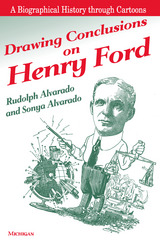 Drawing Conclusions on Henry Ford
Rudolph Alvarado and Sonya Alvarado
University of Michigan Press, 2001 For years political cartoons have shaped the often unflattering popular view of public figures. One of the most-often-portrayed figures of the twentieth century was the automobile manufacturer Henry Ford. Through editorial drawings, a vivid picture of Ford was presented that became the source of myths that surrounded him and continue even to this day. Drawing Conclusions on Henry Ford is the first and only collection that brings together in one volume these editorial cartoons. They date back as far as the time Ford introduced the Model T in 1908 and extend forward to the introduction of the Model A and subsequent V8 engines in the 1930s. They illustrate the emergence of many of the popular myths surrounding Henry Ford, as seen and understood by the average citizen during the opening decades of the twentieth century. With 150 illustrations, the reader is able to trace the evolving images of Ford from a time period when caricature images of public figures were a primary source of information about those persons. Sometimes funny, sometimes sharp and critical, these cartoons are entertaining in themselves. Viewed as a whole, they create anew view of the Henry Ford story. Rudolph V. Alvarado is a freelance writer and museum consultant, as well as the former programs leader for the Henry Ford Museum and Greenfield Village. Sonya Y. Alvarado is an instructor of English, at Eastern Michigan University and a former adjunct faculty member, Wayne State University.
 Drawing in the Design Process: Characterising Industrial and Educational Practice
Pamela Schenk
Intellect Books, 2016 In the early days of the digital revolution in graphic design, many designers and teachers of design were convinced that the era of drawing on paper was over—that there would soon no longer be a place for craft-based drawing at any stage of the design process.
It soon became apparent, however, that technological progress had not obviated the inherent value of drawing, and that, in fact, it opened up new avenues for convergent and hybrid drawing practices. This book traces the evolution of design-based drawing through analysis of a series of research projects from the 1980s to recent years that have sought to characterize the changing practices of design within various industries. Built on more than three hundred interviews with designers, academics, and design students, and an exhaustive analysis of thousands of drawings, it aims to generate discussion around historical and contemporary models of the design process.
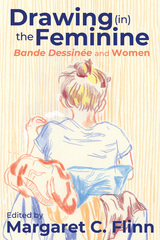 Drawing (in) the Feminine: Bande Dessinée and Women
Edited by Margaret C. Flinn
Ohio State University Press, 2024 Winner, Eisner Award for Best Academic/Scholarly Work 2025
Finalist, Comics Studies Society Edited Book Prize 2025
Drawing (in) the Feminine celebrates and examines the richness of contemporary women's production in French and Francophone comics art and considers the history of representations made by both dominant and marginalized creators. Bridging historical and contemporary comics output, these essays illuminate the interfaces among genre, gender, and cultural history. Contributors from both sides of the Atlantic, and across a variety of methodologies and disciplinary orientations, challenge prevailing claims about the absence of women creators, characters, and readers in bande dessinée, arguing that women have always been part of its history. While still far from achieving parity with their male counterparts, female creators are occupying an increasingly significant portion of the French-language comics publishing industry, and creators of all genders are putting forth stories that reflect on the diversity and richness of women's and gender-nonconforming people's experiences. In the essays collected here, contributors push back against the ways in which the marginalization of women within bande dessinée history has overshadowed their significant contributions, extending avenues for further exploring the true diversity of a flourishing contemporary production. Contributors: Armelle Blin-Rolland, Véronique Bragard, Michelle Bumatay, Benoît Crucifix, Isabelle Delorme, Jacques Dürrenmatt, Margaret C. Flinn, Alexandra Gueydan-Turek, Jennifer Howell, Jessica Kohn, Sylvain Lesage, Catriona MacLeod, Mark McKinney
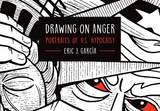 Drawing on Anger: Portraits of U.S. Hypocrisy
Eric J. García
Ohio State University Press, 2018 Drawing on Anger: Portraits of U.S. Hypocrisy is a collection of Eric J. García’s most unabashed political cartoons about U.S. history and politics from 2004 to the present. They offer a scathing indictment of Republicans, Democrats, and the self-proclaimed greatest country on earth. Garcia reconstructs pivotal moments in history—such as U.S. complicity in the disappearance of forty-three Mexican students, genocide and torture in Iraq, and femicide along the U.S.—Mexico border—and reflects on the larger themes of anti-immigration laws, global imperialism, veterans affairs, and the conquest of the Americas. His cartoons are equally critical of both political parties and of both the United States and Mexico–lobbing criticism and satire in every direction.
For over a decade García has been serving up inked visuals with the sharpest of political critiques through a Chicano lens. If you’re looking for funny punch lines, these aren’t the cartoons for you. But if you want to pull down Uncle Sam’s pants and see what’s really going on, this is your book.
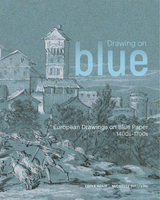 Drawing on Blue: European Drawings on Blue Paper, 1400s–1700s
Edina Adam
J. Paul Getty Trust, The, 2024 This engaging book highlights the role of blue paper in the history of drawing.
The rich history of blue paper, from the late fifteenth to the mid-eighteenth centuries, illuminates themes of transcultural interchange, international trade, and global reach. Through the examination of significant works, this volume investigates considerations of supply, use, economics, and innovative creative practice. How did the materials necessary for the production of blue paper reach artistic centers? How were these materials produced and used in various regions? Why did they appeal to artists, and how did they impact artistic practice and come to be associated with regional artistic identities? How did commercial, political, and cultural relations, and the mobility of artists, enable the dispersion of these materials and related techniques? Bringing together the work of the world’s leading specialists, this striking publication is destined to become essential reading on the history, materials, and techniques of drawings executed on blue paper.
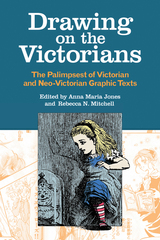 Drawing on the Victorians: The Palimpsest of Victorian and Neo-Victorian Graphic Texts
Anna Maria Jones
Ohio University Press, 2017 Late nineteenth-century Britain experienced an unprecedented explosion of visual print culture and a simultaneous rise in literacy across social classes. New printing technologies facilitated quick and cheap dissemination of images—illustrated books, periodicals, cartoons, comics, and ephemera—to a mass readership. This Victorian visual turn prefigured the present-day impact of the Internet on how images are produced and shared, both driving and reflecting the visual culture of its time. From this starting point, Drawing on the Victorians sets out to explore the relationship between Victorian graphic texts and today’s steampunk, manga, and other neo-Victorian genres that emulate and reinterpret their predecessors. Neo-Victorianism is a flourishing worldwide phenomenon, but one whose relationship with the texts from which it takes its inspiration remains underexplored. In this collection, scholars from literary studies, cultural studies, and art history consider contemporary works—Alan Moore’s League of Extraordinary Gentlemen, Moto Naoko’s Lady Victorian, and Edward Gorey’s Gashlycrumb Tinies, among others—alongside their antecedents, from Punch’s 1897 Jubilee issue to Alice in Wonderland and more. They build on previous work on neo-Victorianism to affirm that the past not only influences but converses with the present. Contributors: Christine Ferguson, Kate Flint, Anna Maria Jones, Linda K. Hughes, Heidi Kaufman, Brian Maidment, Rebecca N. Mitchell, Jennifer Phegley, Monika Pietrzak-Franger, Peter W. Sinnema, Jessica Straley
 Drawing Processes of Life: Molecules, Cells, Organisms
Edited by Gemma Anderson-Tempini and John Dupré
Intellect Books, 2023 How the challenge of depicting biological systems can generate productive questions for artists and scientists.
An artist sketching cell division faces a problem: what is the best way to visually represent a dynamic process? This anthology, edited by an artist and a philosopher of science, explores drawing as a way of inquiring into living processes at the molecular, cellular, and organismal scale. In doing so, drawing emerges as a tool for relaying and uncovering knowledge—a pathway for research, not an end result.
Incorporating drawing studies and contributions from scholars in the humanities and life sciences, Drawing Processes of Life addresses epigenetics, epistemology, and metamorphosis in insects, proteins, and other ever-shifting biological systems. A foreword by Scott F. Gilbert, a renowned evolutionary biologist and historian of science, affirms the promise of interdisciplinary collaboration between artists and scientists.
Drawing: The Enactive Evolution of the Practitioner
Patricia Cain
Intellect Books, 2010 Despite recent technological changes that have digitized many forms of artistic creation, the practice of drawing, in the traditional sense, has remained constant. However, many publications about this subject rely on discipline-dependent distinctions to discuss the activity’s function. Drawing: The Enactive Evolution of the Practitioner redefines drawing more holistically as an enactive phenomenon, one reliant on motor responses, and makes connections between a variety of disciplines in order to find out what happens when we draw. Instead of the finite event of producing an artifact, drawing is a process and an end in itself. By synthesizing enactive thinking and the practice of drawing, this volume provides valuable insights into the creative mind, and will appeal to scholars and practitioners alike.
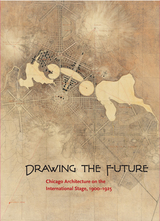 Drawing the Future: Chicago Architecture on the International Stage, 1900-1925
David Van Zanten
Northwestern University Press, 2013 Drawing the Future: Chicago Architecture on the International Stage, 1900–1925 is an illustrated catalog with companion essays for an exhibition of the same name at the Mary and Leigh Block Museum of Art at Northwestern University. Drawing the Future explores the creative ferment among Chicago architects in the early twentieth century, coinciding with similar visions around the world. The essays focus on the highlights of the exhibition. David Van Zanten profiles Walter Burley Griffin and Marion Mahony Griffin, Chicago architects who created an influential, prize-winning plan for Canberra, the new capital of Australia. Ashley Dunn looks at the two exhibits at the Musée des Arts Décoratifs in Paris, one devoted to the Griffins in 1914 and the other to the French architect Tony Garnier in 1925, demonstrating the impact of World War I on city planning and architecture. Leslie Coburn examines Chicago’s Neighborhood Center Competition of 1914–15, which sought to redress gaps in Daniel Burnham’s plan of 1909. The ambition and reach of Chicago architecture in this epoch would have lasting influence on cities of the future.
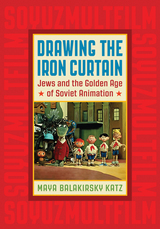 Drawing the Iron Curtain: Jews and the Golden Age of Soviet Animation
Maya Balakirsky Katz
Rutgers University Press, 2016 In the American imagination, the Soviet Union was a drab cultural wasteland, a place where playful creative work and individualism was heavily regulated and censored. Yet despite state control, some cultural industries flourished in the Soviet era, including animation. Drawing the Iron Curtain tells the story of the golden age of Soviet animation and the Jewish artists who enabled it to thrive. Art historian Maya Balakirsky Katz reveals how the state-run animation studio Soyuzmultfilm brought together Jewish creative personnel from every corner of the Soviet Union and served as an unlikely haven for dissidents who were banned from working in other industries. Surveying a wide range of Soviet animation produced between 1919 and 1989, from cutting-edge art films like Tale of Tales to cartoons featuring “Soviet Mickey Mouse” Cheburashka, she finds that these works played a key role in articulating a cosmopolitan sensibility and a multicultural vision for the Soviet Union. Furthermore, she considers how Jewish filmmakers used animation to depict distinctive elements of their heritage and ethnic identity, whether producing films about the Holocaust or using fellow Jews as models for character drawings. Providing a copiously illustrated introduction to many of Soyuzmultfilm’s key artistic achievements, while revealing the tumultuous social and political conditions in which these films were produced, Drawing the Iron Curtain has something to offer animation fans and students of Cold War history alike.
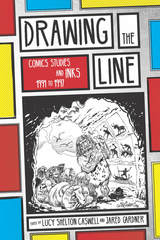 Drawing the Line: Comics Studies and INKS, 1994–1997
Lucy Shelton Caswell and Jared Gardner
Ohio State University Press, 2017 Drawing the Line: Comics Studies and INKS, 1994–1997 collects some of the most important essays from INKS: Cartoon and Comic Art Studies, the first peer-reviewed scholarly journal devoted exclusively to comics studies. The volume, edited by Lucy Shelton Caswell, the journal’s founding editor, and Jared Gardner, editor of the new Inks: The Journal of the Comics Studies Society, celebrates this foundational moment in the fast-growing field of comics studies and also serves as a call to contemporary scholars to revisit the roads-not-taken mapped out by these scholars and cartoonist critics.
Included in the volume are essays by pioneering comics scholars on newspaper comic strips, Japanese manga, Chinese lianhuanhua, comic books, graphic novels, and editorial cartoons, alongside writings and artwork by celebrated cartoonists such as Will Eisner, Oliver Harrington, Charles Schulz, and Frank Stack. This volume serves as an invaluable resource for anyone interested in the history and study of the comics form, visual culture, or the history of journalism.
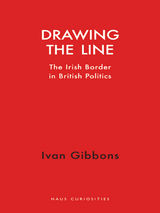 Drawing the Line: The Irish Border in British Politics
Ivan Gibbons
Haus Publishing, 2017 Though once a source of violent conflict, the border dividing the Republic of Ireland from Northern Ireland has been relatively stable in recent years. The border’s creation in 1921 exacerbated hostile relations between Ireland and Britain in the subsequent decades, hostility that frequently broke out into violent conflict until the breakthrough Good Friday Agreement of 1998. That landmark policy declared that there will be no change in the status of the border unless there is a majority decision in Northern Ireland in favor, and the relaxation in tensions it brought has been hailed as one of the great breakthroughs for peace in our era. Now, however, as the UK prepares to leave the European Union in 2019, the Irish border is once again a hot-button issue and pivotal to any settlement reached. To enable a fuller understanding of this open question, Drawing the Line provides a concise explanation of the current controversy by sketching it in its full historical context.
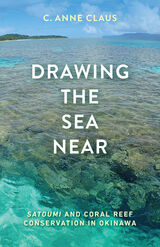 Drawing the Sea Near: Satoumi and Coral Reef Conservation in Okinawa
C. Anne Claus
University of Minnesota Press, 2020 How Japanese coastal residents and transnational conservationists collaborated to foster relationships between humans and sea life
Drawing the Sea Near opens a new window to our understanding of transnational conservation by investigating projects in Okinawa shaped by a “conservation-near” approach—which draws on the senses, the body, and memory to collapse the distance between people and their surroundings and to foster collaboration and equity between coastal residents and transnational conservation organizations. This approach contrasts with the traditional Western “conservation-far” model premised on the separation of humans from the environment. Based on twenty months of participant observation and interviews, this richly detailed, engagingly written ethnography focuses on Okinawa’s coral reefs to explore an unusually inclusive, experiential, and socially just approach to conservation. In doing so, C. Anne Claus challenges orthodox assumptions about nature, wilderness, and the future of environmentalism within transnational organizations. She provides a compelling look at how transnational conservation organizations—in this case a field office of the World Wide Fund for Nature in Okinawa—negotiate institutional expectations for conservation with localized approaches to caring for ocean life. In pursuing how particular projects off the coast of Japan unfolded, Drawing the Sea Near illuminates the real challenges and possibilities of work within the multifaceted transnational structures of global conservation organizations. Uniquely, it focuses on the conservationists themselves: why and how has their approach to project work changed, and how have they themselves been transformed in the process?
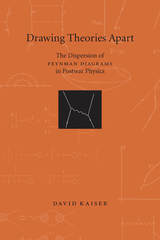 Drawing Theories Apart: The Dispersion of Feynman Diagrams in Postwar Physics
David Kaiser
University of Chicago Press, 2005 Winner of the 2007 Pfizer Prize from the History of Science Society. Feynman diagrams have revolutionized nearly every aspect of theoretical physics since the middle of the twentieth century. Introduced by the American physicist Richard Feynman (1918-88) soon after World War II as a means of simplifying lengthy calculations in quantum electrodynamics, they soon gained adherents in many branches of the discipline. Yet as new physicists adopted the tiny line drawings, they also adapted the diagrams and introduced their own interpretations. Drawing Theories Apart traces how generations of young theorists learned to frame their research in terms of the diagrams—and how both the diagrams and their users were molded in the process.
Drawing on rich archival materials, interviews, and more than five hundred scientific articles from the period, Drawing Theories Apart uses the Feynman diagrams as a means to explore the development of American postwar physics. By focusing on the ways young physicists learned new calculational skills, David Kaiser frames his story around the crafting and stabilizing of the basic tools in the physicist's kit—thus offering the first book to follow the diagrams once they left Feynman's hands and entered the physics vernacular.
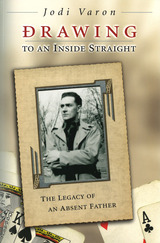 Drawing to an Inside Straight: The Legacy of an Absent Father
Jodi Varon
University of Missouri Press, 2006
Life can sometimes hinge on the turn of a card—not only the gambler’s life but also the lives of those close to him. For Jodi Varon, one fateful turn changed her father’s life—propelling her into a search far from home that will lead readers to a new contemplation of family ties and lost cultural legacies.
Benjamin Varon never rode a horse and preferred his beef hanging in a cooler, but he still thought of himself as a cattleman—that is, until he disappeared after losing his meat-supply business in a high-stakes poker game. In recalling how a hardscrabble New Yorker sought his fortune in Colorado’s cattle country, Varon also relates a daughter’s quest to understand and forgive.
Drawing to an Inside Straight is a bittersweet story of growing up in Denver during the 1960s. As Varon recalls life at home with parents Benjamin and Irene—Jews of decidedly different backgrounds, he a Ladino-speaking Sephardi from New York, she a Yiddish-speaking Ashkenazi from Denver’s close-knit Jewish community—she tells of a childhood nourished by pireshkes and cronson, hamantashen and challah. These stories and other culinary delights are contrasted with her father’s childhood of stolen fruit and his longing for the aromas of the Mediterranean spice markets of his ancestors.
Against the backdrop of America in the Vietnam era, and amid tales of Joseph McCarthy’s tyranny, Burma-Shave divination, domestic nerve-gas stockpiling, suburban wife-swapping, murder, and suicide, Varon offers an intriguing look at Sephardic history and culture. Behind her own story looms that of Benjamin, who transformed himself from an immigrant’s son sneaking into Yankee Stadium, to a tough GI, to a quixotic dreamer willing to stake his hard-won business in a game of chance.
Rather than cast off his European past, Benjamin embraced it, insisted upon it, tried to celebrate what was different. All the while, he was dogged by his favorite Ladino adage—“We left on a horse. We came back on a donkey”—which served to remind him of the caprices of fortune that would follow him to that fateful poker game. Varon’s story of her own journey to Spain, in search of her father’s lost heritage and his adoration of the Sephardim’s Golden Age, helps seal her understanding as it heals wounds left open too long.
Varon’s account is an insightful view of what it means to be American without losing one’s past to the proverbial melting pot, with its insider’s look at Sephardic culture and depictions of Denver’s ethnic communities that challenge stereotypes of the Anglo-American West. Drawing to an Inside Straight is a book that will make an immediate connection with readers—even those whose fathers weren’t compulsive gamblers—who struggle with mixed emotions about childhood or are in search of their own roots.
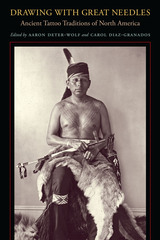 Drawing with Great Needles: Ancient Tattoo Traditions of North America
Edited by Aaron Deter-Wolf and Carol Diaz-Granados
University of Texas Press, 2013 For thousands of years, Native Americans throughout the Eastern Woodlands and Great Plains used the physical act and visual language of tattooing to construct and reinforce the identity of individuals and their place within society and the cosmos. The act of tattooing served as a rite of passage and supplication, while the composition and use of ancestral tattoo bundles was intimately related to group identity. The resulting symbols and imagery inscribed on the body held important social, civil, military, and ritual connotations within Native American society. Yet despite the cultural importance that tattooing held for prehistoric and early historic Native Americans, modern scholars have only recently begun to consider the implications of ancient Native American tattooing and assign tattooed symbols the same significance as imagery inscribed on pottery, shell, copper, and stone. Drawing with Great Needles is the first book-length scholarly examination into the antiquity, meaning, and significance of Native American tattooing in the Eastern Woodlands and Great Plains. The contributors use a variety of approaches, including ethnohistorical and ethnographic accounts, ancient art, evidence of tattooing in the archaeological record, historic portraiture, tattoo tools and toolkits, gender roles, and the meanings that specific tattoos held for Dhegiha Sioux and other Native speakers, to examine Native American tattoo traditions. Their findings add an important new dimension to our understanding of ancient and early historic Native American society in the Eastern Woodlands and Great Plains.
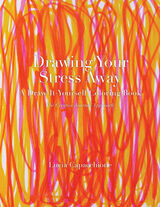 Drawing Your Stress Away: A Draw-It-Yourself Coloring Book
Lucia Capacchione
Ohio University Press, 2017 With Drawing Your Stress Away and Hello, This Is Your Body Talking, art therapist and educator Dr. Lucia Capacchione presents a new concept in adult coloring: the draw-it-yourself coloring book. Forty years ago, Capacchione originated the Creative Journal Method to help clients and students reduce stress, heal trauma, and unleash creativity. Since then, her research-based techniques have been used internationally in schools, counseling centers, support groups, addiction recovery centers, and programs for veterans. Drawing Your Stress Away and Hello, This Is Your Body Talking are a wonderful introduction to Capacchione’s methods which include drawing, coloring, and writing with the non-dominant hand to help the user shed inhibitions and rediscover the artistic spontaneity of childhood. Capacchione gently guides readers to use drawing for meditation, stress release, and self-care. In Hello, This Is Your Body Talking, simple breathing, drawing, and writing prompts encourage physical awareness and relaxation. Drawing Your Stress Away helps reduce tension through emotional expression, self-nurturing, and artistic discovery. Unlike traditional coloring books, which require fine motor control in highly detailed predetermined patterns, Capacchione’s “anti-coloring books” provide the inspiration for users to make their own art, tune out their inner critics, and take the training wheels off their natural creativity.
Drawn to the Word: The Bible and Graphic Design
Amanda Dillon
SBL Press, 2021 A unique study of lectionaries and graphic design as a site of biblical reception
How artists portrayed the Bible in large canvas paintings is frequently the subject of scholarly exploration, yet the presentation of biblical texts in contemporary graphic designs has been largely ignored. In this book Amanda Dillon engages multimodal analysis, a method of semiotic discourse, to explore how visual composition, texture, color, directionality, framing, angle, representations, and interactions produce potential meanings for biblical graphic designs. Dillon focuses on the artworks of two American graphic designers—the woodcuts designed by Meinrad Craighead for the Roman Catholic Sunday Missal and Nicholas Markell’s illustrations for the worship books of the Evangelical Lutheran Church in America—to present the merits of multimodal analysis for biblical reception history.
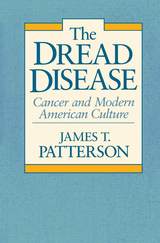 The Dread Disease: Cancer and Modern American Culture
James T. Patterson
Harvard University Press, 1987 Cancer is that “loathsome beast, which seized upon the breast, drove its long claws into the surrounding tissues, derived its sustenance by sucking out the juices of its victims, and never even relaxed its hold in death,” a turn-of-the-century physician recorded. Even today cancer affects the popular imagination with dread. In a subtle and penetrating cultural history, James Patterson examines reactions to the disease through a century of American life.
The modern American preoccupation with cancer was apparent during the widely publicized illness and death from that ailment of Ulysses S. Grant in 1885. Awareness of the disease soon figured heavily in the public consciousness, and individual reactions to it continue to reveal broader tensions within American society. Patterson examines responses to cancer by researchers and physicians, quacks and faith healers, by the multitude who have heard sensational media reports of “cures,” as well as by many who have had firsthand experiences with the disease.
Optimistic attitudes of many experts contrast sharply with the skepticism of large segments of the population—often the less wealthy and the less educated—that reject the claims of medical science and resist the advice or, some argue, the paternalistic dictates of the government-supported cancer research establishment.
Expanding expectations of a cure from a confident medical profession; the rise of a government-supported Cancer Establishment managing a large research empire; the emergence of a “cancer counterculture”; a new emphasis on prevention through control of the environment and the self; and the private fears and pessimism of millions of Americans form a telling history of American social patterns. Whether the issue is smoking, pollution, or regular checkups, attitudes toward cancer reflect more general views on medicine, public policy, and illness, as well as on death and dying. This century has witnessed both a biomedical revolution and a vastly increased role of the state in the private lives of citizens; but not everyone has bought the medical package, and many have little faith in government intervention.
Readers interested in the cultural dimensions of science and medicine as well as historians, sociologists, and political scientists will be enlightened and challenged by The Dread Disease.
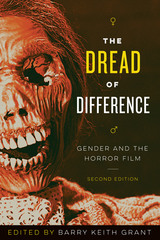 The Dread of Difference: Gender and the Horror Film
Edited by Barry Keith Grant
University of Texas Press, 2015 “The Dread of Difference is a classic. Few film studies texts have been so widely read and so influential. It’s rarely on the shelf at my university library, so continuously does it circulate. Now this new edition expands the already comprehensive coverage of gender in the horror film with new essays on recent developments such as the Hostel series and torture porn. Informative and enlightening, this updated classic is an essential reference for fans and students of horror movies.”—Stephen Prince, editor of The Horror Film and author of Digital Visual Effects in Cinema: The Seduction of Reality “An impressive array of distinguished scholars . . . gazes deeply into the darkness and then forms a Dionysian chorus reaffirming that sexuality and the monstrous are indeed mated in many horror films.”—Choice “An extremely useful introduction to recent thinking about gender issues within this genre.”—Film Theory
 Dread Poetry and Freedom: Linton Kwesi Johnson and the Unfinished Revolution
David Austin
Pluto Press, 2018 What is the relationship between poetry and social change?
Standing at the forefront of political poetry since the 1970s, Linton Kwesi Johnson has been fighting neo-fascism, police violence and promoting socialism while putting pen to paper to refute W.H. Auden's claim that 'poetry makes nothing happen'. For Johnson, only the second living poet to have been published in the Penguin Modern Classics series, writing has always been 'a political act' and poetry 'a cultural weapon'.
In Dread Poetry and Freedom - the first book dedicated to the work of this 'political poet par excellence' - David Austin explores the themes of poetry, political consciousness and social transformation through the prism of Johnson's work. Drawing from the Bible, reggae and Rastafari, and surrealism, socialism and feminism, and in dialogue with Aime Cesaire and Frantz Fanon, C.L.R. James and Walter Rodney, and W.E.B. Du Bois and the poetry of d'bi young anitafrika, Johnson's work becomes a crucial point of reflection on the meaning of freedom in this masterful and rich study.
In the process, Austin demonstrates why art, and particularly poetry, is a vital part of our efforts to achieve genuine social change in times of dread.
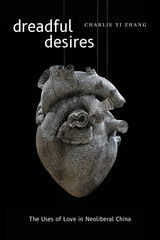 Dreadful Desires: The Uses of Love in Neoliberal China
Charlie Yi Zhang
Duke University Press, 2022 In Dreadful Desires Charlie Yi Zhang examines how the Chinese state deploys affective notions of love to regulate the population and secure China’s place in the global economy. Zhang shows how the state frames love as a set of desires that encompass heteronormative intimacy, familial and communal attachment, upward mobility, and private property ownership. These desires—as circulated in performance in the nationalistic ceremony, same-sex romantic fan fiction, the wildly popular reality television dating show If You Are the One, and the cult of patriarchal personality around Xi Jinping—are explicitly based in oppressive systems of gender, class, and sexuality. Zhang contends that such desires connect love to economic survival and gender normativity in ways that underwrite Chinese neoliberalism at the expense of individual flourishing. By outlining how state-framed forms of love create desires that cannot be fulfilled, Zhang places China at the forefront of using affective attachments to nation, leader, and family in the global shifts toward exploitation and authoritarianism.
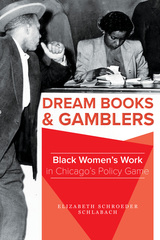 Dream Books and Gamblers: Black Women's Work in Chicago's Policy Game
Elizabeth Schroeder Schlabach
University of Illinois Press, 2022 Ubiquitous illegal lotteries known as policy flourished in Chicago’s Black community during the overlapping waves of the Great Migration. Policy “queens” owned stakes in lucrative operations while women writers and clerks canvased the neighborhood, passed out winnings, and kept the books. Elizabeth Schroeder Schlabach examines the complexities of Black women’s work in policy gambling. Policy provided Black women with a livelihood for themselves and their families. At the same time, navigating gender expectations, aggressive policing, and other hazards of the infromal economy led them to refashion ideas about Black womanhood and respectability. Policy earnings also funded above-board enterprises ranging from neighborhood businesses to philanthropic institutions, and Schlabach delves into the various ways Black women straddled the illegal policy business and reputable community involvement. Vivid and revealing, Dream Books and Gamblers tells the stories of Black women in the underground economy and how they used their work to balance the demands of living and laboring in Black Chicago.
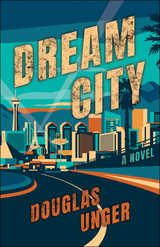 Dream City: A Novel
Douglas Unger
University of Nevada Press, 2024 In this unconventional tale of Las Vegas during the two delirious boom decades before the bust of the Great Recession, failed actor “C. D.” Reinhart, who has launched a new career in hotel marketing, is gradually losing his moral and existential compass. Working on The Strip during an era when Sin City’s population growth was outpacing any other place in America, C. D. climbs the industry ladder while modeling himself after a Pyramid Resorts top executive, Lance Sheperd. C. D.’s professional choices lead him down a tumultuous road, as Sheperd, a complex and, at times, visionary figure, pilots his ventures through the tangled wheeling and dealing of finance and corporate politics straight into catastrophe.
As the story progresses, C. D. comes to understand how his personal losses and the losses of his cohort of hard driving executives on the make—especially the tragic life of his work partner, Greta Olsson, the only woman to break through into their male dominated world—are a result of the make-believe environment he has helped to create, a world where representation replaces reality. Hoping to piece together his faltering marriage and family relationships, C. D. must find a new path as he struggles to hold onto his dreams.
In this fictionalized version of the city of glittering lights, author Douglas Unger pits the ideologies of marketing and consumerism in the casino economy of America against the erosion of individual and humane values that success in that world demands. Unger reveals the hard truth that Las Vegas, a blue-collar town considered by many to be “the most honest city,” can be a temple for self-deceptions, emblematic of a service economy that knows the price of everything and too often the value of little else. Dream City becomes both a love song and an elegy for Las Vegas that sets it apart from any other literary novel previously written about this global entertainment attraction that in so many ways represents postmodern America. Sooner or later, the challenge that faces everyone is to discover what matters most, and to learn how to bet on the better angels of our natures.
 Dream Factories of a Former Colony: American Fantasies, Philippine Cinema
José B. Capino
University of Minnesota Press, 2010 Philippine cinema, the dream factory of the former U.S. colony, teems with American figures and plots. Local movies feature GIs seeking Filipina brides, cold war spies hunting down native warlords, and American-born Filipinos wandering in the parental homeland. The American landscape furnishes the settings for the triumphs and tragedies of Filipino nurses, GI babies, and migrant workers.
By tracking American fantasies in Philippine movies from the postindependence period to the present, José B. Capino offers an innovative account of cinema's cultural work in decolonization and globalization. Capino examines how a third world nation's daydreams both articulate empire and mobilize against it, provide imaginary maps and fables of identity for its migrant workers and diasporan subjects, pose challenges to the alibis of patriarchy and nationalism, and open up paths for participating in the cultures of globality.
Through close readings of more than twenty Philippine movies, Capino demonstrates the postcolonial imagination's vital role in generating pragmatic and utopian visions of living with empire. Illuminating an important but understudied cinema, he creates a model for understanding the U.S. image in the third world.
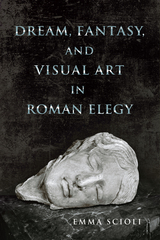 Dream, Fantasy, and Visual Art in Roman Elegy
Emma Scioli
University of Wisconsin Press, 2015 The elegists, ancient Rome’s most introspective poets, filled their works with vivid, first-person accounts of dreams. Dream, Fantasy, and Visual Art in Roman Elegy examines these varied and visually striking textual dreamscapes, arguing that the poets exploited dynamics of visual representation to allow readers to share in the intensely personal experience of dreaming.
By treating dreams as a mode for viewing, an analogy suggested by diverse ancient authors, Emma Scioli extracts new information from the poetry of Propertius, Tibullus, and Ovid about the Roman concept of “seeing” dreams. Through comparison with other visual modes of description, such as ekphrasis and simile, as well as with related types of visual experience, such as fantasy and voyeurism, Scioli demonstrates similarities between artist, dreamer, and poet as creators, identifying the dreamer as a particular type of both viewer and narrator.
|
|
